UNITED STATES
SECURITIES AND EXCHANGE COMMISSION
Washington, D.C. 20549
FORM 6-K
REPORT OF FOREIGN ISSUER
PURSUANT TO RULE 13a-16 OR 15d-16
OF THE SECURITIES EXCHANGE ACT OF 1934
For the Month of July 2023
(Commission File No. 001-41636)
Oculis Holding AG
(Translation of registrant’s name into English)
Bahnhofstrasse 7
CH-6300
Zug, Switzerland
(Address of registrant’s principal executive office)
Indicate by check mark whether the registrant files or will file annual reports under cover of Form 20-F or Form 40-F.
Form 20-F ☒ Form 40-F ☐
INFORMATION CONTAINED IN THIS REPORT ON FORM 6-K
On July 11, 2023, Oculis Holding AG (the “Registrant”) held a R&D Day: Retina, and gave a presentation regarding updates on its clinical programs, including with respect to its OCS-01 diabetic macular edema (DME) DIAMOND program: the recent stage 1 read-out of the DIAMOND trial and plans for the upcoming DIAMOND 1 and DIAMOND 2 trials, its OCS-01 LEOPARD trial: an investigator-led study to assess safety and efficacy of OCS-01 in uveitic and post-surgical macular edema, and its OCS-05 ACUITY trial: a first-in-patient trial in France to assess safety of OCS-05 for treatment of acute optic neuritis. The presentation is attached hereto as Exhibit 99.1 and is incorporated by reference herein.
The information contained in this Form 6-K, including Exhibit 99.1, is intended to be furnished and shall not be deemed “filed” for purposes of Section 18 of the Securities Exchange Act of 1934, as amended (the “Exchange Act”), or otherwise subject to the liabilities of that section, nor shall it be deemed incorporated by reference in any filing under the Securities Act of 1933 or the Exchange Act, except as expressly set forth by specific reference in such filing.
EXHIBIT INDEX
| Exhibit | Description |
|
| 99.1 | Presentation dated July 11, 2023 | |
SIGNATURES
Pursuant to the requirements of the Securities Exchange Act of 1934, the registrant has duly caused this report to be signed on its behalf by the undersigned, thereunto duly authorized.
| OCULIS HOLDING AG | ||||||
| Date: July 12, 2023 | By: | /s/ Sylvia Cheung |
||||
| Sylvia Cheung Chief Financial Officer |
||||||
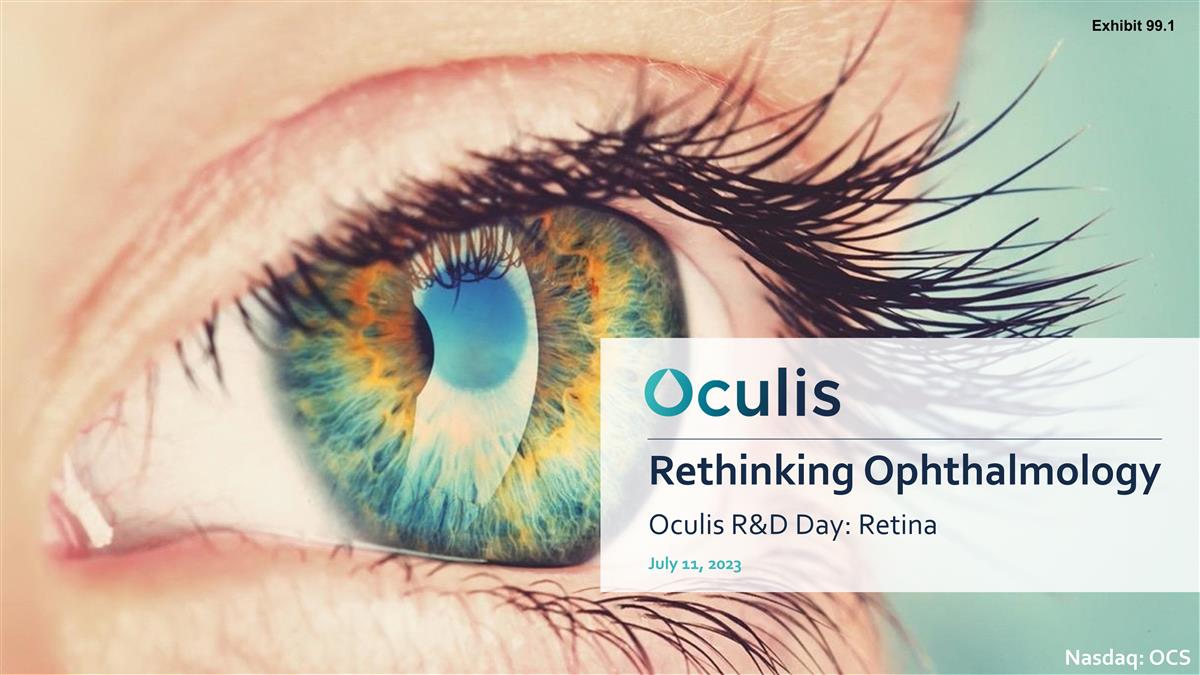
Oculis R&D Day: Retina July 11, 2023 Rethinking Ophthalmology Nasdaq: OCS Exhibit 99.1
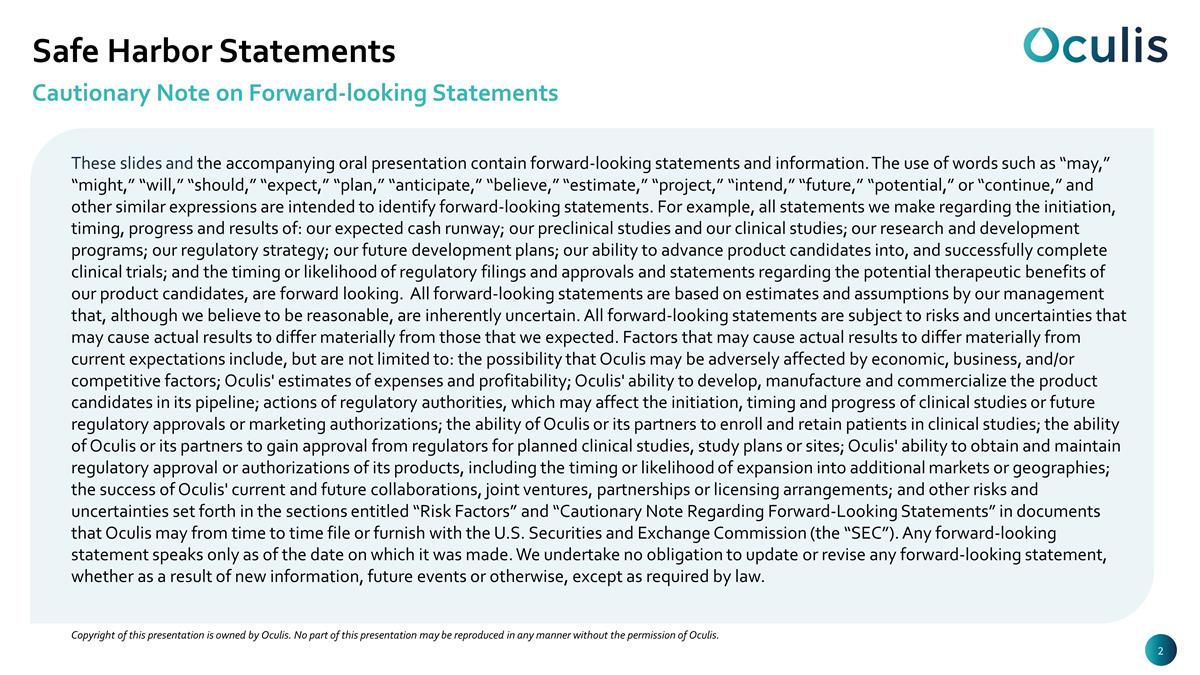
These slides and the accompanying oral presentation contain forward-looking statements and information. The use of words such as “may,” “might,” “will,” “should,” “expect,” “plan,” “anticipate,” “believe,” “estimate,” “project,” “intend,” “future,” “potential,” or “continue,” and other similar expressions are intended to identify forward-looking statements. For example, all statements we make regarding the initiation, timing, progress and results of: our expected cash runway; our preclinical studies and our clinical studies; our research and development programs; our regulatory strategy; our future development plans; our ability to advance product candidates into, and successfully complete clinical trials; and the timing or likelihood of regulatory filings and approvals and statements regarding the potential therapeutic benefits of our product candidates, are forward looking. All forward-looking statements are based on estimates and assumptions by our management that, although we believe to be reasonable, are inherently uncertain. All forward-looking statements are subject to risks and uncertainties that may cause actual results to differ materially from those that we expected. Factors that may cause actual results to differ materially from current expectations include, but are not limited to: the possibility that Oculis may be adversely affected by economic, business, and/or competitive factors; Oculis' estimates of expenses and profitability; Oculis' ability to develop, manufacture and commercialize the product candidates in its pipeline; actions of regulatory authorities, which may affect the initiation, timing and progress of clinical studies or future regulatory approvals or marketing authorizations; the ability of Oculis or its partners to enroll and retain patients in clinical studies; the ability of Oculis or its partners to gain approval from regulators for planned clinical studies, study plans or sites; Oculis' ability to obtain and maintain regulatory approval or authorizations of its products, including the timing or likelihood of expansion into additional markets or geographies; the success of Oculis' current and future collaborations, joint ventures, partnerships or licensing arrangements; and other risks and uncertainties set forth in the sections entitled “Risk Factors” and “Cautionary Note Regarding Forward-Looking Statements” in documents that Oculis may from time to time file or furnish with the U.S. Securities and Exchange Commission (the “SEC”). Any forward-looking statement speaks only as of the date on which it was made. We undertake no obligation to update or revise any forward-looking statement, whether as a result of new information, future events or otherwise, except as required by law. Copyright of this presentation is owned by Oculis. No part of this presentation may be reproduced in any manner without the permission of Oculis. Safe Harbor Statements Cautionary Note on Forward-looking Statements
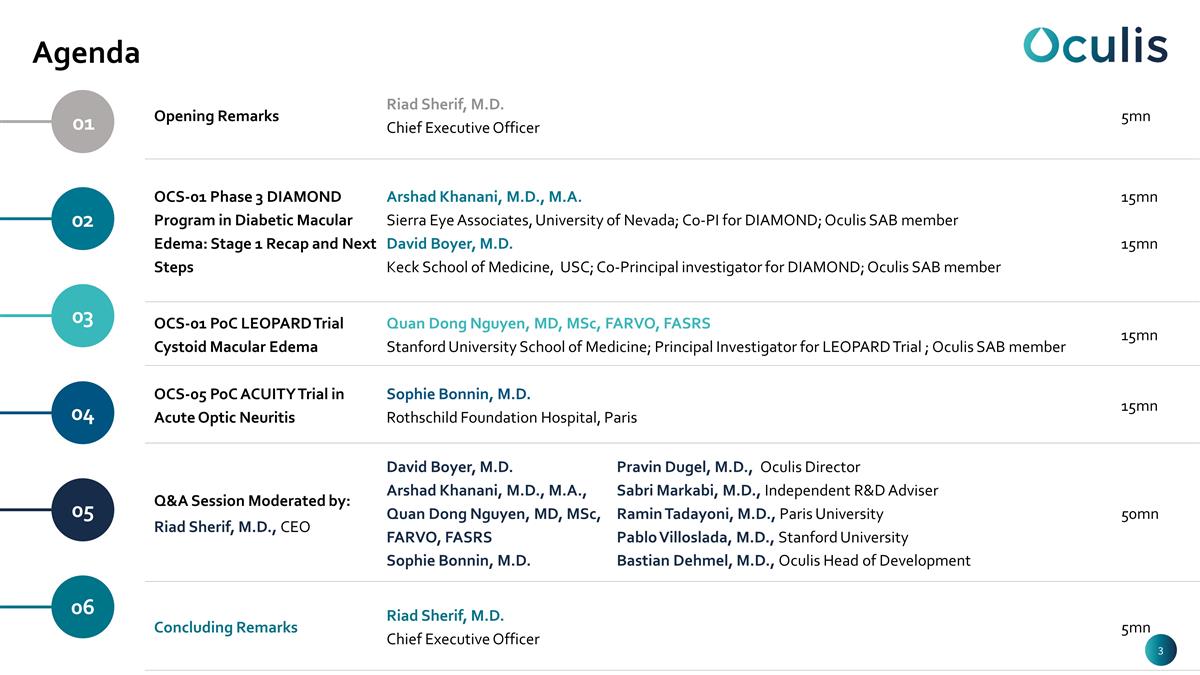
Agenda Opening Remarks Riad Sherif, M.D. Chief Executive Officer 5mn OCS-01 Phase 3 DIAMOND Program in Diabetic Macular Edema: Stage 1 Recap and Next Steps Arshad Khanani, M.D., M.A. Sierra Eye Associates, University of Nevada; Co-PI for DIAMOND; Oculis SAB member David Boyer, M.D. Keck School of Medicine, USC; Co-Principal investigator for DIAMOND; Oculis SAB member 15mn 15mn OCS-01 PoC LEOPARD Trial Cystoid Macular Edema Quan Dong Nguyen, MD, MSc, FARVO, FASRS Stanford University School of Medicine; Principal Investigator for LEOPARD Trial ; Oculis SAB member 15mn OCS-05 PoC ACUITY Trial in Acute Optic Neuritis Sophie Bonnin, M.D. Rothschild Foundation Hospital, Paris 15mn Q&A Session Moderated by: Riad Sherif, M.D., CEO David Boyer, M.D. Arshad Khanani, M.D., M.A., Quan Dong Nguyen, MD, MSc, FARVO, FASRS Sophie Bonnin, M.D. Pravin Dugel, M.D., Oculis Director Sabri Markabi, M.D., Independent R&D Adviser Ramin Tadayoni, M.D., Paris University Pablo Villoslada, M.D., Stanford University Bastian Dehmel, M.D., Oculis Head of Development 50mn Concluding Remarks Riad Sherif, M.D. Chief Executive Officer 5mn 01 02 03 04 05 06
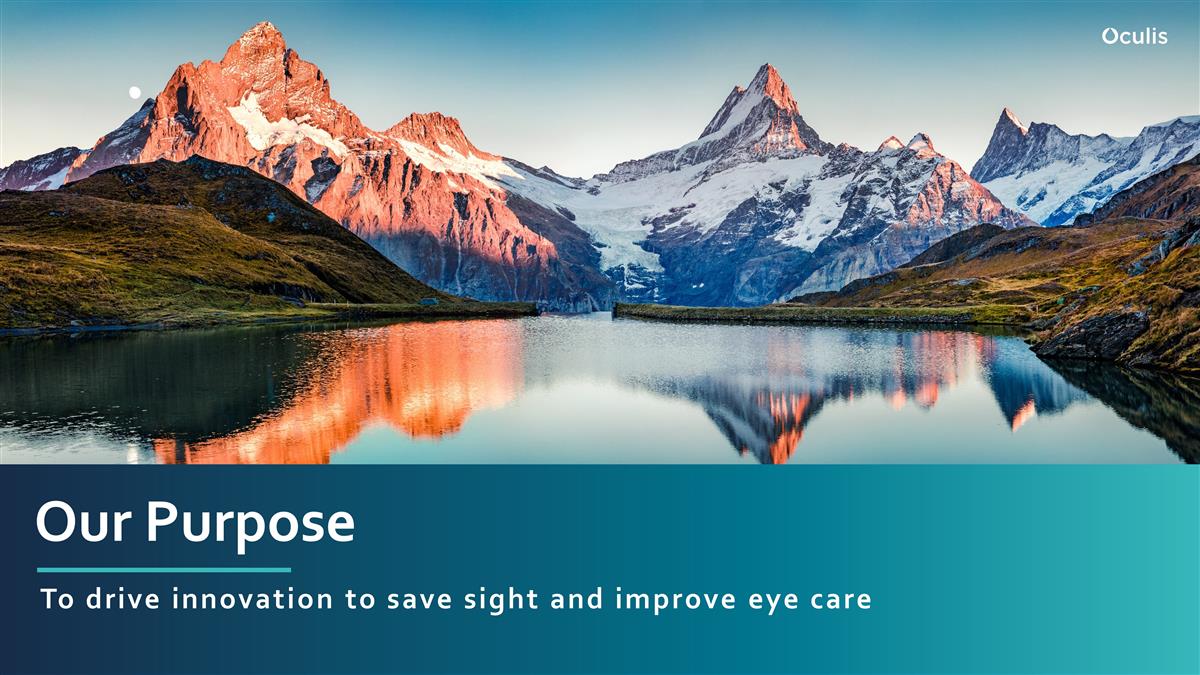
To drive innovation to save sight and improve eye care Our Purpose
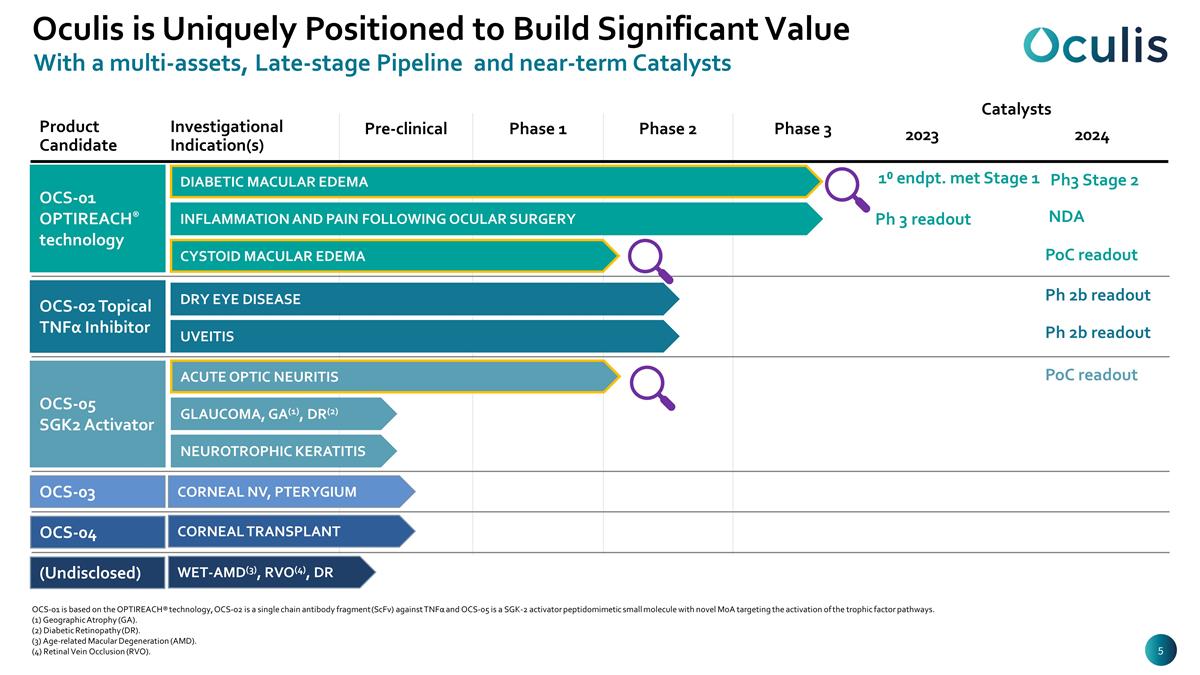
2023 2024 OCS-01 is based on the OPTIREACH® technology, OCS-02 is a single chain antibody fragment (ScFv) against TNFα and OCS-05 is a SGK-2 activator peptidomimetic small molecule with novel MoA targeting the activation of the trophic factor pathways. (1) Geographic Atrophy (GA). (2) Diabetic Retinopathy (DR). (3) Age-related Macular Degeneration (AMD). (4) Retinal Vein Occlusion (RVO). Product Candidate Investigational Indication(s) Pre-clinical Phase 1 Phase 2 Phase 3 OCS-01 OPTIREACH® technology OCS-02 Topical TNFα Inhibitor OCS-05 SGK2 Activator OCS-03 (Undisclosed) DIABETIC MACULAR EDEMA INFLAMMATION AND PAIN FOLLOWING OCULAR SURGERY DRY EYE DISEASE UVEITIS ACUTE OPTIC NEURITIS CORNEAL NV, PTERYGIUM WET-AMD(3), RVO(4), DR GLAUCOMA, GA(1), DR(2) OCS-04 CORNEAL TRANSPLANT CYSTOID MACULAR EDEMA Oculis is Uniquely Positioned to Build Significant Value Catalysts NEUROTROPHIC KERATITIS 1⁰ endpt. met Stage 1 Ph 3 readout NDA PoC readout Ph 2b readout Ph 2b readout PoC readout With a multi-assets, Late-stage Pipeline and near-term Catalysts Ph3 Stage 2
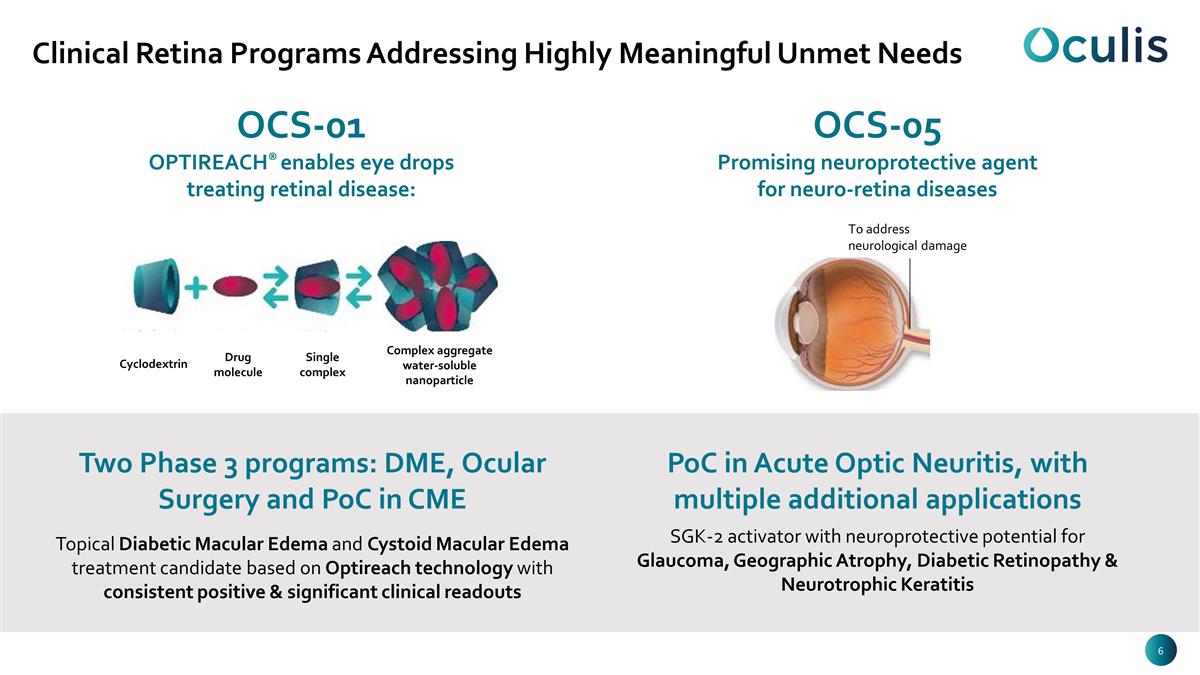
OCS-01 OPTIREACH® enables eye drops treating retinal disease: Two Phase 3 programs: DME, Ocular Surgery and PoC in CME Topical Diabetic Macular Edema and Cystoid Macular Edema treatment candidate based on Optireach technology with consistent positive & significant clinical readouts OCS-05 Promising neuroprotective agent for neuro-retina diseases PoC in Acute Optic Neuritis, with multiple additional applications SGK-2 activator with neuroprotective potential for Glaucoma, Geographic Atrophy, Diabetic Retinopathy & Neurotrophic Keratitis Cyclodextrin Drug molecule Single complex Complex aggregate water-soluble nanoparticle To address neurological damage Clinical Retina Programs Addressing Highly Meaningful Unmet Needs
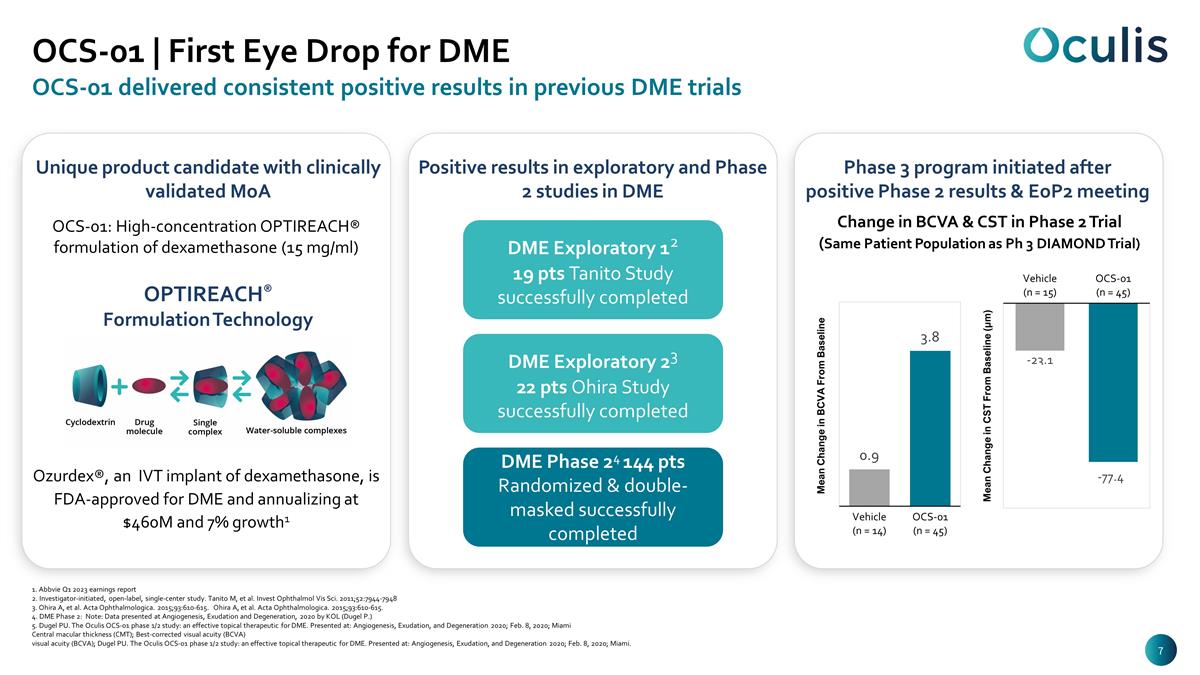
OCS-01 delivered consistent positive results in previous DME trials DME Exploratory 12 19 pts Tanito Study successfully completed DME Phase 24 144 pts Randomized & double-masked successfully completed DME Exploratory 23 22 pts Ohira Study successfully completed Positive results in exploratory and Phase 2 studies in DME Unique product candidate with clinically validated MoA Phase 3 program initiated after positive Phase 2 results & EoP2 meeting OCS-01: High-concentration OPTIREACH® formulation of dexamethasone (15 mg/ml) Change in BCVA & CST in Phase 2 Trial (Same Patient Population as Ph 3 DIAMOND Trial) OPTIREACH® Formulation Technology Ozurdex®, an IVT implant of dexamethasone, is FDA-approved for DME and annualizing at $460M and 7% growth1 Mean Change in BCVA From Baseline Mean Change in CST From Baseline (μm) 1. Abbvie Q1 2023 earnings report 2. Investigator-initiated, open-label, single-center study. Tanito M, et al. Invest Ophthalmol Vis Sci. 2011;52:7944-7948 3. Ohira A, et al. Acta Ophthalmologica. 2015;93:610-615. Ohira A, et al. Acta Ophthalmologica. 2015;93:610-615. 4. DME Phase 2: Note: Data presented at Angiogenesis, Exudation and Degeneration, 2020 by KOL (Dugel P.) 5. Dugel PU. The Oculis OCS-01 phase 1/2 study: an effective topical therapeutic for DME. Presented at: Angiogenesis, Exudation, and Degeneration 2020; Feb. 8, 2020; Miami Central macular thickness (CMT); Best-corrected visual acuity (BCVA) visual acuity (BCVA); Dugel PU. The Oculis OCS-01 phase 1/2 study: an effective topical therapeutic for DME. Presented at: Angiogenesis, Exudation, and Degeneration 2020; Feb. 8, 2020; Miami. OCS-01 | First Eye Drop for DME
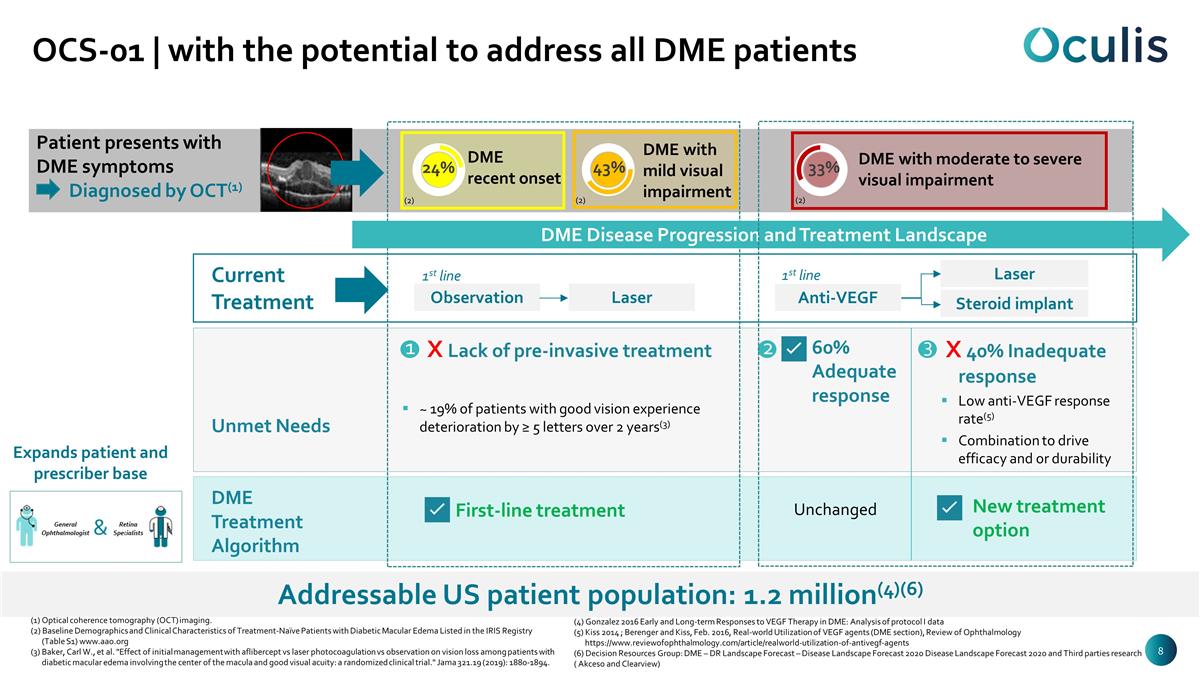
Unmet Needs DME Treatment Algorithm Patient presents with DME symptoms Diagnosed by OCT(1) Current Treatment Observation Laser Anti-VEGF Steroid implant Laser 1st line 1st line 24% DME recent onset DME with mild visual impairment 43% 33% DME with moderate to severe visual impairment DME Disease Progression and Treatment Landscape (1) Optical coherence tomography (OCT) imaging. (2) Baseline Demographics and Clinical Characteristics of Treatment-Naïve Patients with Diabetic Macular Edema Listed in the IRIS Registry (Table S1) www.aao.org (3) Baker, Carl W., et al. "Effect of initial management with aflibercept vs laser photocoagulation vs observation on vision loss among patients with diabetic macular edema involving the center of the macula and good visual acuity: a randomized clinical trial." Jama 321.19 (2019): 1880-1894. (4) Gonzalez 2016 Early and Long-term Responses to VEGF Therapy in DME: Analysis of protocol I data (5) Kiss 2014 ; Berenger and Kiss, Feb. 2016, Real-world Utilization of VEGF agents (DME section), Review of Ophthalmology https://www.reviewofophthalmology.com/article/realworld-utilization-of-antivegf-agents (6) Decision Resources Group: DME – DR Landscape Forecast – Disease Landscape Forecast 2020 Disease Landscape Forecast 2020 and Third parties research ( Akceso and Clearview) (2) (2) (2) 1 X Lack of pre-invasive treatment ~ 19% of patients with good vision experience deterioration by ≥ 5 letters over 2 years(3) X 40% Inadequate response Low anti-VEGF response rate(5) Combination to drive efficacy and or durability 60% Adequate response 1 2 3 Expands patient and prescriber base First-line treatment New treatment option Addressable US patient population: 1.2 million(4)(6) OCS-01 | with the potential to address all DME patients Unchanged
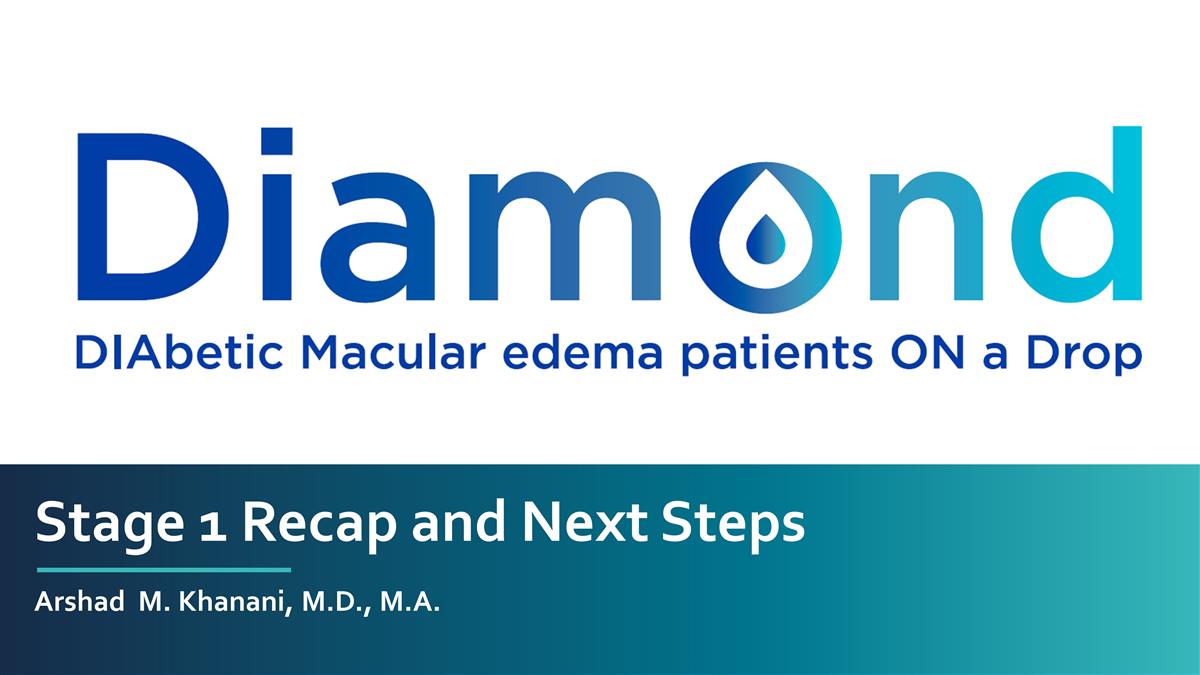
Stage 1 Recap and Next Steps Arshad M. Khanani, M.D., M.A.
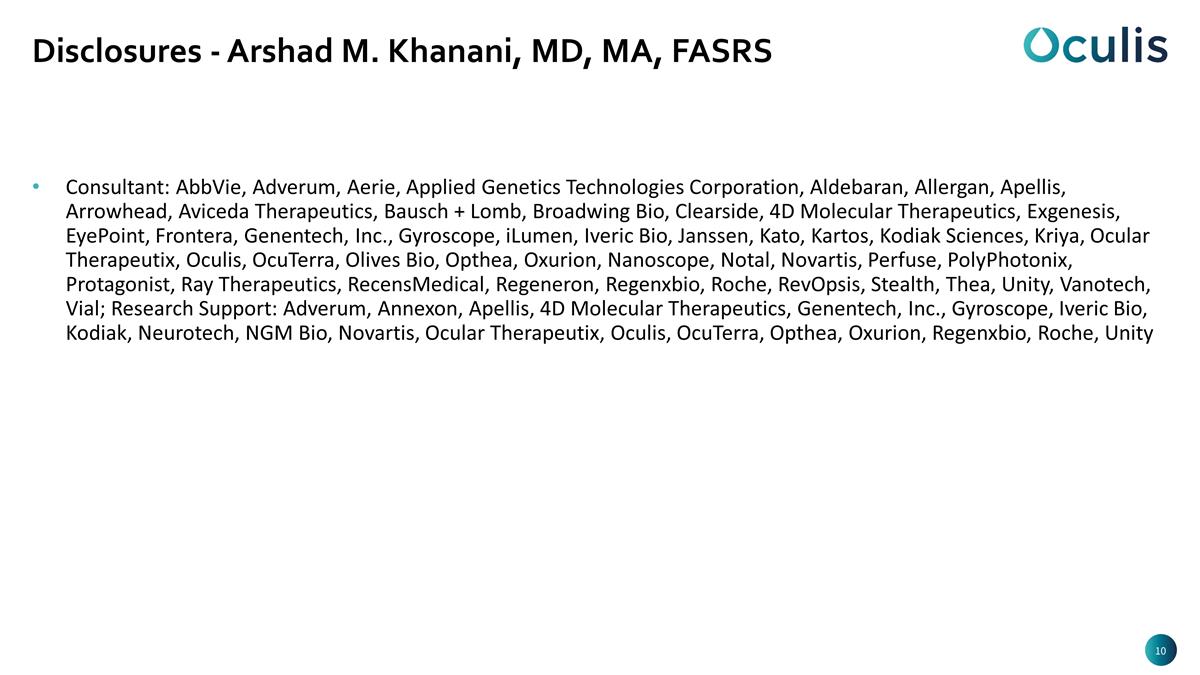
Disclosures - Arshad M. Khanani, MD, MA, FASRS Consultant: AbbVie, Adverum, Aerie, Applied Genetics Technologies Corporation, Aldebaran, Allergan, Apellis, Arrowhead, Aviceda Therapeutics, Bausch + Lomb, Broadwing Bio, Clearside, 4D Molecular Therapeutics, Exgenesis, EyePoint, Frontera, Genentech, Inc., Gyroscope, iLumen, Iveric Bio, Janssen, Kato, Kartos, Kodiak Sciences, Kriya, Ocular Therapeutix, Oculis, OcuTerra, Olives Bio, Opthea, Oxurion, Nanoscope, Notal, Novartis, Perfuse, PolyPhotonix, Protagonist, Ray Therapeutics, RecensMedical, Regeneron, Regenxbio, Roche, RevOpsis, Stealth, Thea, Unity, Vanotech, Vial; Research Support: Adverum, Annexon, Apellis, 4D Molecular Therapeutics, Genentech, Inc., Gyroscope, Iveric Bio, Kodiak, Neurotech, NGM Bio, Novartis, Ocular Therapeutix, Oculis, OcuTerra, Opthea, Oxurion, Regenxbio, Roche, Unity
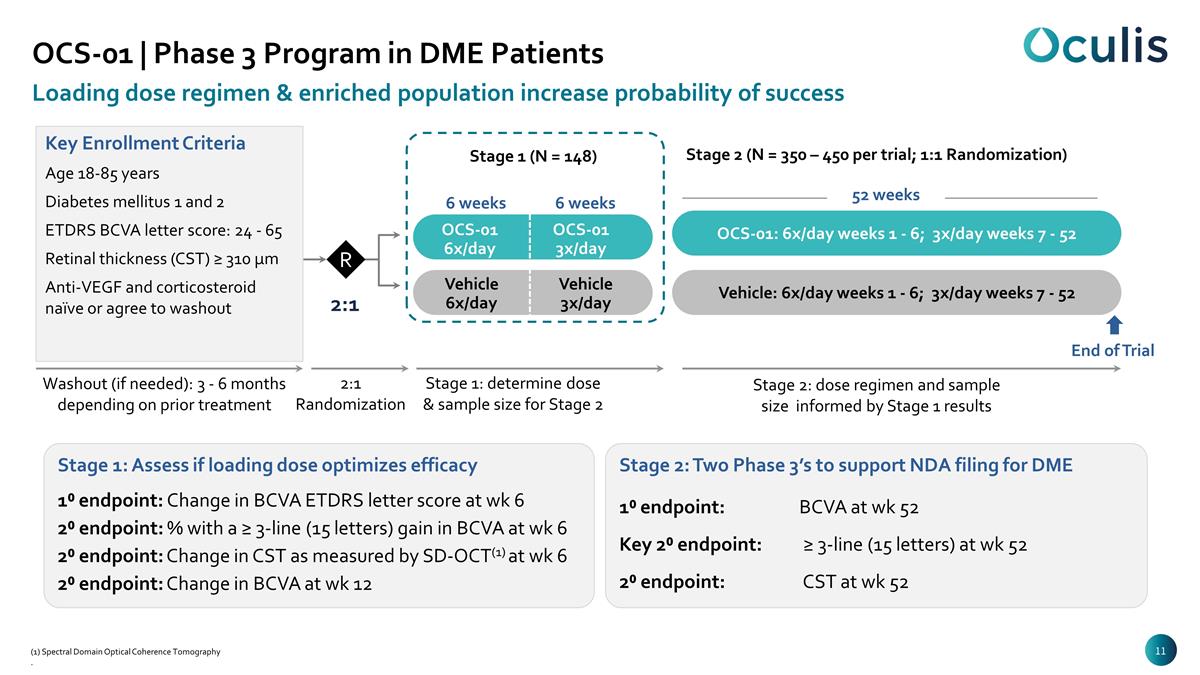
Loading dose regimen & enriched population increase probability of success Washout (if needed): 3 - 6 months depending on prior treatment 2:1 Randomization Stage 1: determine dose & sample size for Stage 2 Stage 2: dose regimen and sample size informed by Stage 1 results 2:1 Stage 1 (N = 148) Stage 2 (N = 350 – 450 per trial; 1:1 Randomization) Key Enrollment Criteria Age 18-85 years Diabetes mellitus 1 and 2 ETDRS BCVA letter score: 24 - 65 Retinal thickness (CST) ≥ 310 µm Anti-VEGF and corticosteroid naïve or agree to washout R OCS-01: 6x/day weeks 1 - 6; 3x/day weeks 7 - 52 Vehicle: 6x/day weeks 1 - 6; 3x/day weeks 7 - 52 OCS-01 6x/day OCS-01 3x/day Vehicle 6x/day Vehicle 3x/day Stage 1: Assess if loading dose optimizes efficacy 1⁰ endpoint: Change in BCVA ETDRS letter score at wk 6 2⁰ endpoint: % with a ≥ 3-line (15 letters) gain in BCVA at wk 6 2⁰ endpoint: Change in CST as measured by SD-OCT(1) at wk 6 2⁰ endpoint: Change in BCVA at wk 12 Stage 2: Two Phase 3’s to support NDA filing for DME 1⁰ endpoint: BCVA at wk 52 Key 2⁰ endpoint: ≥ 3-line (15 letters) at wk 52 2⁰ endpoint: CST at wk 52 6 weeks 6 weeks 52 weeks End of Trial OCS-01 | Phase 3 Program in DME Patients (1) Spectral Domain Optical Coherence Tomography .
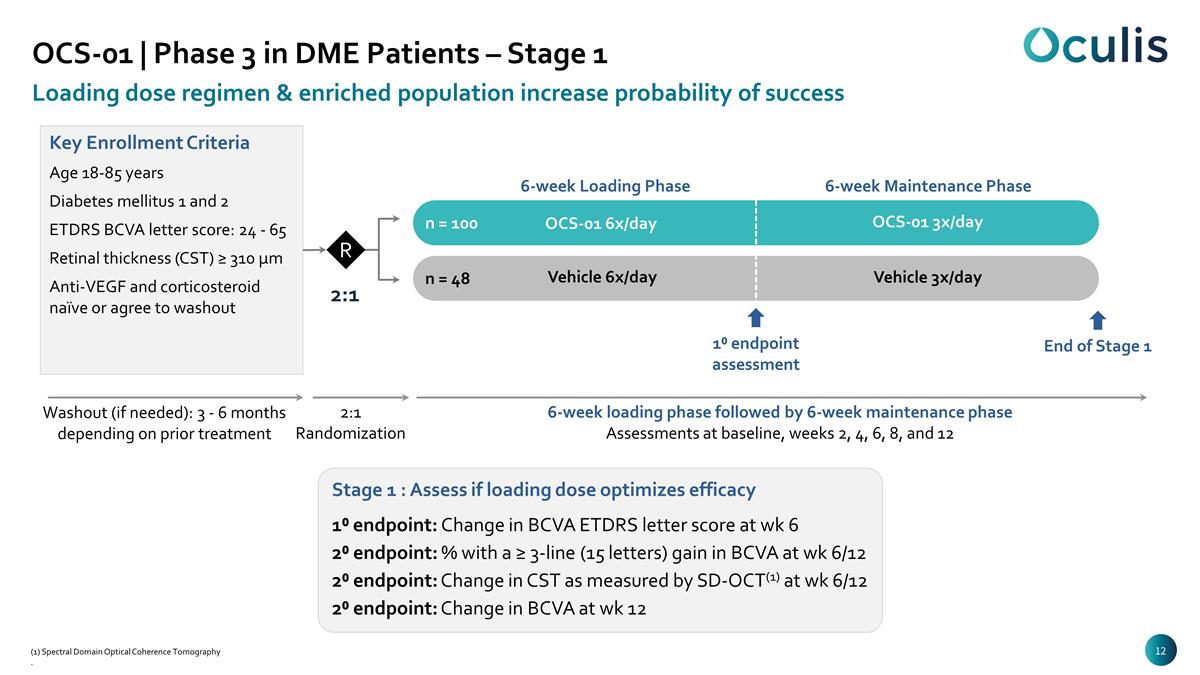
Loading dose regimen & enriched population increase probability of success Washout (if needed): 3 - 6 months depending on prior treatment 2:1 Randomization 6-week loading phase followed by 6-week maintenance phase Assessments at baseline, weeks 2, 4, 6, 8, and 12 2:1 Key Enrollment Criteria Age 18-85 years Diabetes mellitus 1 and 2 ETDRS BCVA letter score: 24 - 65 Retinal thickness (CST) ≥ 310 µm Anti-VEGF and corticosteroid naïve or agree to washout R OCS-01 6x/day OCS-01 3x/day Vehicle 6x/day Vehicle 3x/day Stage 1 : Assess if loading dose optimizes efficacy 1⁰ endpoint: Change in BCVA ETDRS letter score at wk 6 2⁰ endpoint: % with a ≥ 3-line (15 letters) gain in BCVA at wk 6/12 2⁰ endpoint: Change in CST as measured by SD-OCT(1) at wk 6/12 2⁰ endpoint: Change in BCVA at wk 12 6-week Loading Phase 6-week Maintenance Phase n = 100 n = 48 End of Stage 1 1⁰ endpoint assessment OCS-01 | Phase 3 in DME Patients – Stage 1 (1) Spectral Domain Optical Coherence Tomography .
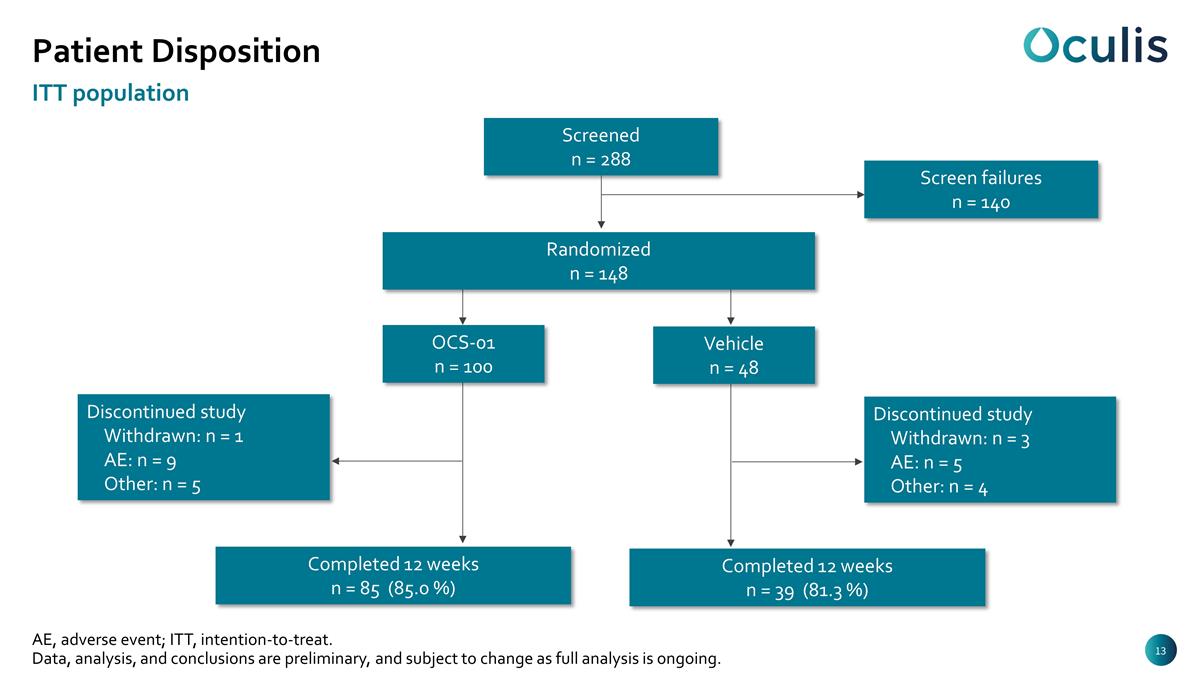
AE, adverse event; ITT, intention-to-treat. Data, analysis, and conclusions are preliminary, and subject to change as full analysis is ongoing. Patient Disposition ITT population Screened n = 288 Screen failures n = 140 OCS-01 n = 100 Vehicle n = 48 Completed 12 weeks n = 85 (85.0 %) Completed 12 weeks n = 39 (81.3 %) Discontinued study Withdrawn: n = 3 AE: n = 5 Other: n = 4 Discontinued study Withdrawn: n = 1 AE: n = 9 Other: n = 5 Randomized n = 148
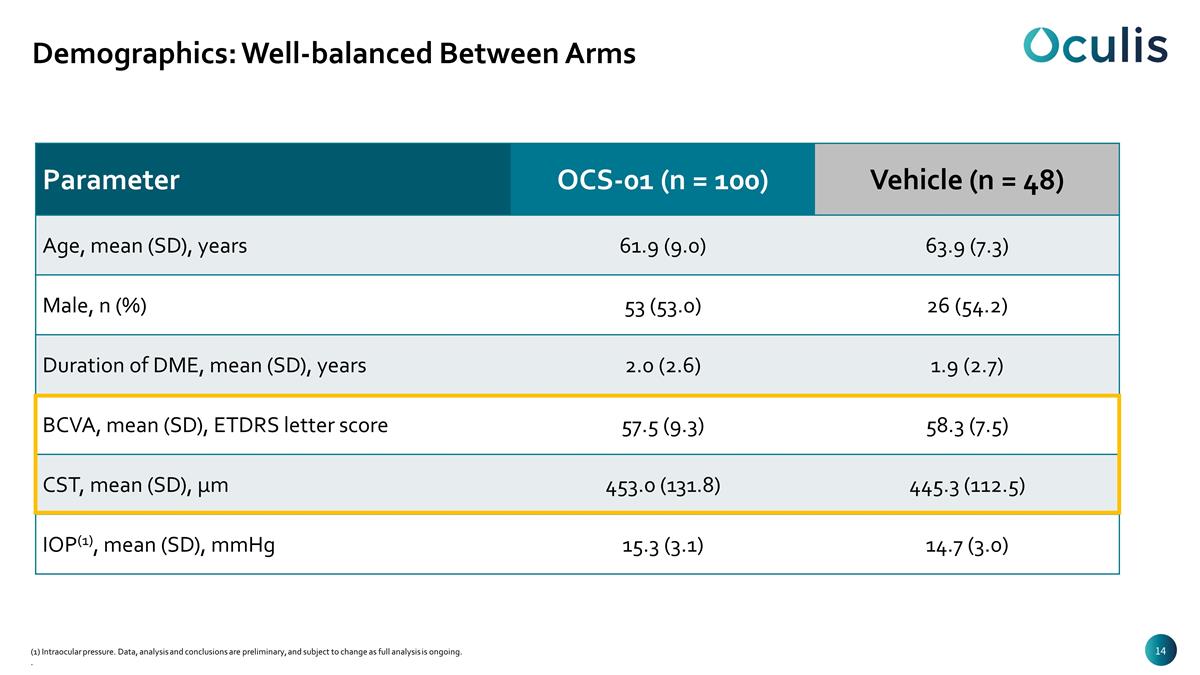
Demographics: Well-balanced Between Arms (1) Intraocular pressure. Data, analysis and conclusions are preliminary, and subject to change as full analysis is ongoing. . Parameter OCS-01 (n = 100) Vehicle (n = 48) Age, mean (SD), years 61.9 (9.0) 63.9 (7.3) Male, n (%) 53 (53.0) 26 (54.2) Duration of DME, mean (SD), years 2.0 (2.6) 1.9 (2.7) BCVA, mean (SD), ETDRS letter score 57.5 (9.3) 58.3 (7.5) CST, mean (SD), µm 453.0 (131.8) 445.3 (112.5) IOP(1), mean (SD), mmHg 15.3 (3.1) 14.7 (3.0)
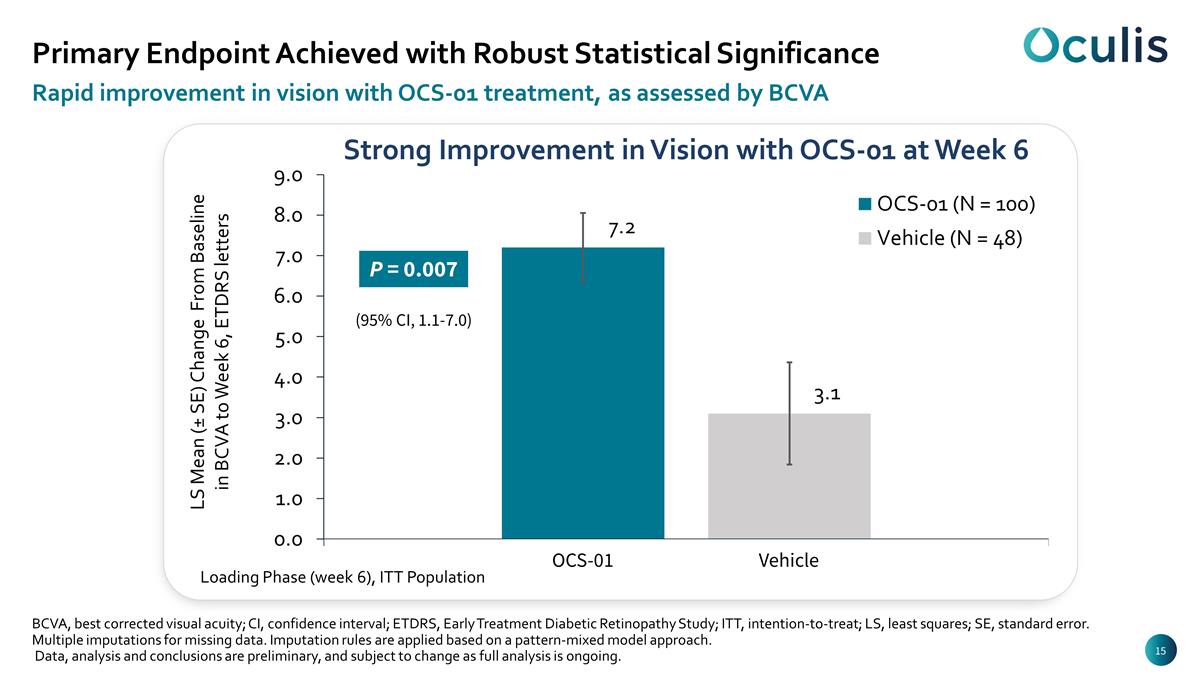
Primary Endpoint Achieved with Robust Statistical Significance Rapid improvement in vision with OCS-01 treatment, as assessed by BCVA Strong Improvement in Vision with OCS-01 at Week 6 (95% CI, 1.1-7.0) OCS-01 Vehicle P = 0.007 Loading Phase (week 6), ITT Population BCVA, best corrected visual acuity; CI, confidence interval; ETDRS, Early Treatment Diabetic Retinopathy Study; ITT, intention-to-treat; LS, least squares; SE, standard error. Multiple imputations for missing data. Imputation rules are applied based on a pattern-mixed model approach. Data, analysis and conclusions are preliminary, and subject to change as full analysis is ongoing.
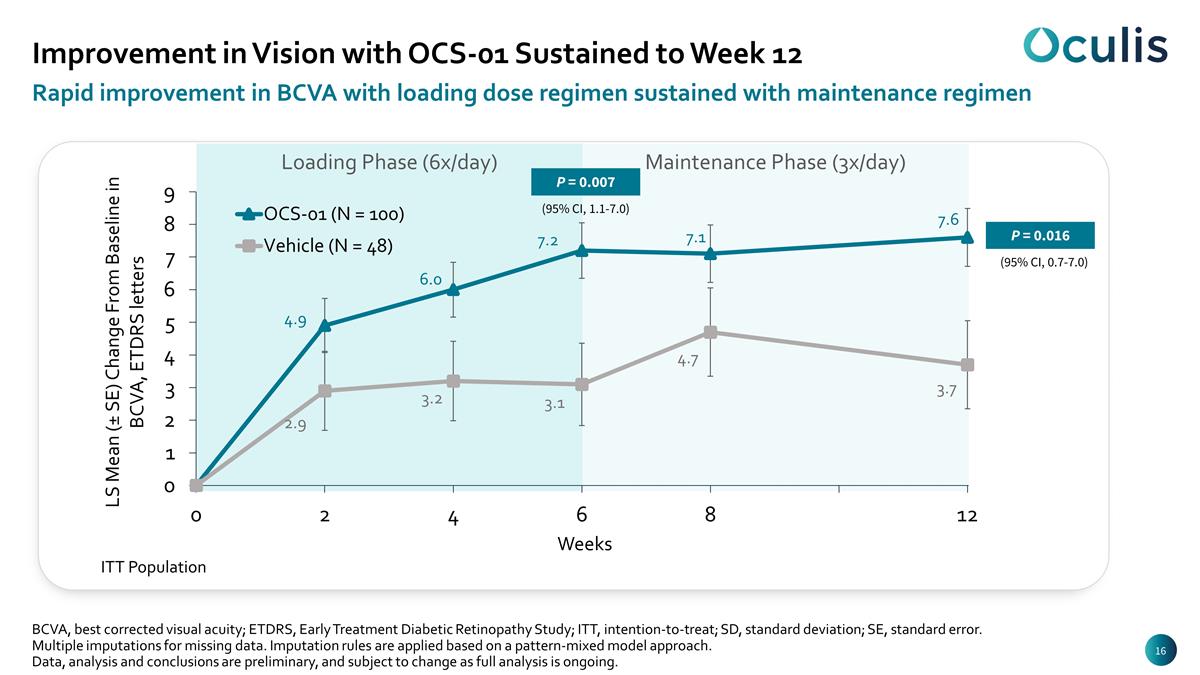
Loading Phase (6x/day) Maintenance Phase (3x/day) Improvement in Vision with OCS-01 Sustained to Week 12 Rapid improvement in BCVA with loading dose regimen sustained with maintenance regimen BCVA, best corrected visual acuity; ETDRS, Early Treatment Diabetic Retinopathy Study; ITT, intention-to-treat; SD, standard deviation; SE, standard error. Multiple imputations for missing data. Imputation rules are applied based on a pattern-mixed model approach. Data, analysis and conclusions are preliminary, and subject to change as full analysis is ongoing. (95% CI, 0.7-7.0) P = 0.016 ITT Population (95% CI, 1.1-7.0) P = 0.007
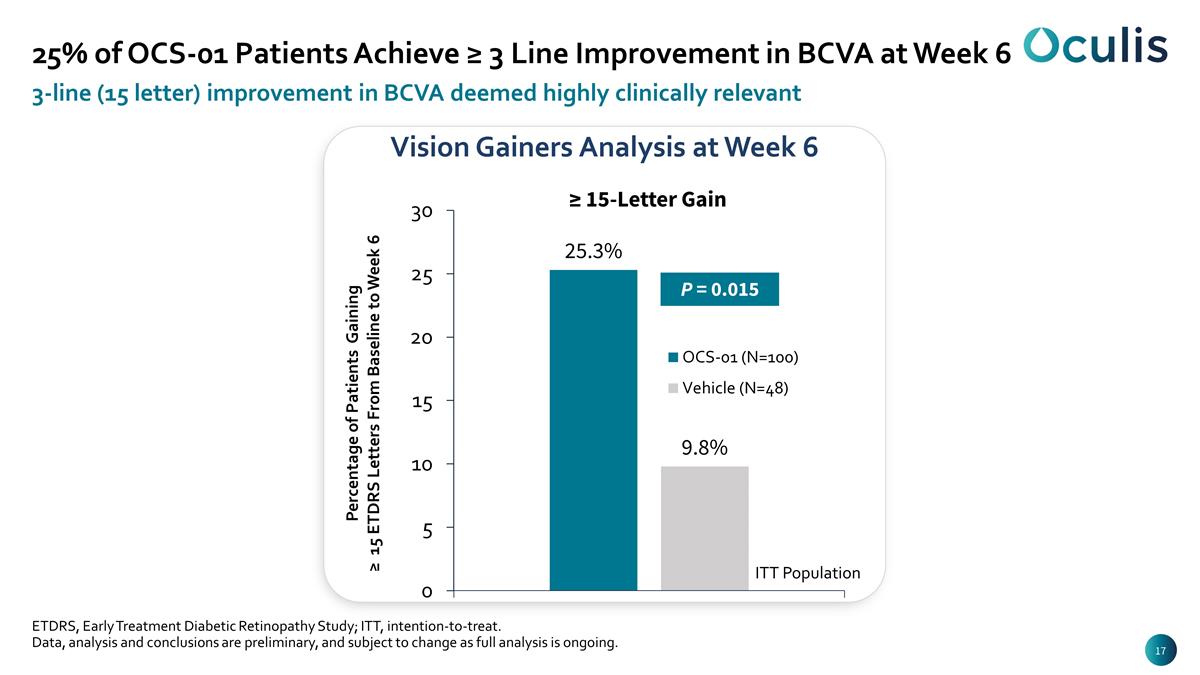
25% of OCS-01 Patients Achieve ≥ 3 Line Improvement in BCVA at Week 6 Vision Gainers Analysis at Week 6 3-line (15 letter) improvement in BCVA deemed highly clinically relevant ≥ 15-Letter Gain P = 0.015 ETDRS, Early Treatment Diabetic Retinopathy Study; ITT, intention-to-treat. Data, analysis and conclusions are preliminary, and subject to change as full analysis is ongoing. ITT Population
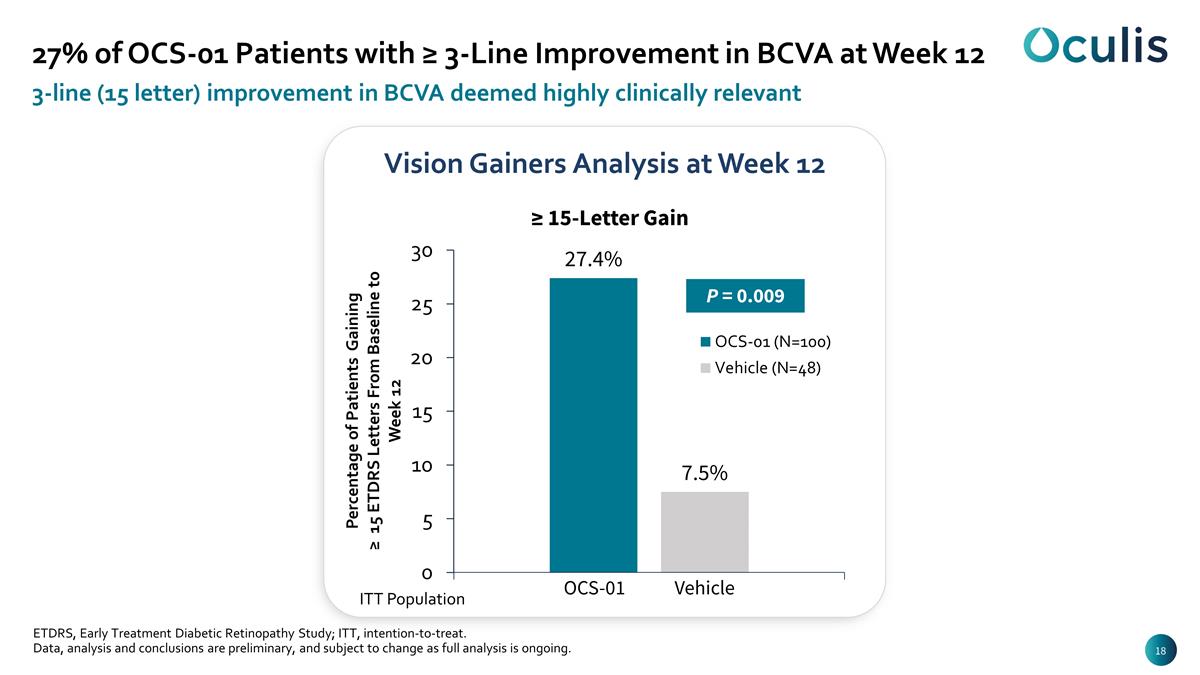
27% of OCS-01 Patients with ≥ 3-Line Improvement in BCVA at Week 12 Vision Gainers Analysis at Week 12 3-line (15 letter) improvement in BCVA deemed highly clinically relevant ≥ 15-Letter Gain OCS-01 Vehicle P = 0.009 ETDRS, Early Treatment Diabetic Retinopathy Study; ITT, intention-to-treat. Data, analysis and conclusions are preliminary, and subject to change as full analysis is ongoing. ITT Population
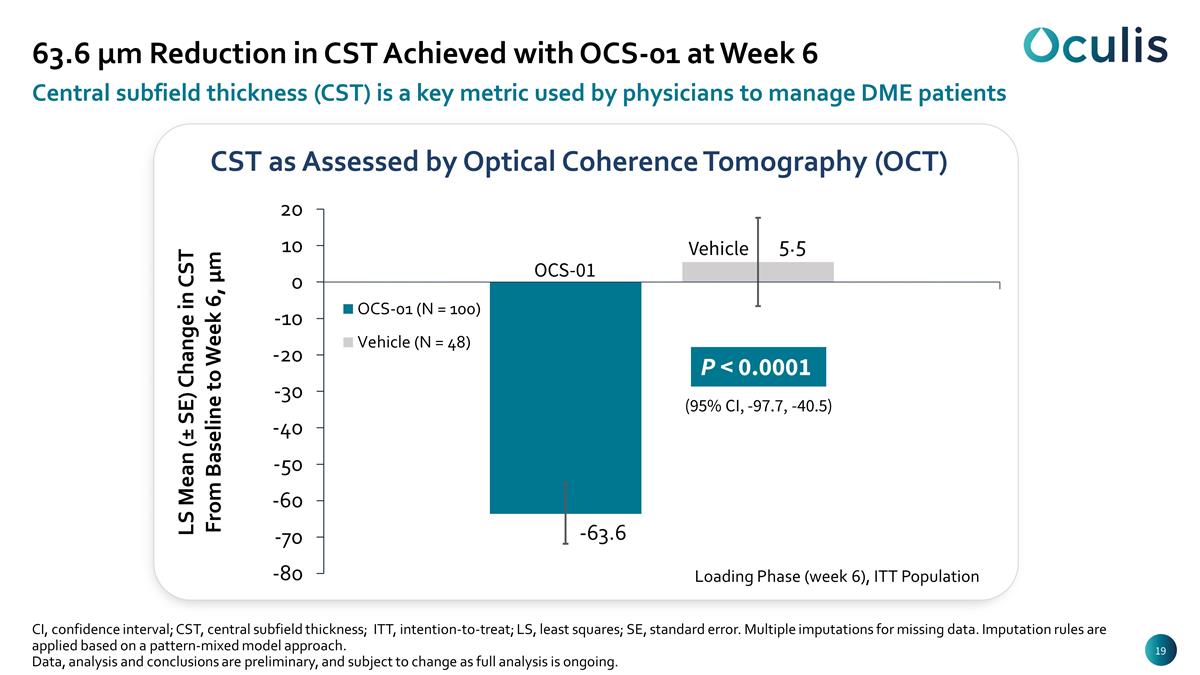
63.6 μm Reduction in CST Achieved with OCS-01 at Week 6 CST as Assessed by Optical Coherence Tomography (OCT) Central subfield thickness (CST) is a key metric used by physicians to manage DME patients (95% CI, -97.7, -40.5) P < 0.0001 OCS-01 Vehicle CI, confidence interval; CST, central subfield thickness; ITT, intention-to-treat; LS, least squares; SE, standard error. Multiple imputations for missing data. Imputation rules are applied based on a pattern-mixed model approach. Data, analysis and conclusions are preliminary, and subject to change as full analysis is ongoing. Loading Phase (week 6), ITT Population
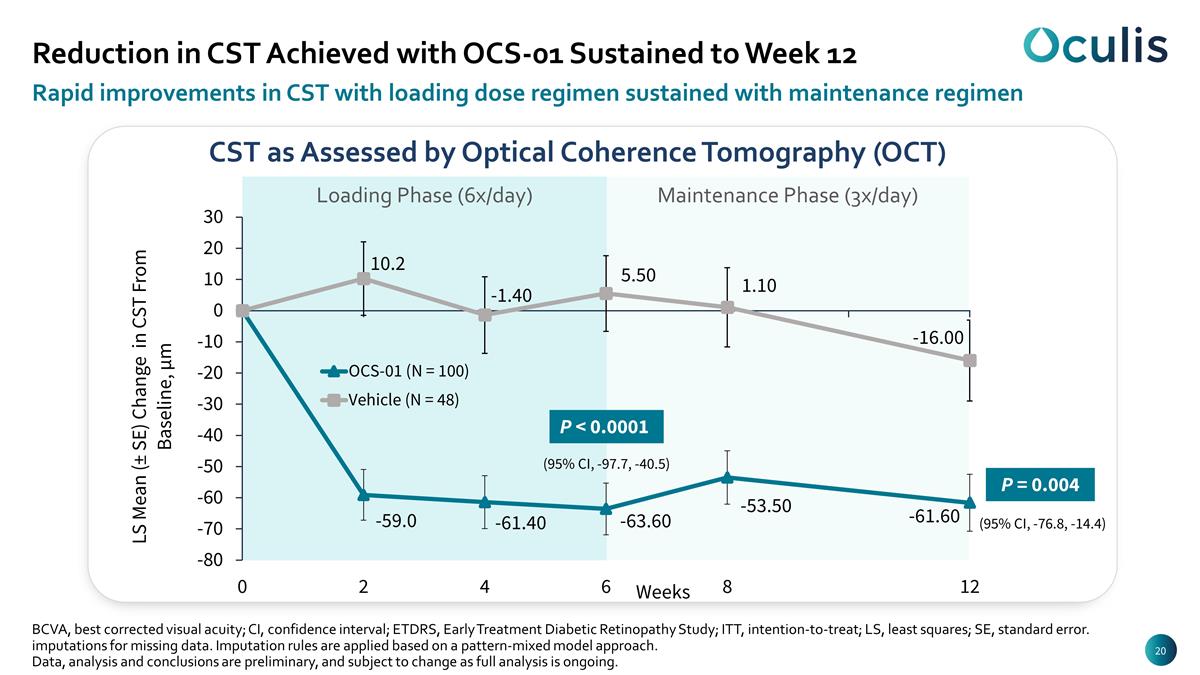
Maintenance Phase (3x/day) Loading Phase (6x/day) Reduction in CST Achieved with OCS-01 Sustained to Week 12 CST as Assessed by Optical Coherence Tomography (OCT) Rapid improvements in CST with loading dose regimen sustained with maintenance regimen (95% CI, -76.8, -14.4) P = 0.004 (95% CI, -97.7, -40.5) P < 0.0001 BCVA, best corrected visual acuity; CI, confidence interval; ETDRS, Early Treatment Diabetic Retinopathy Study; ITT, intention-to-treat; LS, least squares; SE, standard error. imputations for missing data. Imputation rules are applied based on a pattern-mixed model approach. Data, analysis and conclusions are preliminary, and subject to change as full analysis is ongoing.
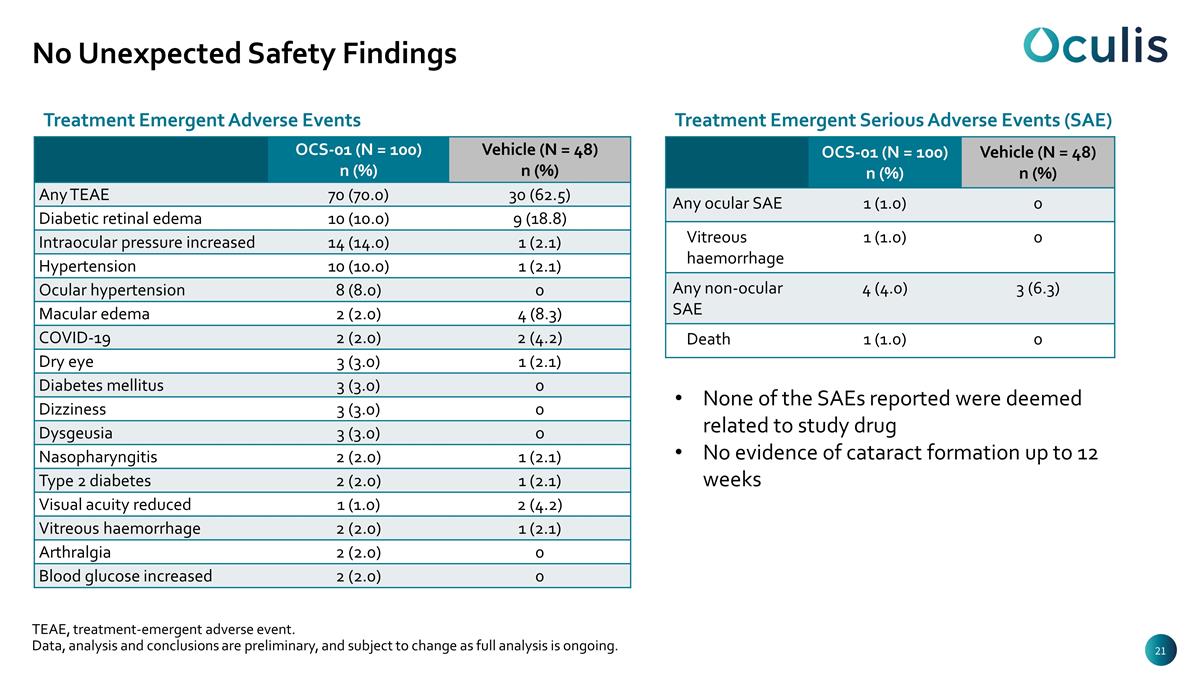
No Unexpected Safety Findings Treatment Emergent Adverse Events OCS-01 (N = 100) n (%) Vehicle (N = 48) n (%) Any TEAE 70 (70.0) 30 (62.5) Diabetic retinal edema 10 (10.0) 9 (18.8) Intraocular pressure increased 14 (14.0) 1 (2.1) Hypertension 10 (10.0) 1 (2.1) Ocular hypertension 8 (8.0) 0 Macular edema 2 (2.0) 4 (8.3) COVID-19 2 (2.0) 2 (4.2) Dry eye 3 (3.0) 1 (2.1) Diabetes mellitus 3 (3.0) 0 Dizziness 3 (3.0) 0 Dysgeusia 3 (3.0) o Nasopharyngitis 2 (2.0) 1 (2.1) Type 2 diabetes 2 (2.0) 1 (2.1) Visual acuity reduced 1 (1.0) 2 (4.2) Vitreous haemorrhage 2 (2.0) 1 (2.1) Arthralgia 2 (2.0) 0 Blood glucose increased 2 (2.0) 0 OCS-01 (N = 100) n (%) Vehicle (N = 48) n (%) Any ocular SAE 1 (1.0) 0 Vitreous haemorrhage 1 (1.0) 0 Any non-ocular SAE 4 (4.0) 3 (6.3) Death 1 (1.0) 0 Treatment Emergent Serious Adverse Events (SAE) TEAE, treatment-emergent adverse event. Data, analysis and conclusions are preliminary, and subject to change as full analysis is ongoing. None of the SAEs reported were deemed related to study drug No evidence of cataract formation up to 12 weeks
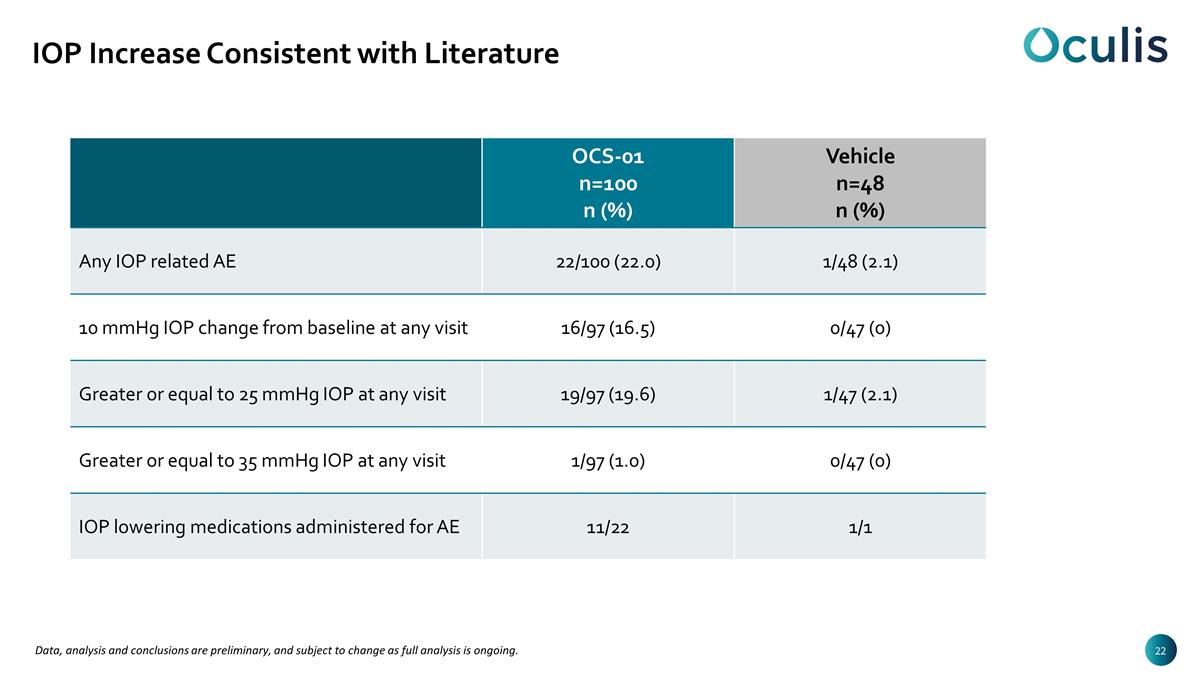
IOP Increase Consistent with Literature OCS-01 n=100 n (%) Vehicle n=48 n (%) Any IOP related AE 22/100 (22.0) 1/48 (2.1) 10 mmHg IOP change from baseline at any visit 16/97 (16.5) 0/47 (0) Greater or equal to 25 mmHg IOP at any visit 19/97 (19.6) 1/47 (2.1) Greater or equal to 35 mmHg IOP at any visit 1/97 (1.0) 0/47 (0) IOP lowering medications administered for AE 11/22 1/1 Data, analysis and conclusions are preliminary, and subject to change as full analysis is ongoing.
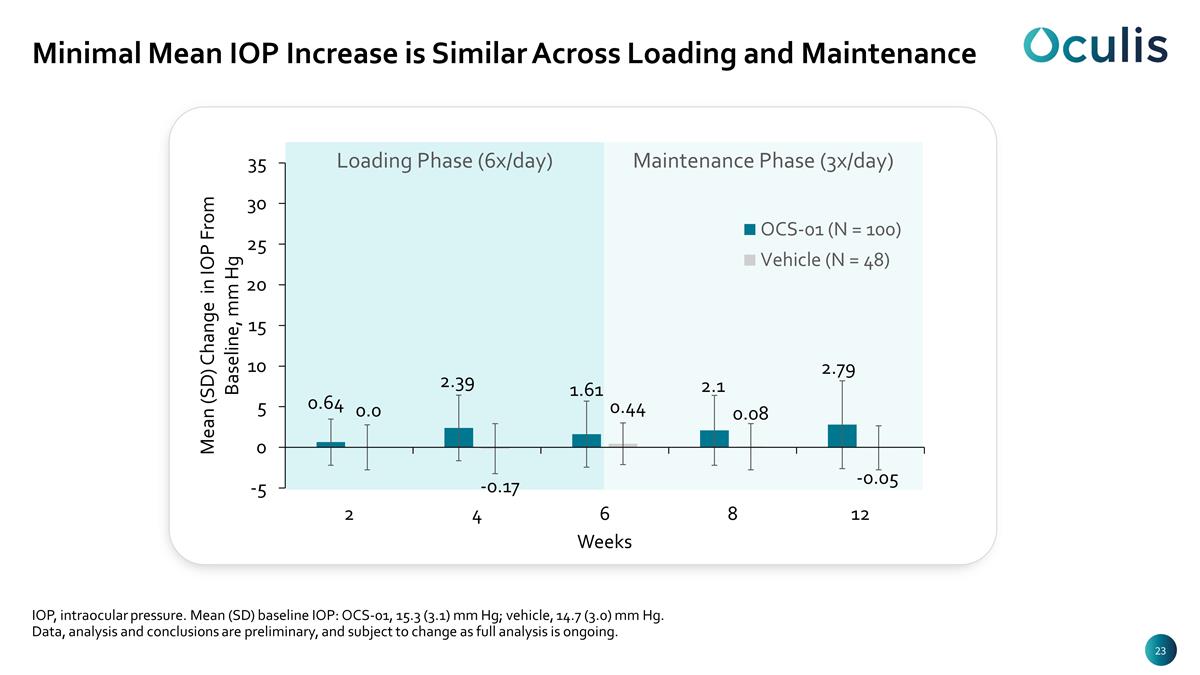
Minimal Mean IOP Increase is Similar Across Loading and Maintenance Loading Phase (6x/day) Maintenance Phase (3x/day) IOP, intraocular pressure. Mean (SD) baseline IOP: OCS-01, 15.3 (3.1) mm Hg; vehicle, 14.7 (3.0) mm Hg. Data, analysis and conclusions are preliminary, and subject to change as full analysis is ongoing.
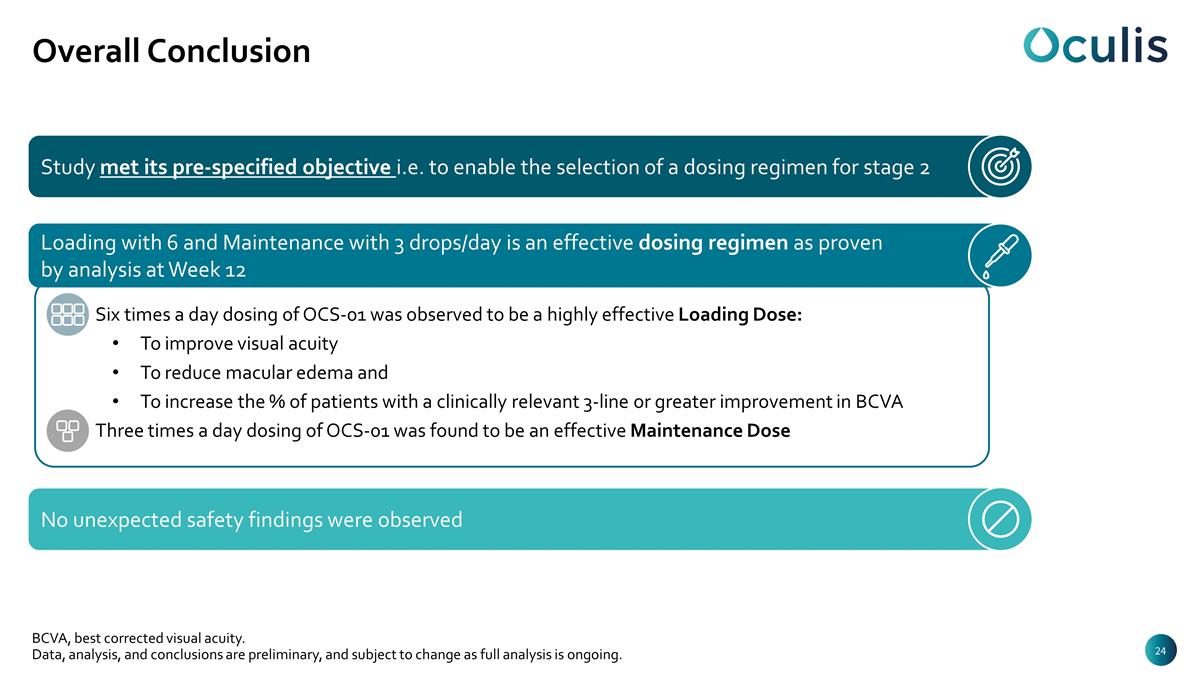
Overall Conclusion BCVA, best corrected visual acuity. Data, analysis, and conclusions are preliminary, and subject to change as full analysis is ongoing. Study met its pre-specified objective i.e. to enable the selection of a dosing regimen for stage 2 No unexpected safety findings were observed Six times a day dosing of OCS-01 was observed to be a highly effective Loading Dose: To improve visual acuity To reduce macular edema and To increase the % of patients with a clinically relevant 3-line or greater improvement in BCVA Three times a day dosing of OCS-01 was found to be an effective Maintenance Dose Loading with 6 and Maintenance with 3 drops/day is an effective dosing regimen as proven by analysis at Week 12
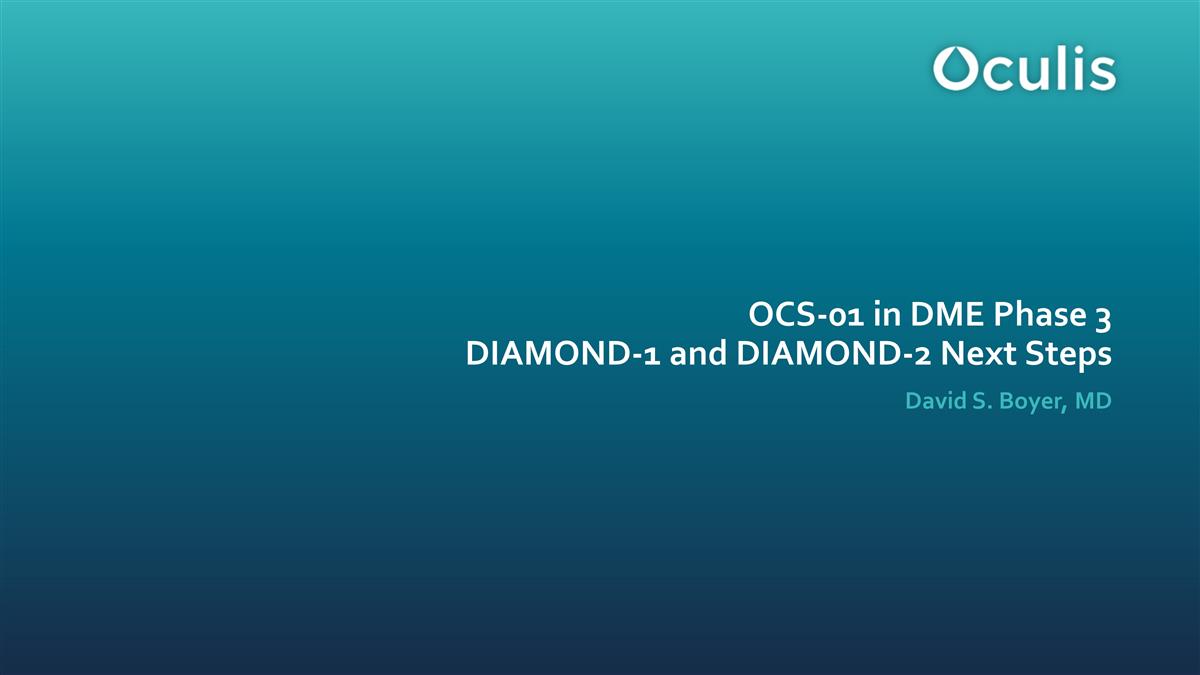
OCS-01 in DME Phase 3 DIAMOND-1 and DIAMOND-2 Next Steps David S. Boyer, MD
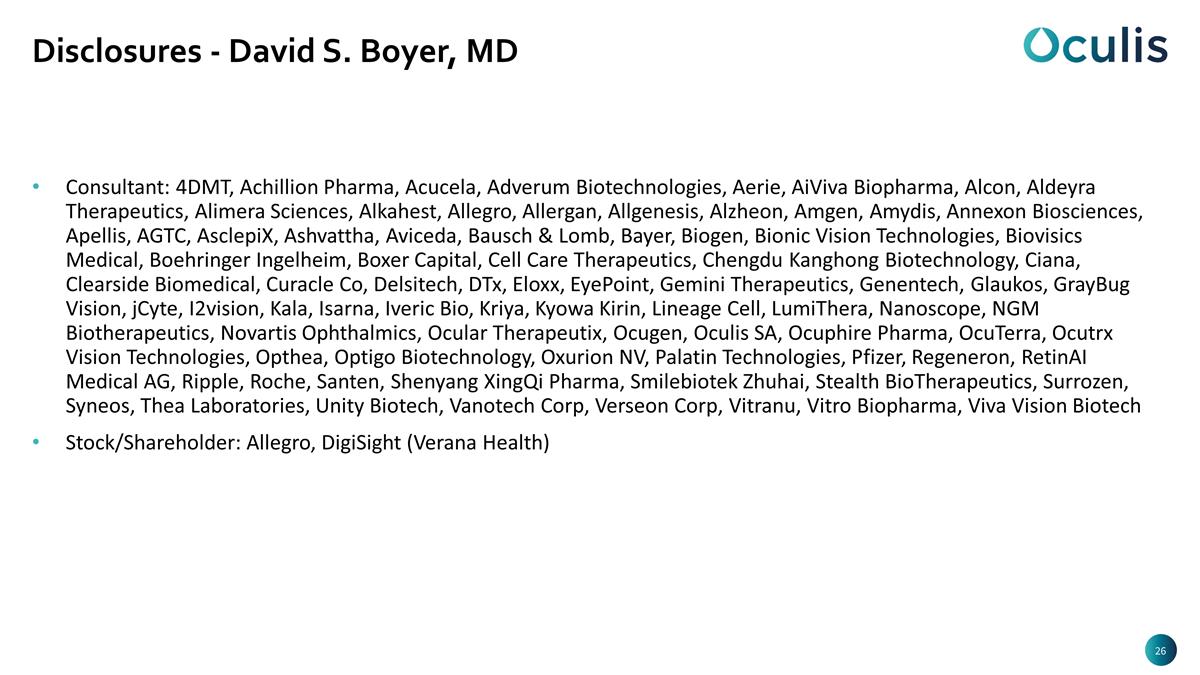
Disclosures - David S. Boyer, MD Consultant: 4DMT, Achillion Pharma, Acucela, Adverum Biotechnologies, Aerie, AiViva Biopharma, Alcon, Aldeyra Therapeutics, Alimera Sciences, Alkahest, Allegro, Allergan, Allgenesis, Alzheon, Amgen, Amydis, Annexon Biosciences, Apellis, AGTC, AsclepiX, Ashvattha, Aviceda, Bausch & Lomb, Bayer, Biogen, Bionic Vision Technologies, Biovisics Medical, Boehringer Ingelheim, Boxer Capital, Cell Care Therapeutics, Chengdu Kanghong Biotechnology, Ciana, Clearside Biomedical, Curacle Co, Delsitech, DTx, Eloxx, EyePoint, Gemini Therapeutics, Genentech, Glaukos, GrayBug Vision, jCyte, I2vision, Kala, Isarna, Iveric Bio, Kriya, Kyowa Kirin, Lineage Cell, LumiThera, Nanoscope, NGM Biotherapeutics, Novartis Ophthalmics, Ocular Therapeutix, Ocugen, Oculis SA, Ocuphire Pharma, OcuTerra, Ocutrx Vision Technologies, Opthea, Optigo Biotechnology, Oxurion NV, Palatin Technologies, Pfizer, Regeneron, RetinAI Medical AG, Ripple, Roche, Santen, Shenyang XingQi Pharma, Smilebiotek Zhuhai, Stealth BioTherapeutics, Surrozen, Syneos, Thea Laboratories, Unity Biotech, Vanotech Corp, Verseon Corp, Vitranu, Vitro Biopharma, Viva Vision Biotech Stock/Shareholder: Allegro, DigiSight (Verana Health)
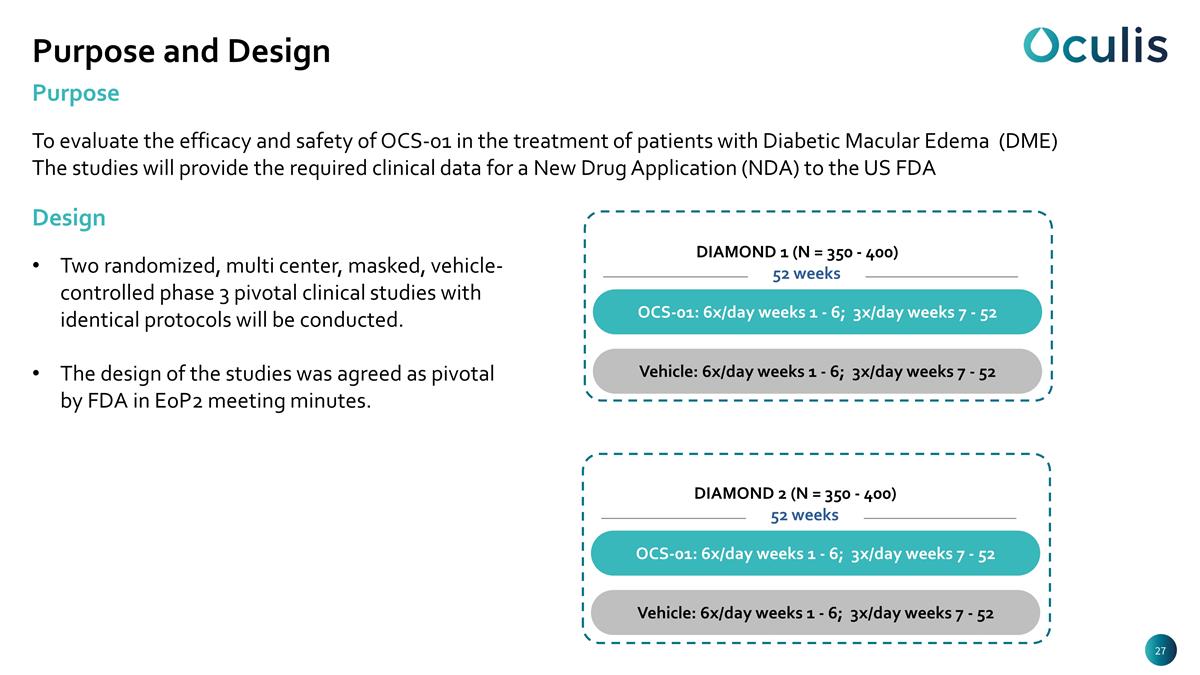
Purpose and Design Purpose To evaluate the efficacy and safety of OCS-01 in the treatment of patients with Diabetic Macular Edema (DME) The studies will provide the required clinical data for a New Drug Application (NDA) to the US FDA Design Two randomized, multi center, masked, vehicle-controlled phase 3 pivotal clinical studies with identical protocols will be conducted. The design of the studies was agreed as pivotal by FDA in EoP2 meeting minutes. OCS-01: 6x/day weeks 1 - 6; 3x/day weeks 7 - 52 Vehicle: 6x/day weeks 1 - 6; 3x/day weeks 7 - 52 52 weeks OCS-01: 6x/day weeks 1 - 6; 3x/day weeks 7 - 52 Vehicle: 6x/day weeks 1 - 6; 3x/day weeks 7 - 52 52 weeks DIAMOND 1 (N = 350 - 400) DIAMOND 2 (N = 350 - 400)
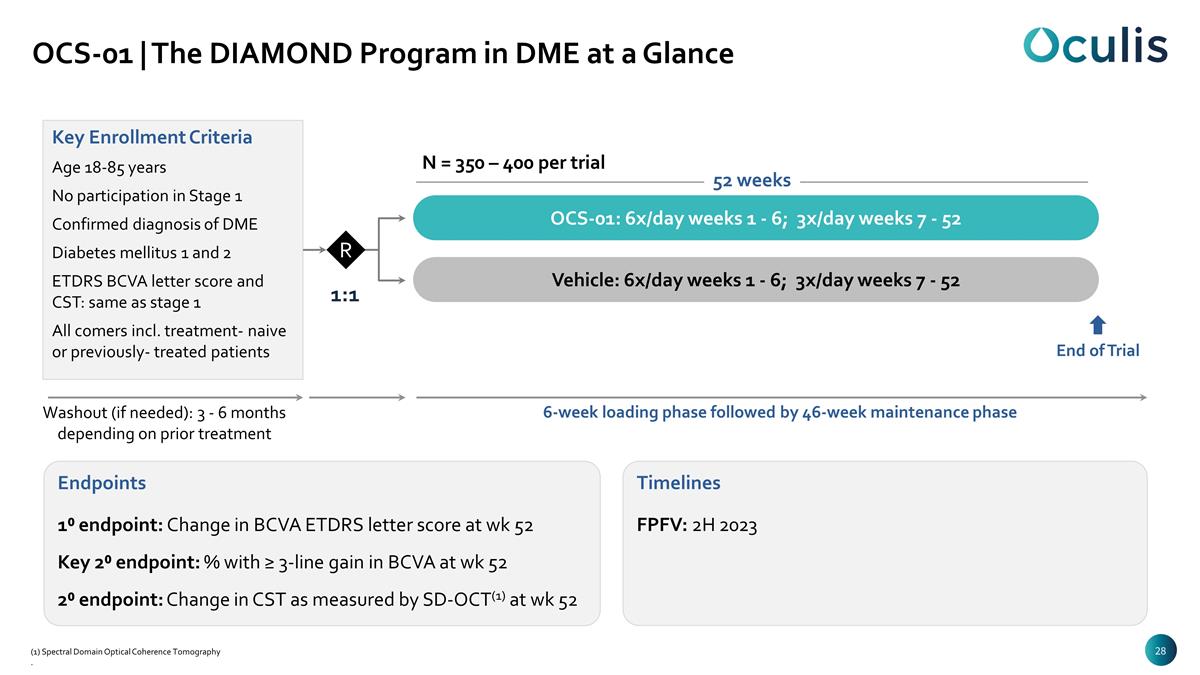
OCS-01 | The DIAMOND Program in DME at a Glance Washout (if needed): 3 - 6 months depending on prior treatment 6-week loading phase followed by 46-week maintenance phase 1:1 Key Enrollment Criteria Age 18-85 years No participation in Stage 1 Confirmed diagnosis of DME Diabetes mellitus 1 and 2 ETDRS BCVA letter score and CST: same as stage 1 All comers incl. treatment- naive or previously- treated patients R Vehicle: 6x/day weeks 1 - 6; 3x/day weeks 7 - 52 OCS-01: 6x/day weeks 1 - 6; 3x/day weeks 7 - 52 End of Trial 52 weeks N = 350 – 400 per trial Endpoints 1⁰ endpoint: Change in BCVA ETDRS letter score at wk 52 Key 2⁰ endpoint: % with ≥ 3-line gain in BCVA at wk 52 2⁰ endpoint: Change in CST as measured by SD-OCT(1) at wk 52 Timelines FPFV: 2H 2023 (1) Spectral Domain Optical Coherence Tomography .
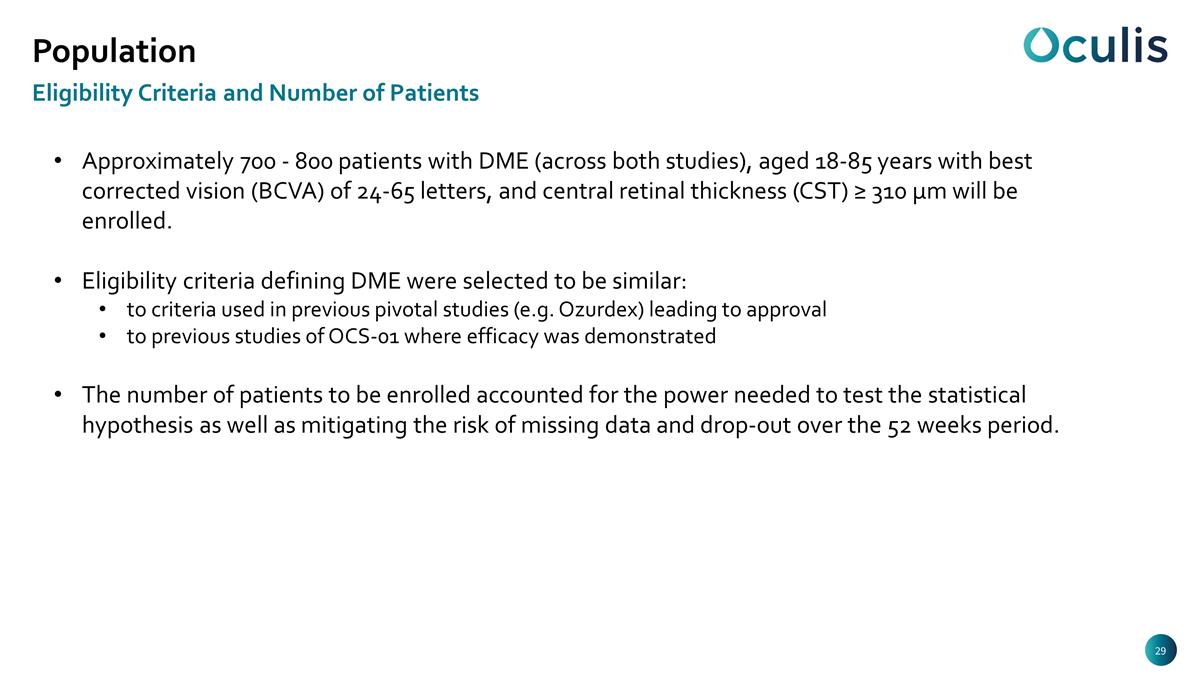
Population Approximately 700 - 800 patients with DME (across both studies), aged 18-85 years with best corrected vision (BCVA) of 24-65 letters, and central retinal thickness (CST) ≥ 310 µm will be enrolled. Eligibility criteria defining DME were selected to be similar: to criteria used in previous pivotal studies (e.g. Ozurdex) leading to approval to previous studies of OCS-01 where efficacy was demonstrated The number of patients to be enrolled accounted for the power needed to test the statistical hypothesis as well as mitigating the risk of missing data and drop-out over the 52 weeks period. Eligibility Criteria and Number of Patients
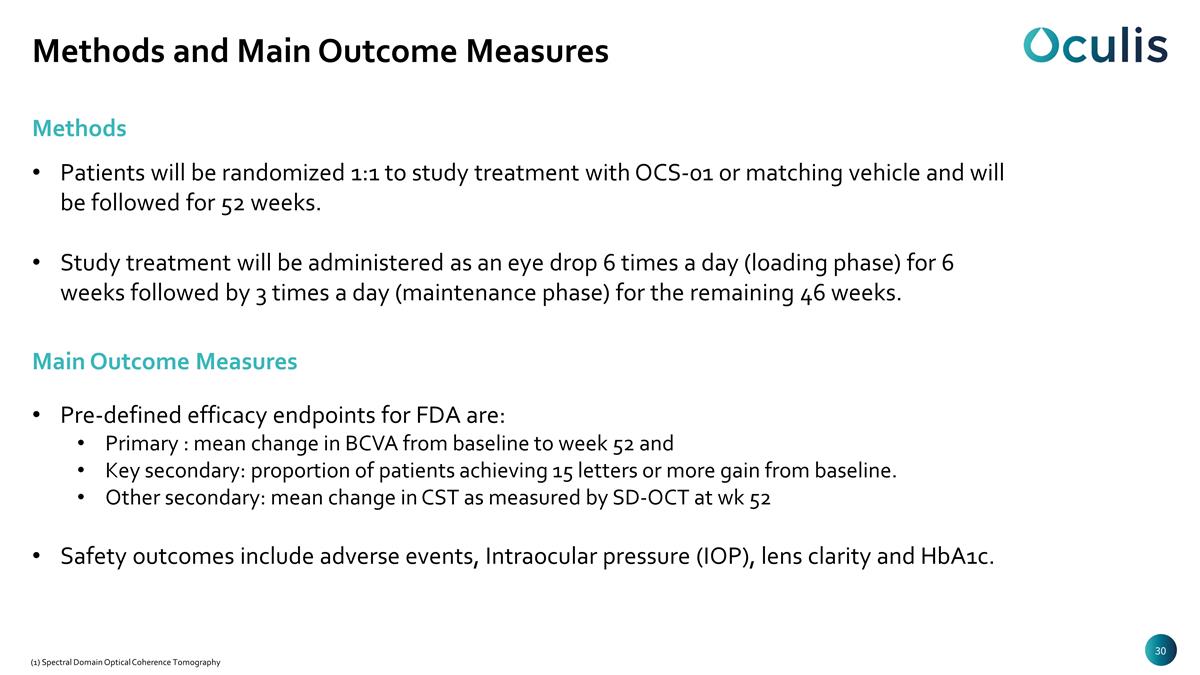
Methods and Main Outcome Measures Patients will be randomized 1:1 to study treatment with OCS-01 or matching vehicle and will be followed for 52 weeks. Study treatment will be administered as an eye drop 6 times a day (loading phase) for 6 weeks followed by 3 times a day (maintenance phase) for the remaining 46 weeks. Methods Main Outcome Measures Pre-defined efficacy endpoints for FDA are: Primary : mean change in BCVA from baseline to week 52 and Key secondary: proportion of patients achieving 15 letters or more gain from baseline. Other secondary: mean change in CST as measured by SD-OCT at wk 52 Safety outcomes include adverse events, Intraocular pressure (IOP), lens clarity and HbA1c. (1) Spectral Domain Optical Coherence Tomography
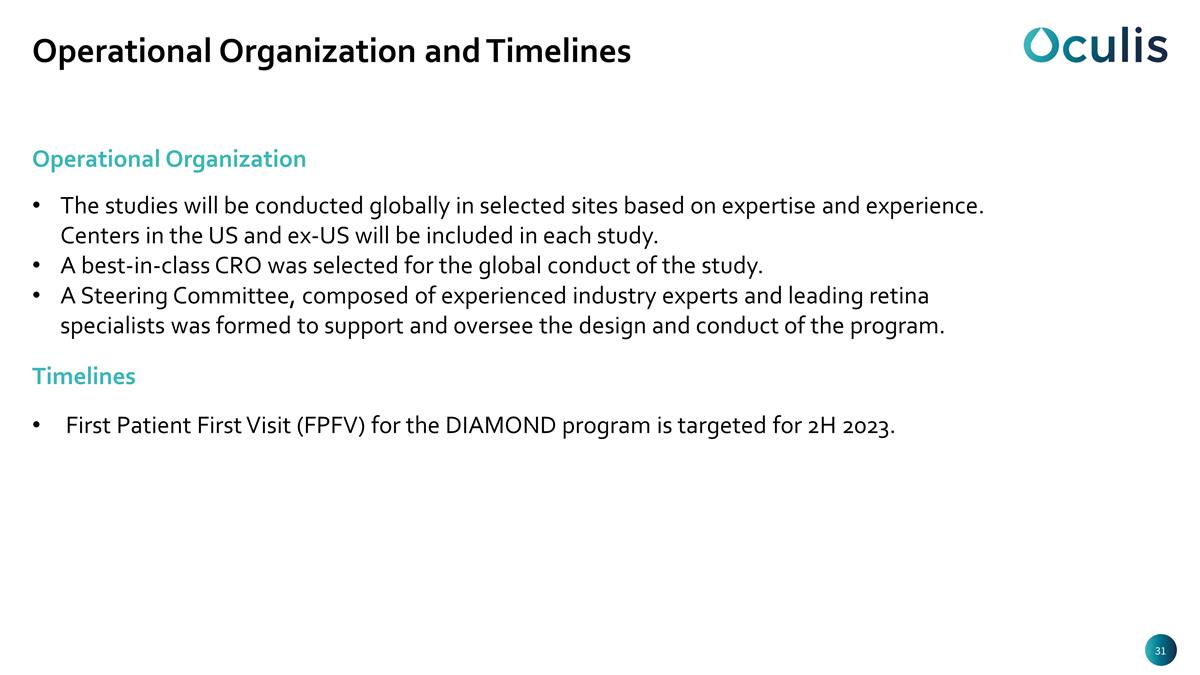
Operational Organization and Timelines The studies will be conducted globally in selected sites based on expertise and experience. Centers in the US and ex-US will be included in each study. A best-in-class CRO was selected for the global conduct of the study. A Steering Committee, composed of experienced industry experts and leading retina specialists was formed to support and oversee the design and conduct of the program. Operational Organization Timelines First Patient First Visit (FPFV) for the DIAMOND program is targeted for 2H 2023.
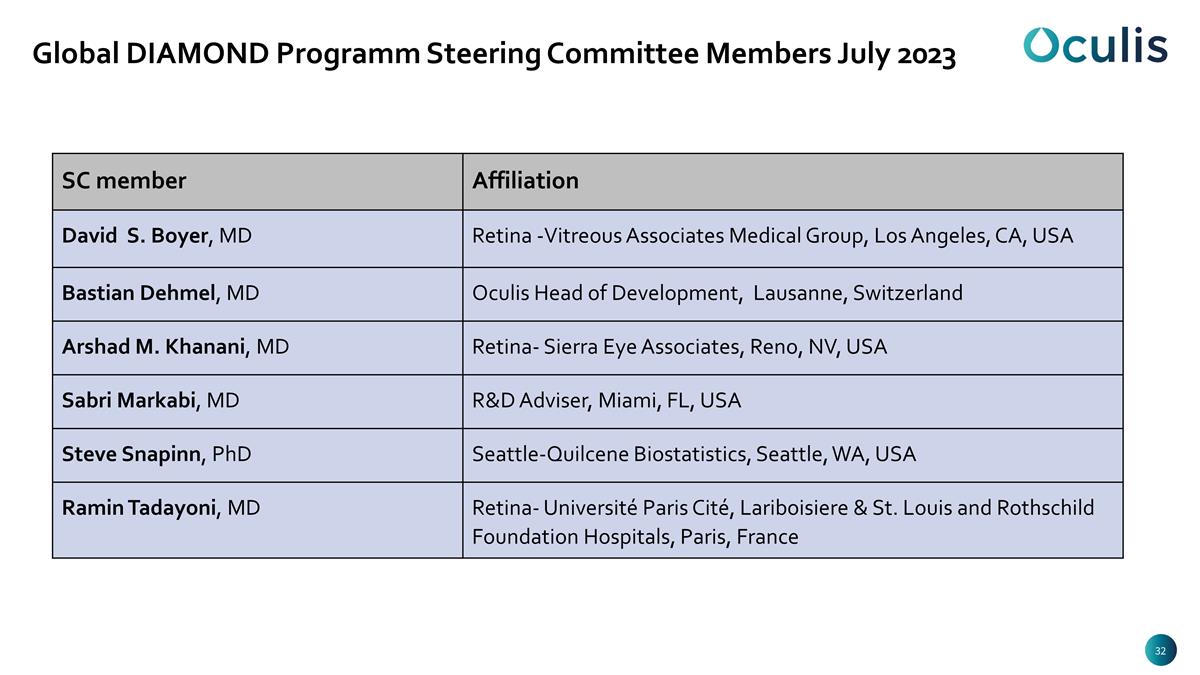
Global DIAMOND Programm Steering Committee Members July 2023 SC member Affiliation David S. Boyer, MD Retina -Vitreous Associates Medical Group, Los Angeles, CA, USA Bastian Dehmel, MD Oculis Head of Development, Lausanne, Switzerland Arshad M. Khanani, MD Retina- Sierra Eye Associates, Reno, NV, USA Sabri Markabi, MD R&D Adviser, Miami, FL, USA Steve Snapinn, PhD Seattle-Quilcene Biostatistics, Seattle, WA, USA Ramin Tadayoni, MD Retina- Université Paris Cité, Lariboisiere & St. Louis and Rothschild Foundation Hospitals, Paris, France
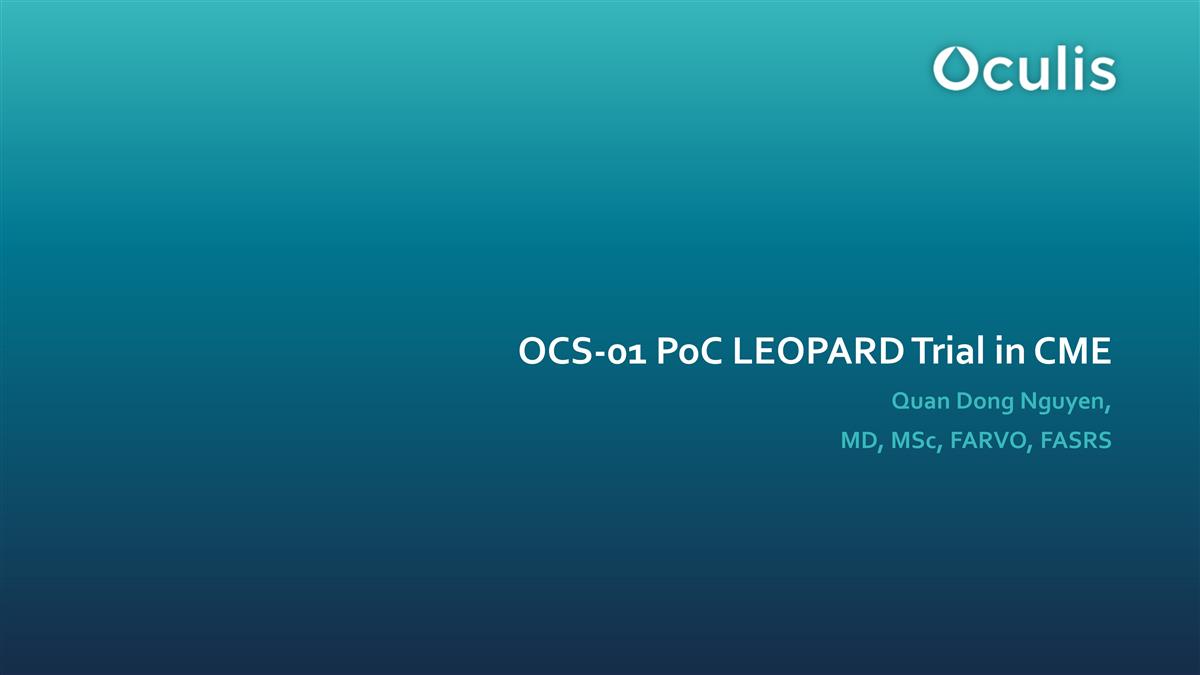
OCS-01 PoC LEOPARD Trial in CME Quan Dong Nguyen, MD, MSc, FARVO, FASRS
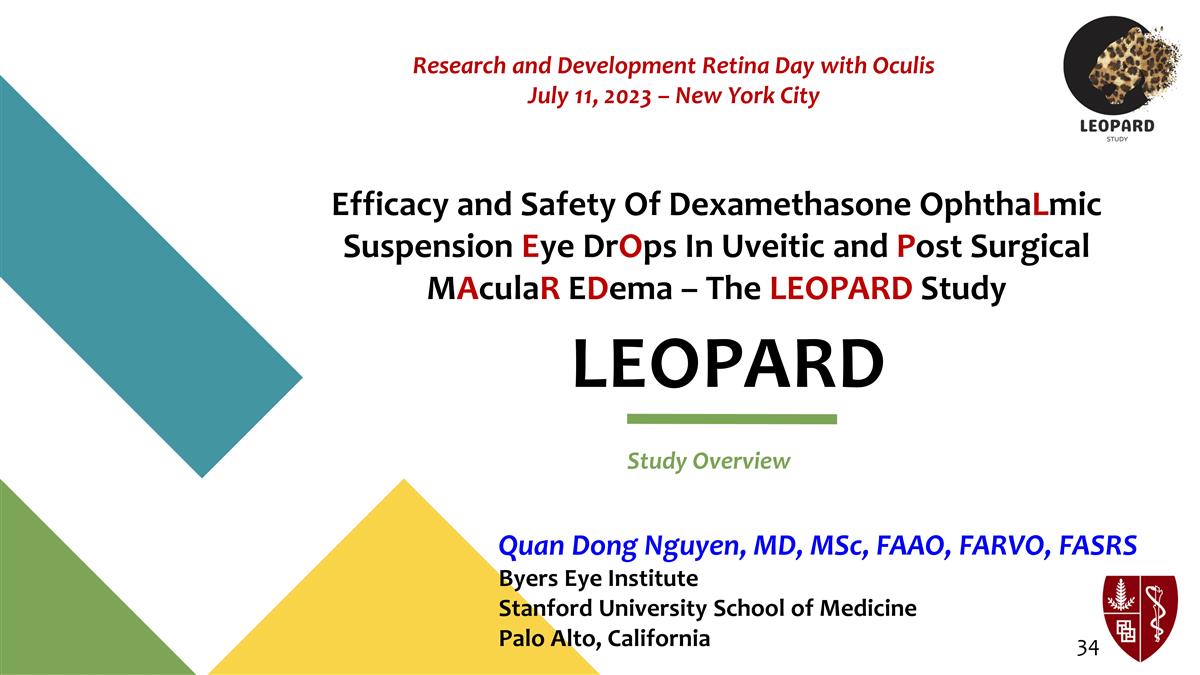
LEOPARD Study Overview Efficacy and Safety Of Dexamethasone OphthaLmic Suspension Eye DrOps In Uveitic and Post Surgical MAculaR EDema – The LEOPARD Study Research and Development Retina Day with Oculis July 11, 2023 – New York City Quan Dong Nguyen, MD, MSc, FAAO, FARVO, FASRS Byers Eye Institute Stanford University School of Medicine Palo Alto, California
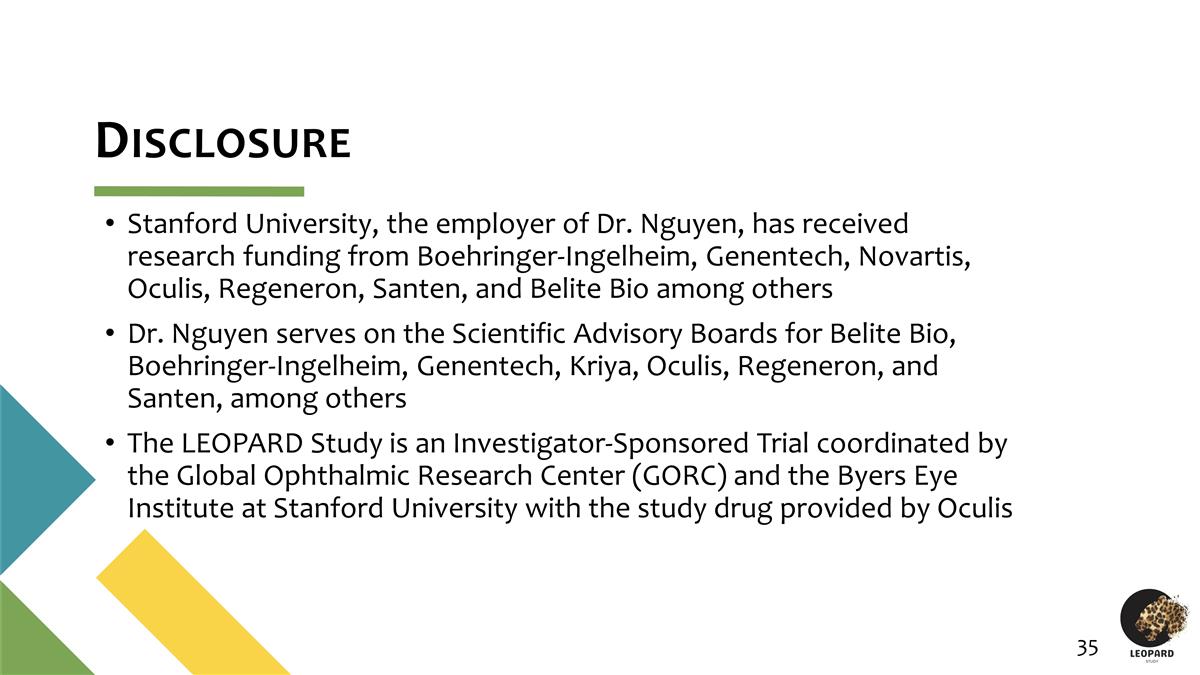
Disclosure Stanford University, the employer of Dr. Nguyen, has received research funding from Boehringer-Ingelheim, Genentech, Novartis, Oculis, Regeneron, Santen, and Belite Bio among others Dr. Nguyen serves on the Scientific Advisory Boards for Belite Bio, Boehringer-Ingelheim, Genentech, Kriya, Oculis, Regeneron, and Santen, among others The LEOPARD Study is an Investigator-Sponsored Trial coordinated by the Global Ophthalmic Research Center (GORC) and the Byers Eye Institute at Stanford University with the study drug provided by Oculis
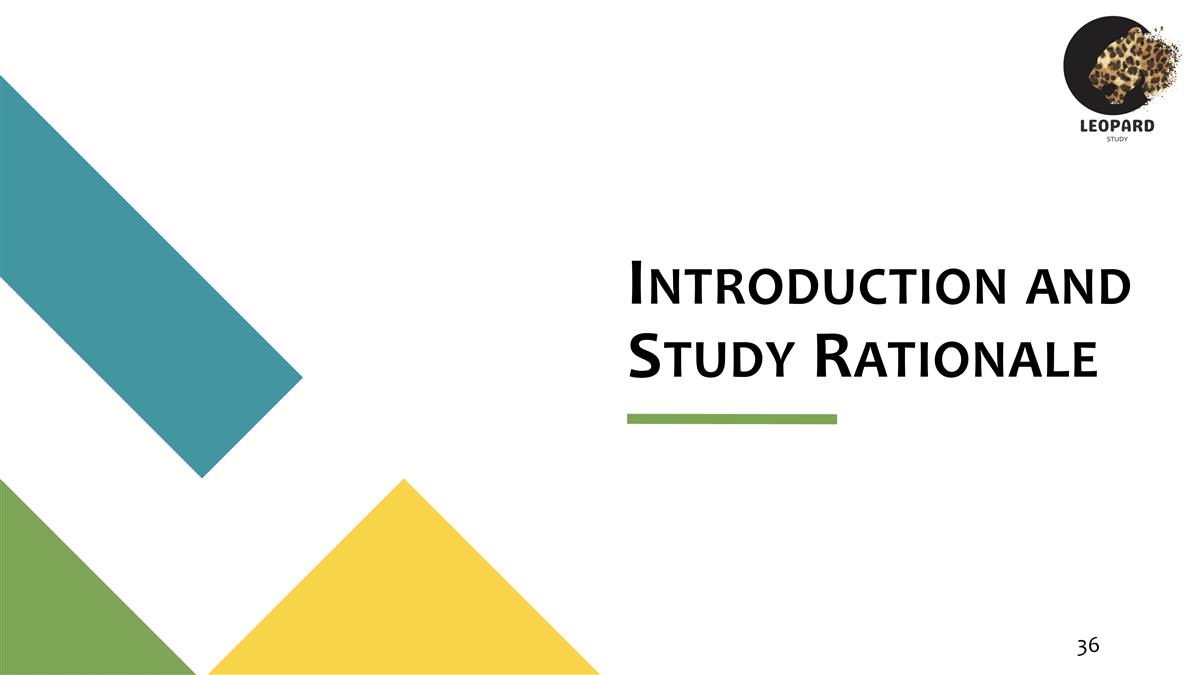
Introduction and Study Rationale
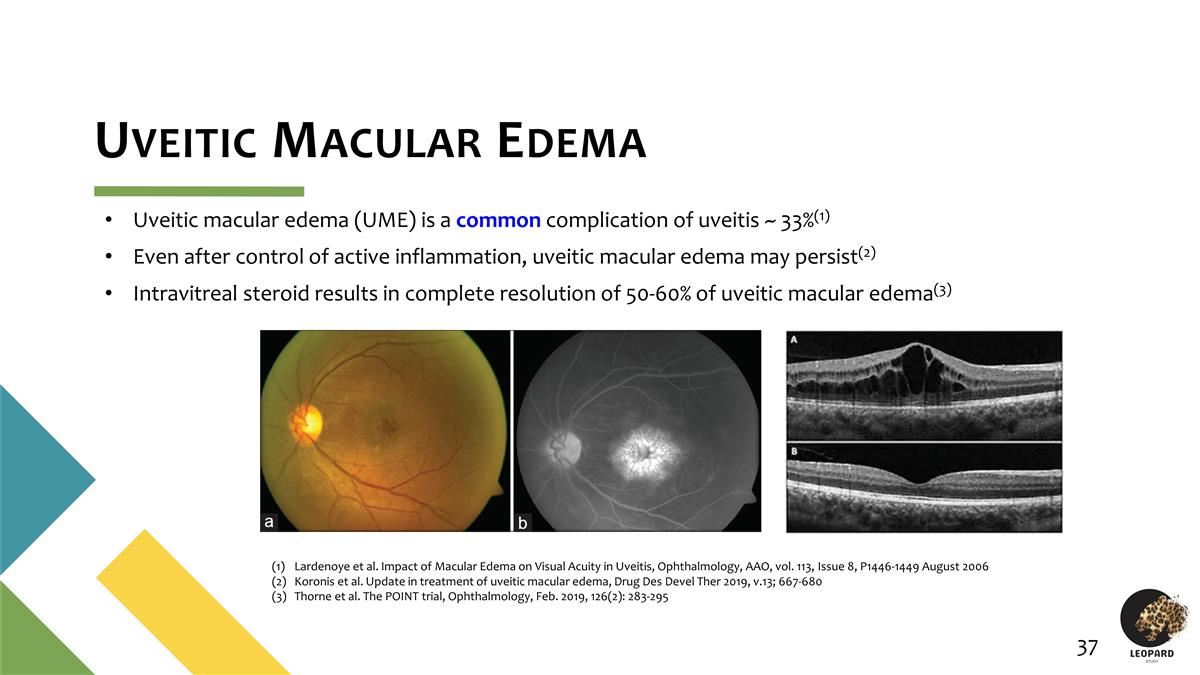
Uveitic Macular Edema Uveitic macular edema (UME) is a common complication of uveitis ~ 33%(1) Even after control of active inflammation, uveitic macular edema may persist(2) Intravitreal steroid results in complete resolution of 50-60% of uveitic macular edema(3) Lardenoye et al. Impact of Macular Edema on Visual Acuity in Uveitis, Ophthalmology, AAO, vol. 113, Issue 8, P1446-1449 August 2006 Koronis et al. Update in treatment of uveitic macular edema, Drug Des Devel Ther 2019, v.13; 667-680 Thorne et al. The POINT trial, Ophthalmology, Feb. 2019, 126(2): 283-295
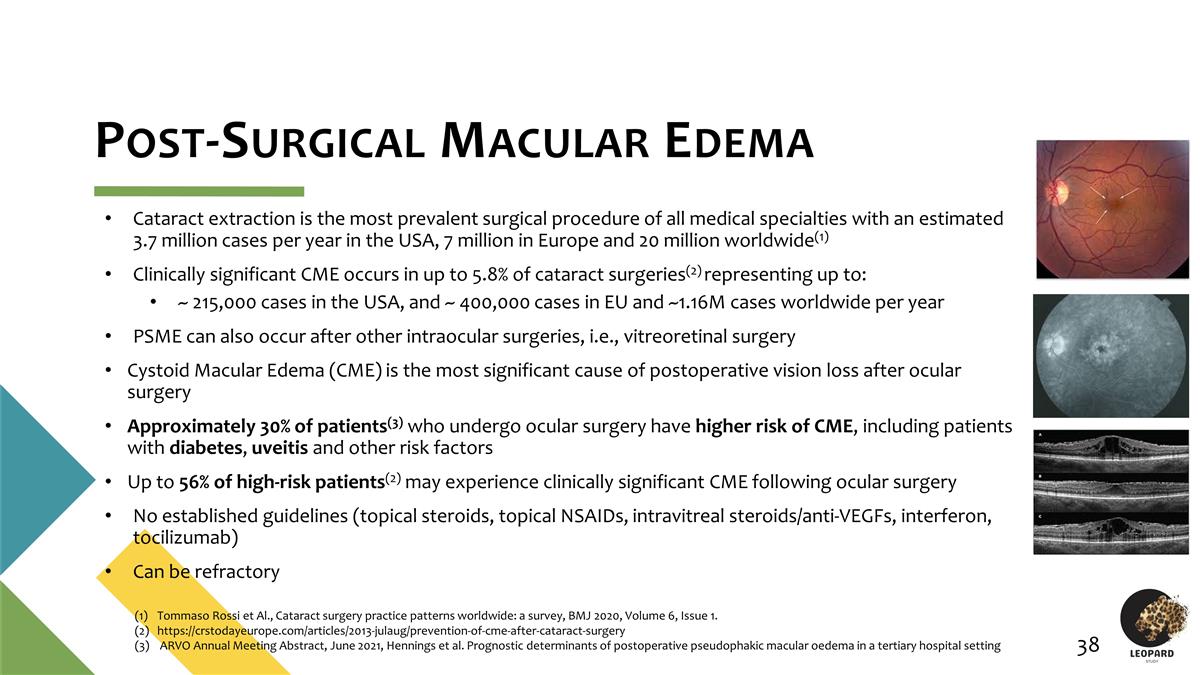
Post-Surgical Macular Edema Cataract extraction is the most prevalent surgical procedure of all medical specialties with an estimated 3.7 million cases per year in the USA, 7 million in Europe and 20 million worldwide(1) Clinically significant CME occurs in up to 5.8% of cataract surgeries(2) representing up to: ~ 215,000 cases in the USA, and ~ 400,000 cases in EU and ~1.16M cases worldwide per year PSME can also occur after other intraocular surgeries, i.e., vitreoretinal surgery Cystoid Macular Edema (CME) is the most significant cause of postoperative vision loss after ocular surgery Approximately 30% of patients(3) who undergo ocular surgery have higher risk of CME, including patients with diabetes, uveitis and other risk factors Up to 56% of high-risk patients(2) may experience clinically significant CME following ocular surgery No established guidelines (topical steroids, topical NSAIDs, intravitreal steroids/anti-VEGFs, interferon, tocilizumab) Can be refractory Tommaso Rossi et Al., Cataract surgery practice patterns worldwide: a survey, BMJ 2020, Volume 6, Issue 1. https://crstodayeurope.com/articles/2013-julaug/prevention-of-cme-after-cataract-surgery ARVO Annual Meeting Abstract, June 2021, Hennings et al. Prognostic determinants of postoperative pseudophakic macular oedema in a tertiary hospital setting
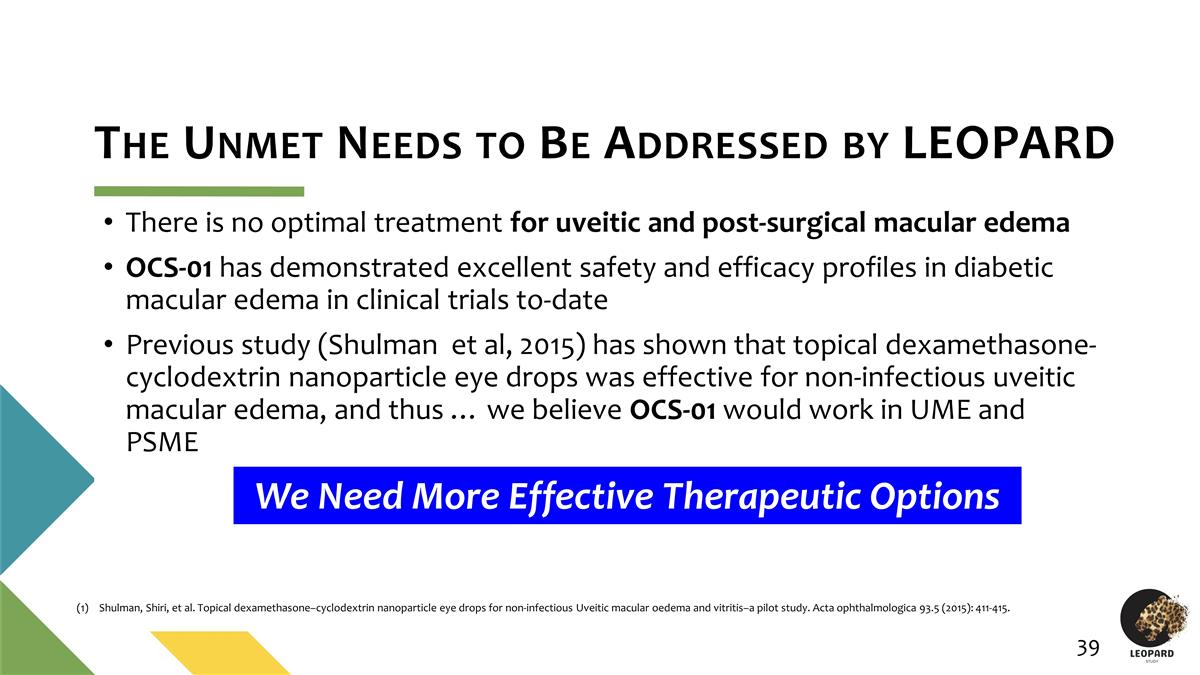
The Unmet Needs to Be Addressed by LEOPARD There is no optimal treatment for uveitic and post-surgical macular edema OCS-01 has demonstrated excellent safety and efficacy profiles in diabetic macular edema in clinical trials to-date Previous study (Shulman et al, 2015) has shown that topical dexamethasone-cyclodextrin nanoparticle eye drops was effective for non-infectious uveitic macular edema, and thus … we believe OCS-01 would work in UME and PSME We Need More Effective Therapeutic Options Shulman, Shiri, et al. Topical dexamethasone–cyclodextrin nanoparticle eye drops for non‐infectious Uveitic macular oedema and vitritis–a pilot study. Acta ophthalmologica 93.5 (2015): 411-415.
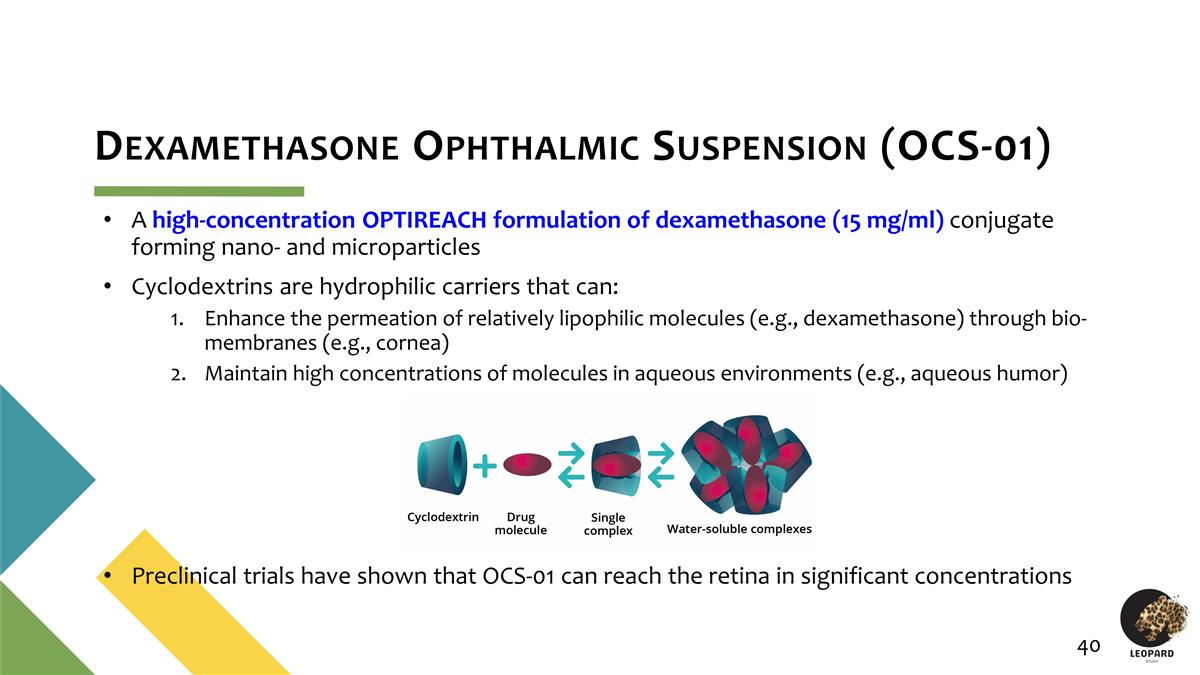
Dexamethasone Ophthalmic Suspension (OCS-01) A high-concentration OPTIREACH formulation of dexamethasone (15 mg/ml) conjugate forming nano- and microparticles Cyclodextrins are hydrophilic carriers that can: Enhance the permeation of relatively lipophilic molecules (e.g., dexamethasone) through bio-membranes (e.g., cornea) Maintain high concentrations of molecules in aqueous environments (e.g., aqueous humor) Preclinical trials have shown that OCS-01 can reach the retina in significant concentrations High-concentration OPTIREACH® formulation of dexamethasone (15 mg/ml) High-concentration OPTIREACH® formulation of dexamethasone (15 mg/ml)
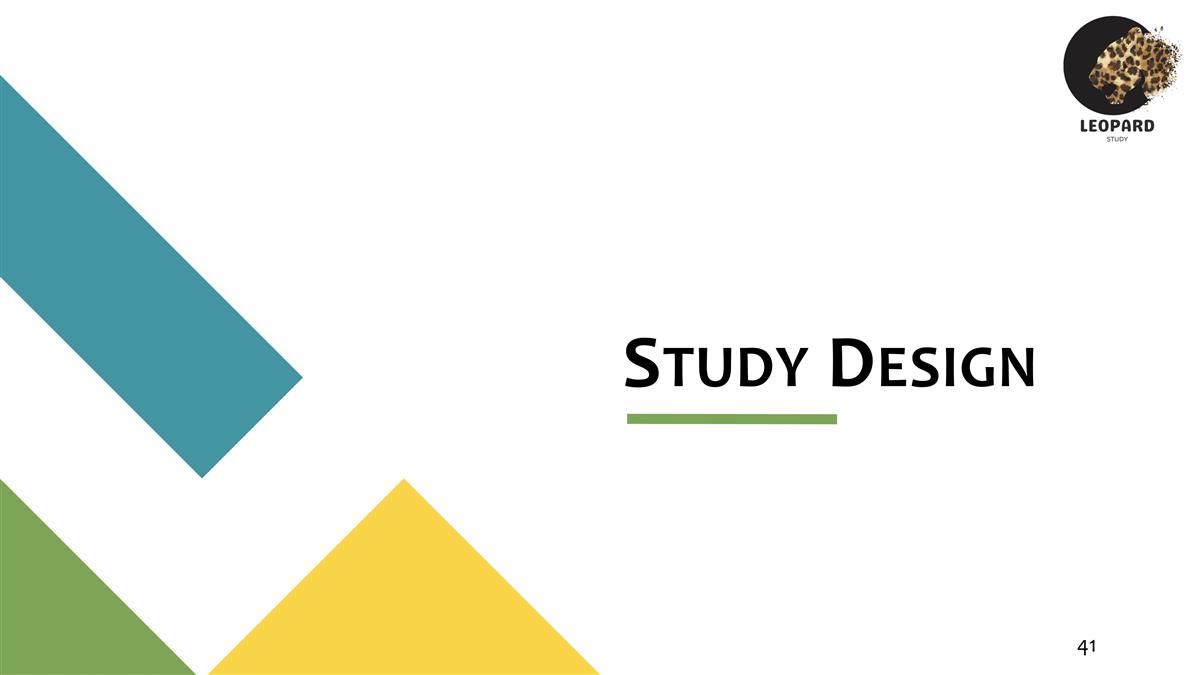
Study Design
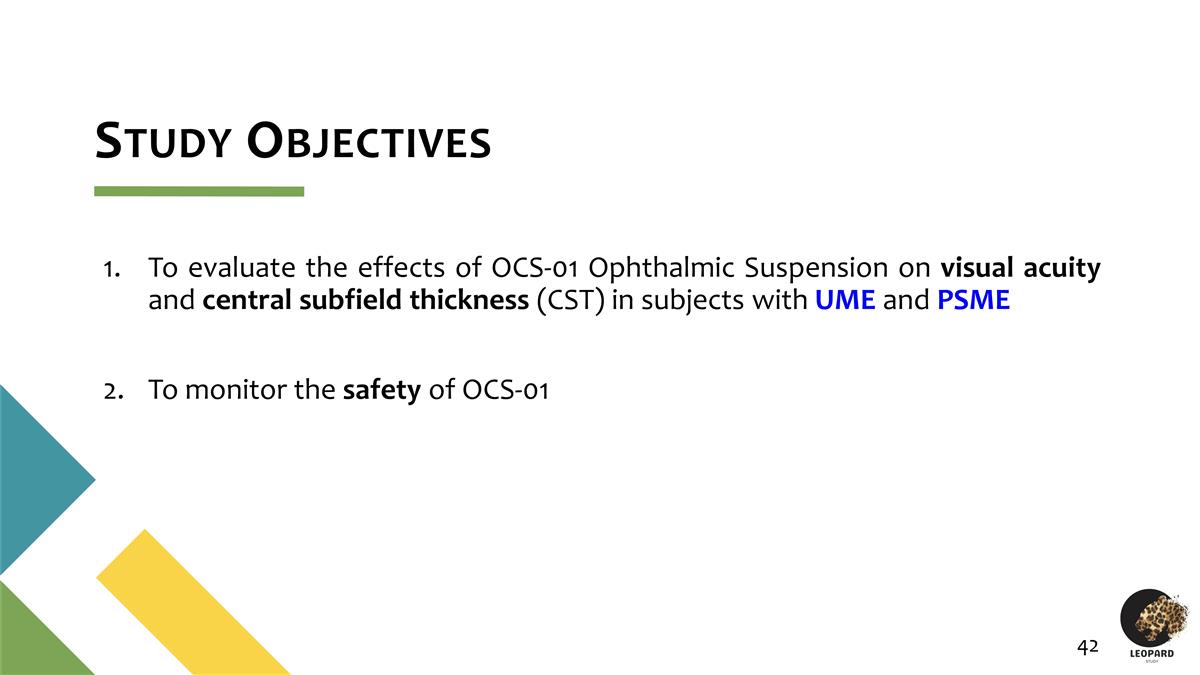
Study Objectives To evaluate the effects of OCS-01 Ophthalmic Suspension on visual acuity and central subfield thickness (CST) in subjects with UME and PSME To monitor the safety of OCS-01
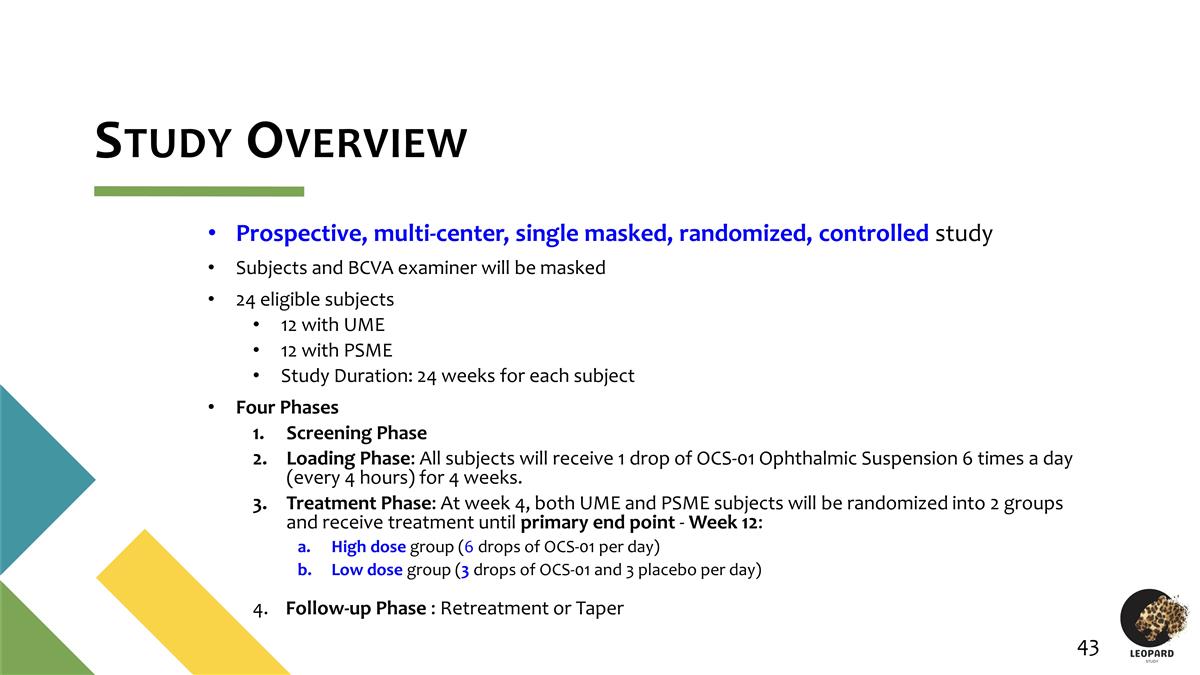
Study Overview Prospective, multi-center, single masked, randomized, controlled study Subjects and BCVA examiner will be masked 24 eligible subjects 12 with UME 12 with PSME Study Duration: 24 weeks for each subject Four Phases Screening Phase Loading Phase: All subjects will receive 1 drop of OCS-01 Ophthalmic Suspension 6 times a day (every 4 hours) for 4 weeks. Treatment Phase: At week 4, both UME and PSME subjects will be randomized into 2 groups and receive treatment until primary end point - Week 12: High dose group (6 drops of OCS-01 per day) Low dose group (3 drops of OCS-01 and 3 placebo per day) 4. Follow-up Phase : Retreatment or Taper
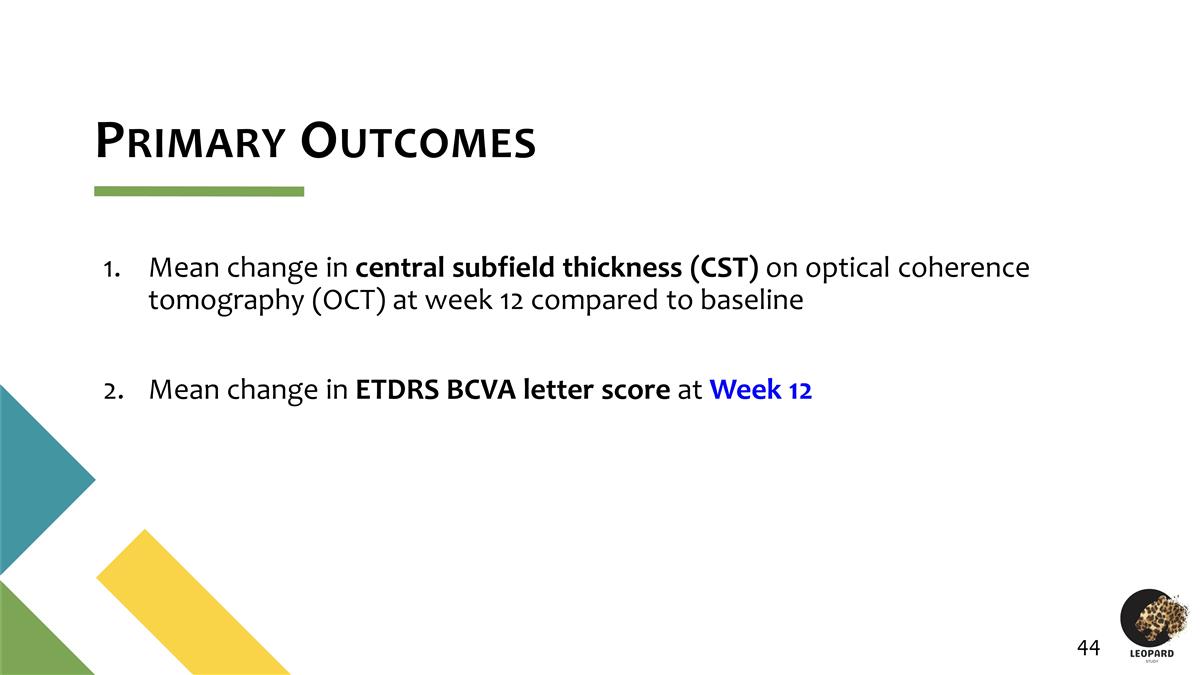
Primary Outcomes Mean change in central subfield thickness (CST) on optical coherence tomography (OCT) at week 12 compared to baseline Mean change in ETDRS BCVA letter score at Week 12
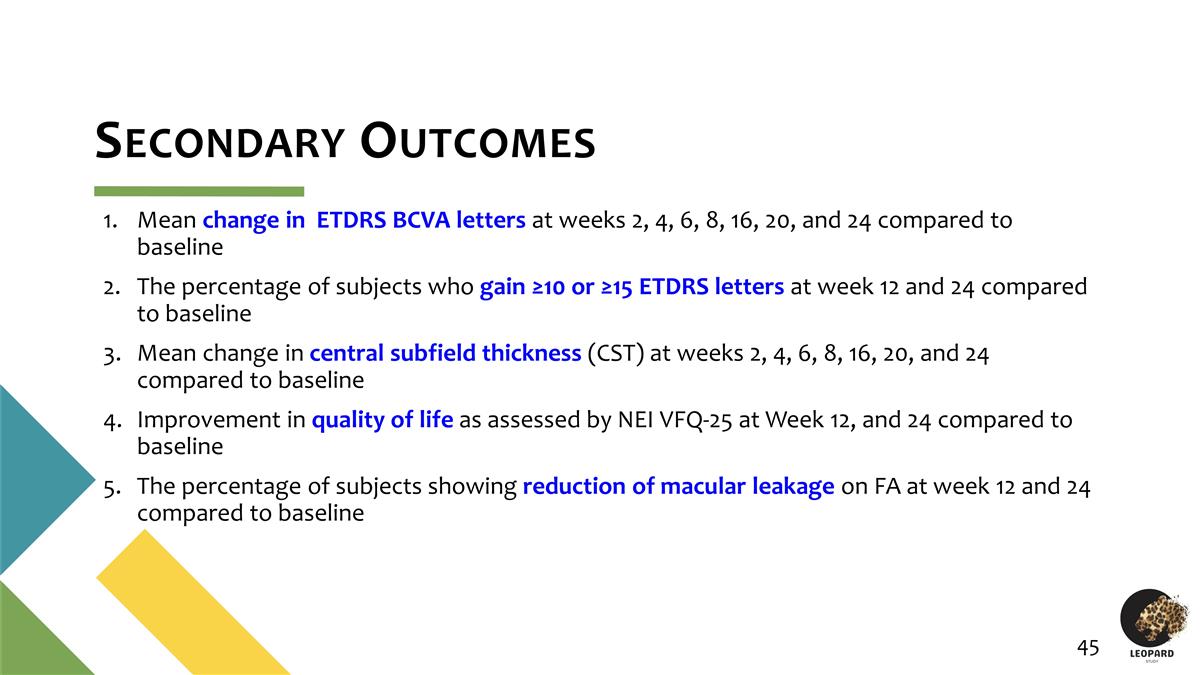
Secondary Outcomes Mean change in ETDRS BCVA letters at weeks 2, 4, 6, 8, 16, 20, and 24 compared to baseline The percentage of subjects who gain ≥10 or ≥15 ETDRS letters at week 12 and 24 compared to baseline Mean change in central subfield thickness (CST) at weeks 2, 4, 6, 8, 16, 20, and 24 compared to baseline Improvement in quality of life as assessed by NEI VFQ-25 at Week 12, and 24 compared to baseline The percentage of subjects showing reduction of macular leakage on FA at week 12 and 24 compared to baseline
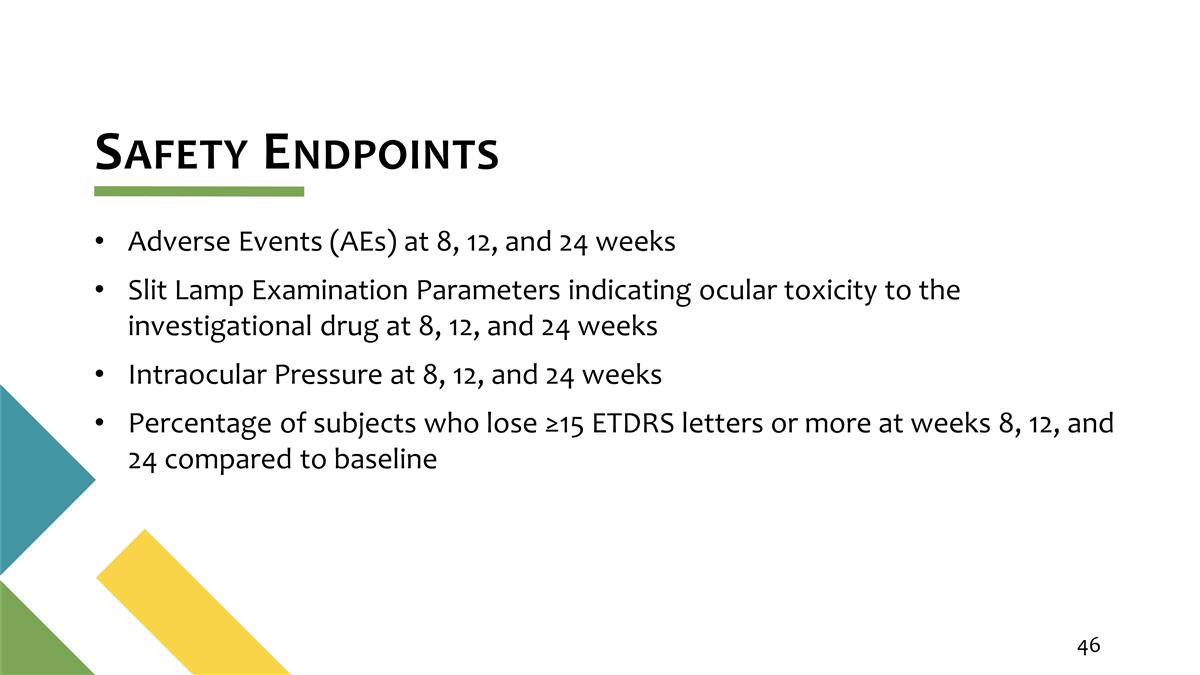
Safety Endpoints Adverse Events (AEs) at 8, 12, and 24 weeks Slit Lamp Examination Parameters indicating ocular toxicity to the investigational drug at 8, 12, and 24 weeks Intraocular Pressure at 8, 12, and 24 weeks Percentage of subjects who lose ≥15 ETDRS letters or more at weeks 8, 12, and 24 compared to baseline
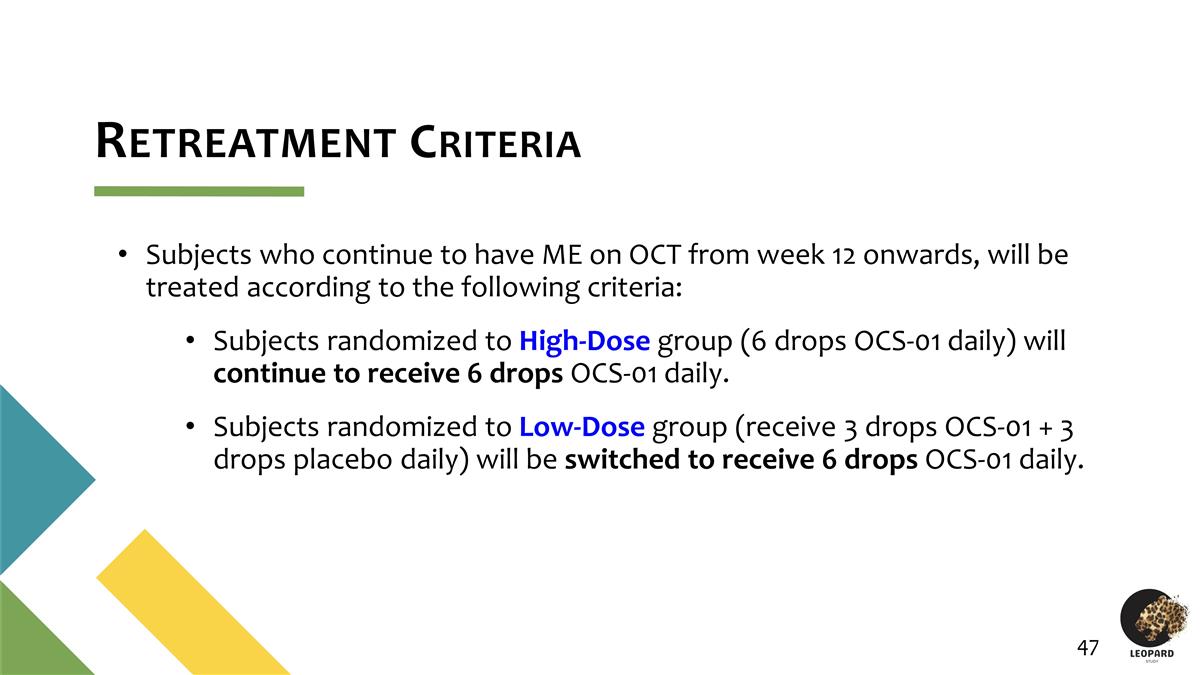
Retreatment Criteria Subjects who continue to have ME on OCT from week 12 onwards, will be treated according to the following criteria: Subjects randomized to High-Dose group (6 drops OCS-01 daily) will continue to receive 6 drops OCS-01 daily. Subjects randomized to Low-Dose group (receive 3 drops OCS-01 + 3 drops placebo daily) will be switched to receive 6 drops OCS-01 daily.
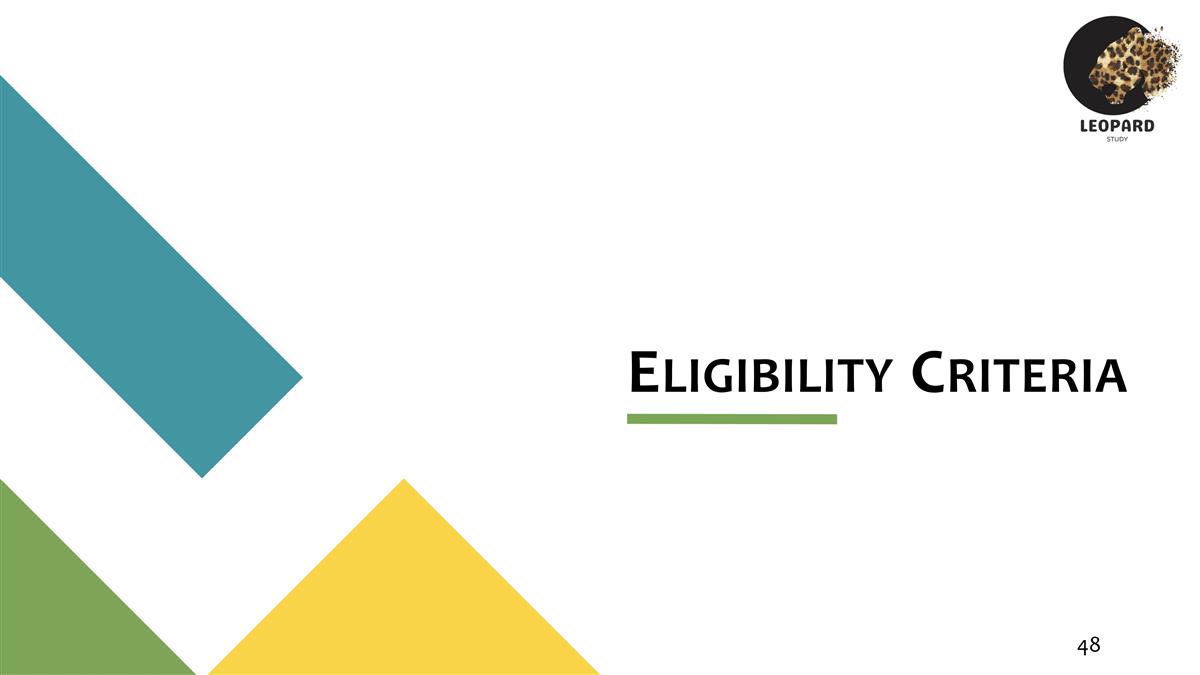
Eligibility Criteria
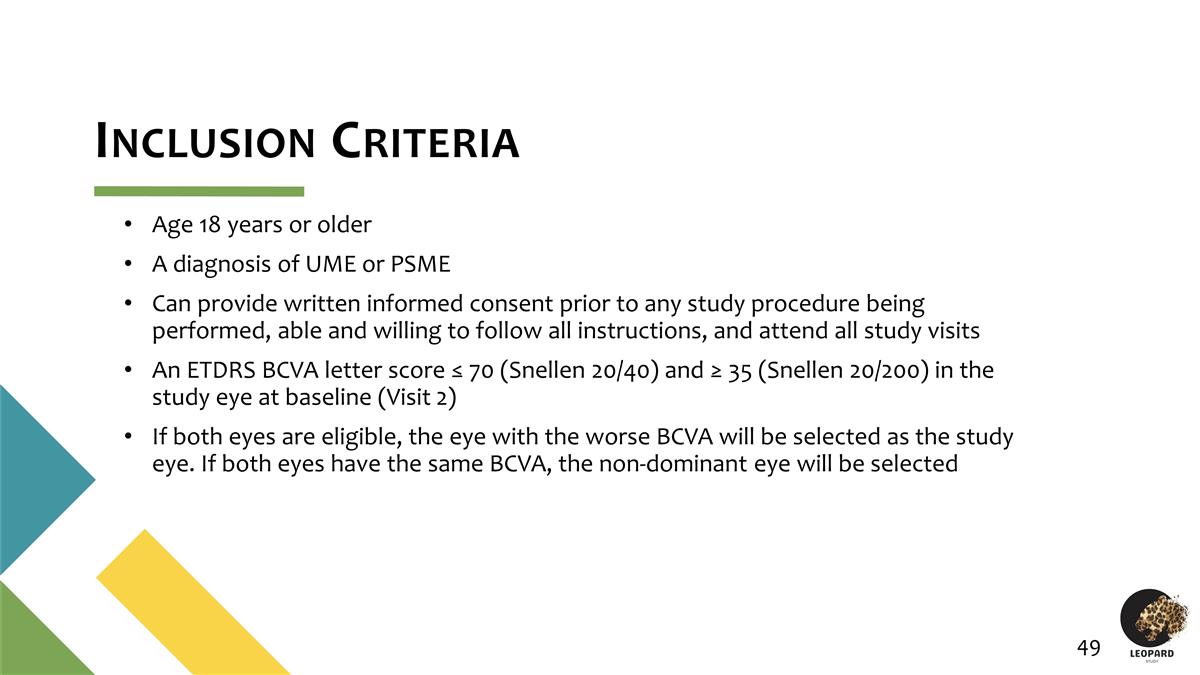
Inclusion Criteria Age 18 years or older A diagnosis of UME or PSME Can provide written informed consent prior to any study procedure being performed, able and willing to follow all instructions, and attend all study visits An ETDRS BCVA letter score ≤ 70 (Snellen 20/40) and ≥ 35 (Snellen 20/200) in the study eye at baseline (Visit 2) If both eyes are eligible, the eye with the worse BCVA will be selected as the study eye. If both eyes have the same BCVA, the non-dominant eye will be selected
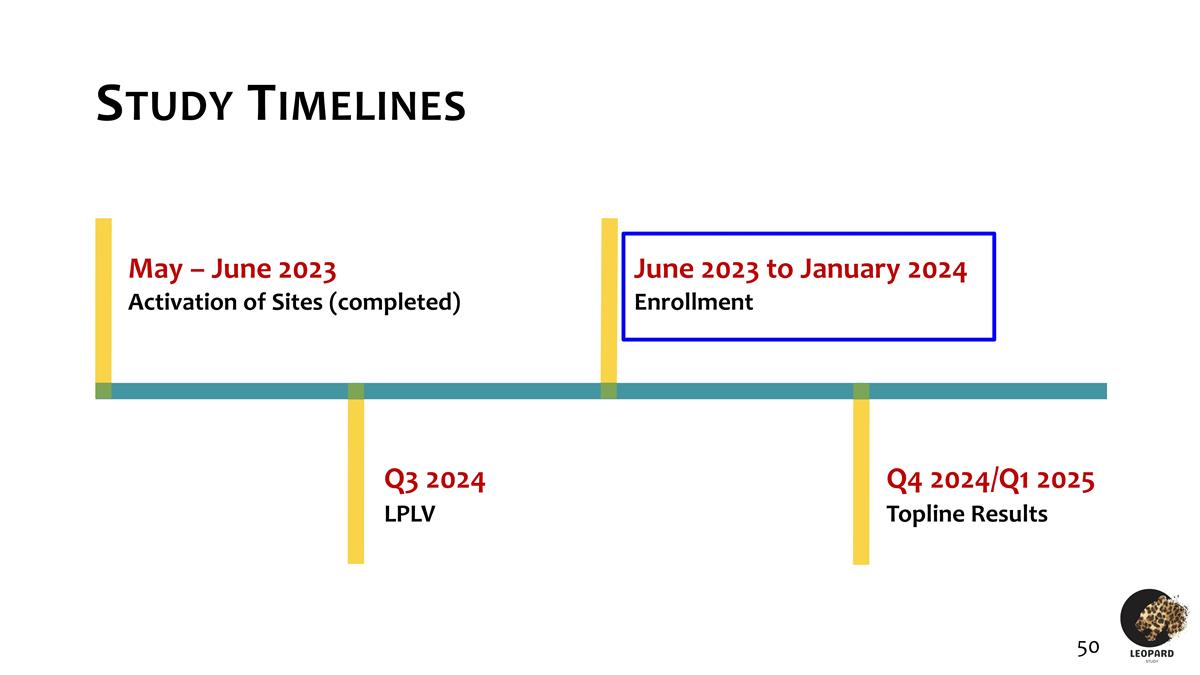
Study Timelines Activation of Sites (completed) May – June 2023 LPLV Q3 2024 Topline Results Q4 2024/Q1 2025 Enrollment June 2023 to January 2024
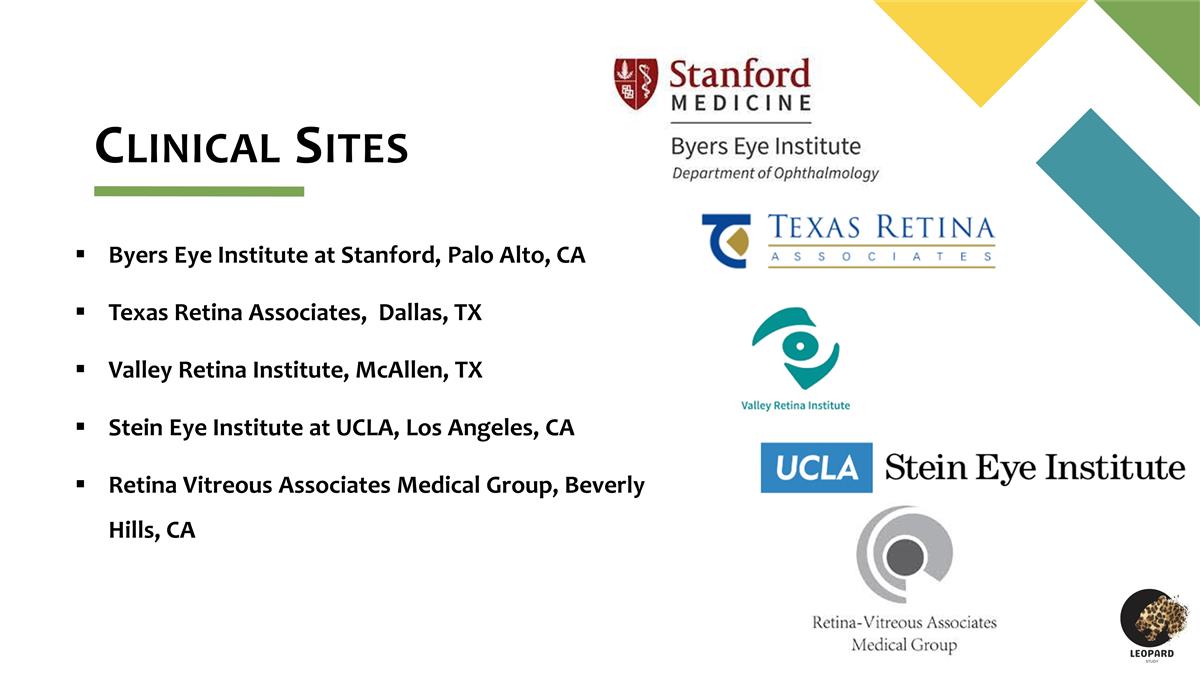
Clinical Sites Byers Eye Institute at Stanford, Palo Alto, CA Texas Retina Associates, Dallas, TX Valley Retina Institute, McAllen, TX Stein Eye Institute at UCLA, Los Angeles, CA Retina Vitreous Associates Medical Group, Beverly Hills, CA
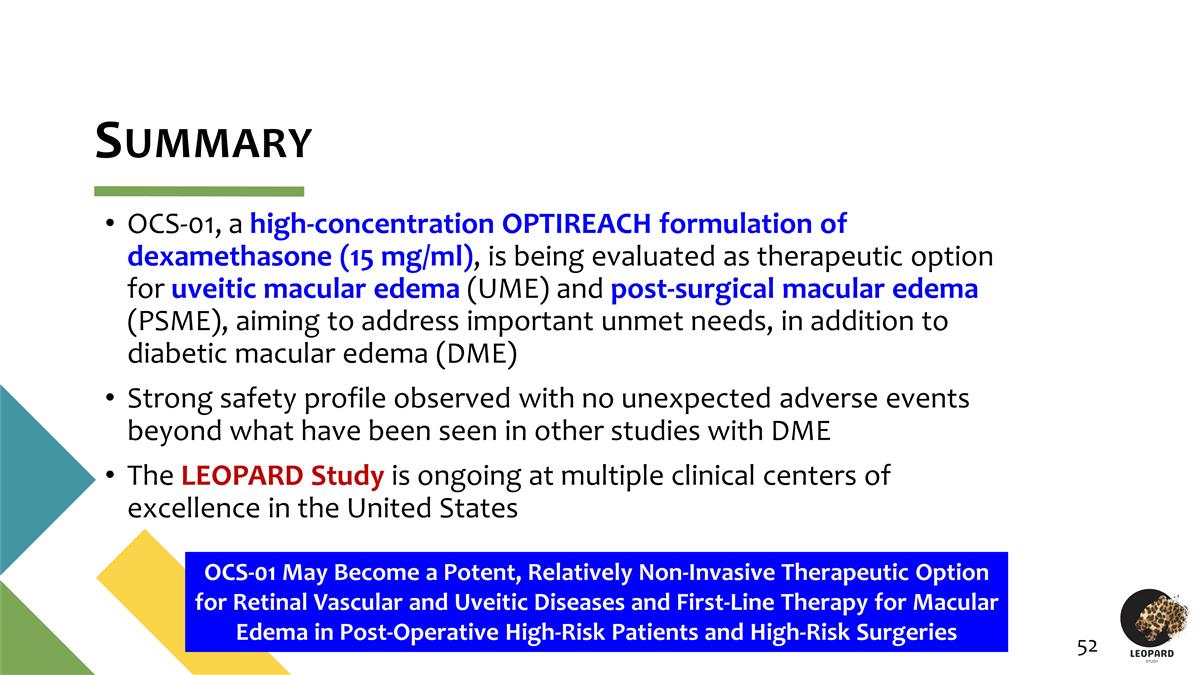
Summary OCS-01, a high-concentration OPTIREACH formulation of dexamethasone (15 mg/ml), is being evaluated as therapeutic option for uveitic macular edema (UME) and post-surgical macular edema (PSME), aiming to address important unmet needs, in addition to diabetic macular edema (DME) Strong safety profile observed with no unexpected adverse events beyond what have been seen in other studies with DME The LEOPARD Study is ongoing at multiple clinical centers of excellence in the United States OCS-01 May Become a Potent, Relatively Non-Invasive Therapeutic Option for Retinal Vascular and Uveitic Diseases and First-Line Therapy for Macular Edema in Post-Operative High-Risk Patients and High-Risk Surgeries

Thank You
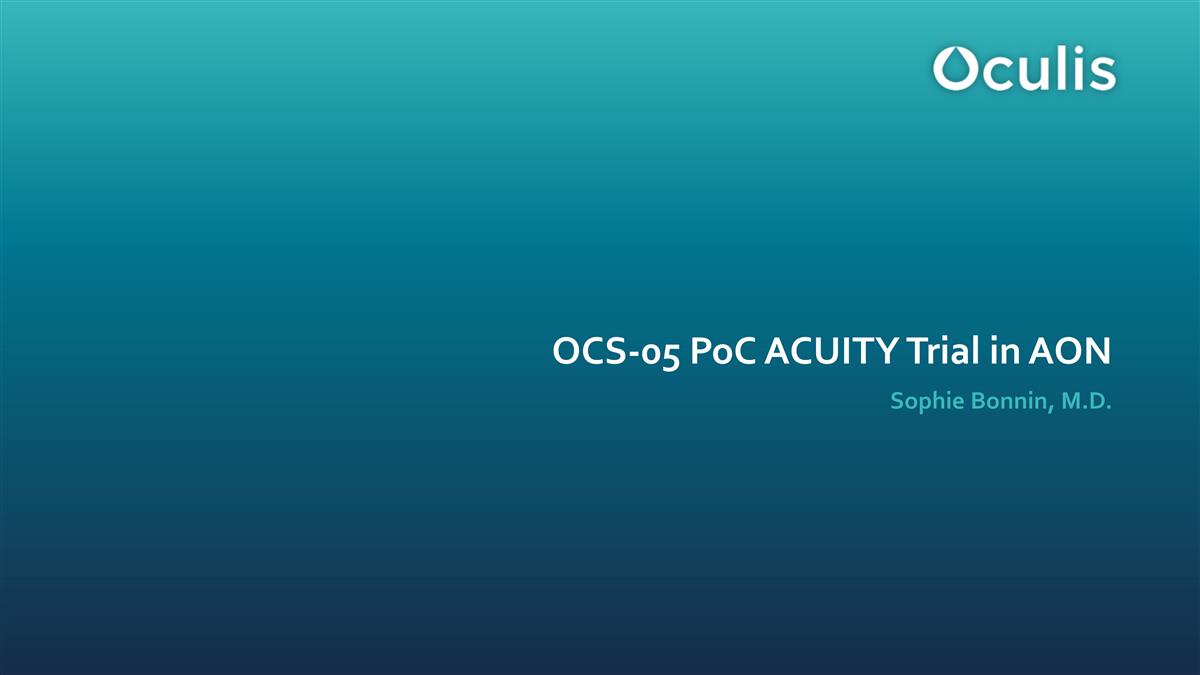
OCS-05 PoC ACUITY Trial in AON Sophie Bonnin, M.D.
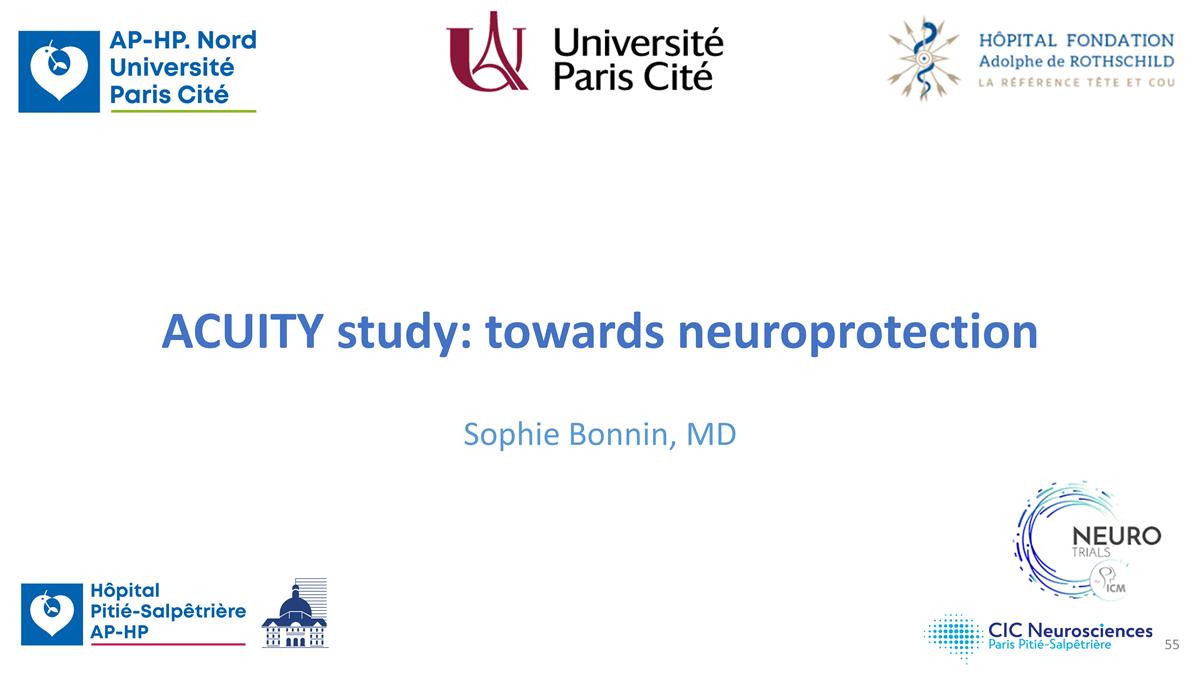
ACUITY study: towards neuroprotection Sophie Bonnin, MD
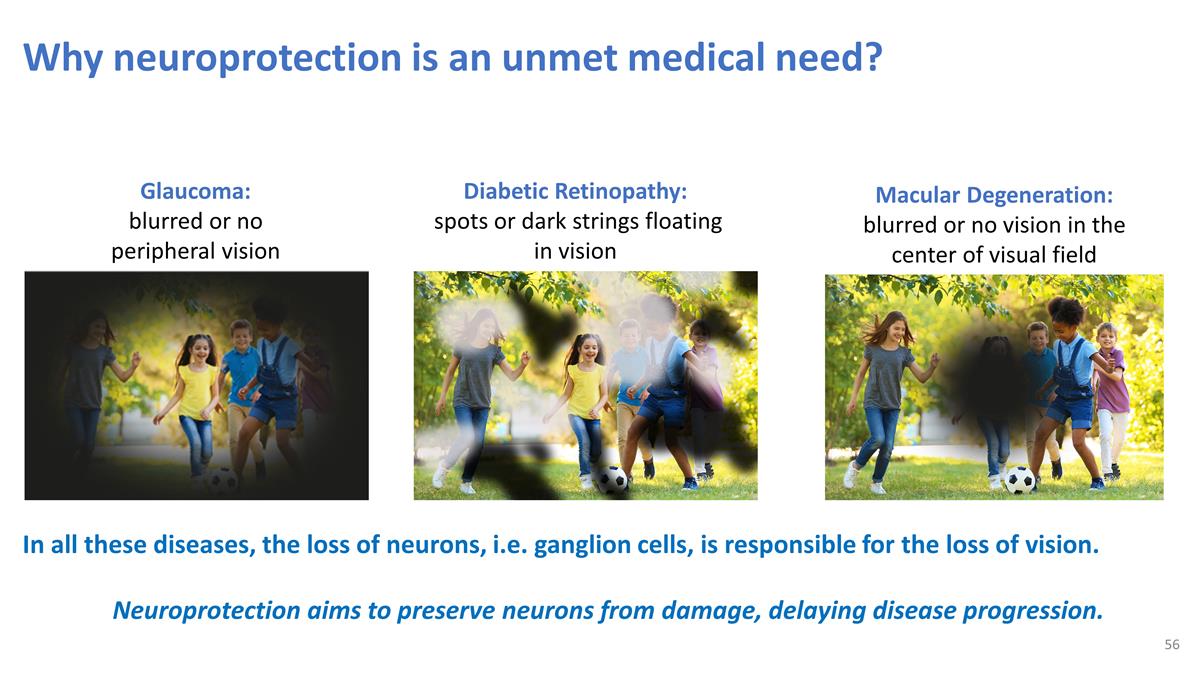
Glaucoma: blurred or no peripheral vision Macular Degeneration: blurred or no vision in the center of visual field Diabetic Retinopathy: spots or dark strings floating in vision In all these diseases, the loss of neurons, i.e. ganglion cells, is responsible for the loss of vision. Neuroprotection aims to preserve neurons from damage, delaying disease progression. Why neuroprotection is an unmet medical need?
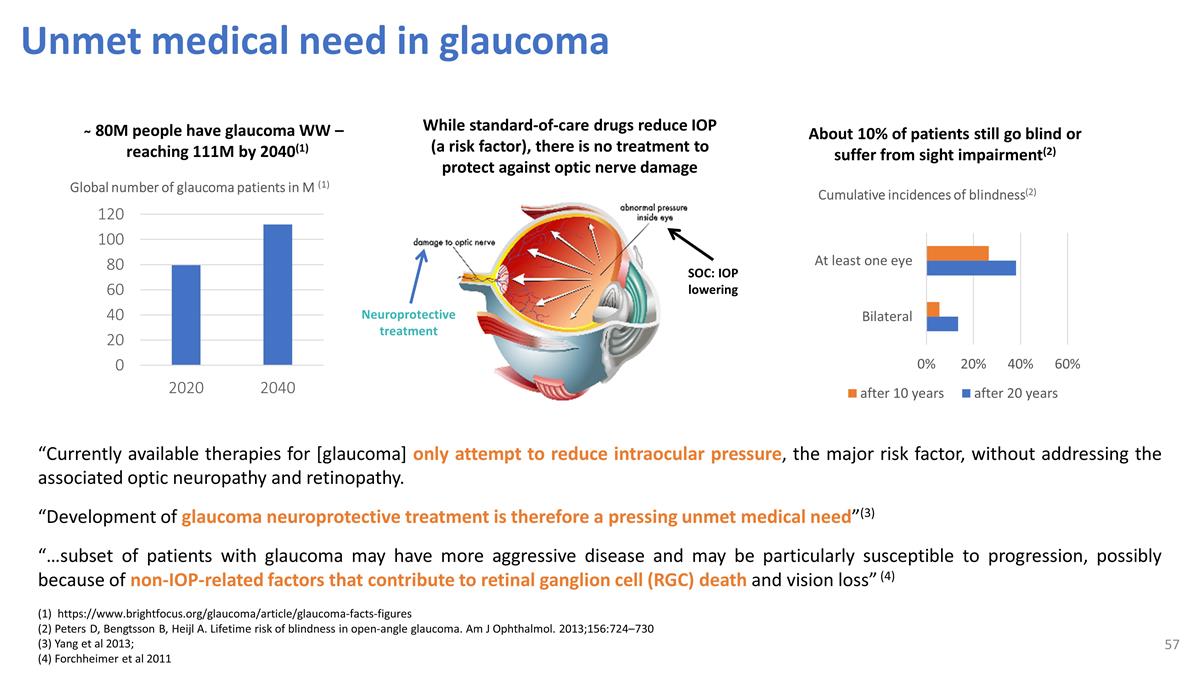
Unmet medical need in glaucoma Cumulative incidences of blindness(2) “Currently available therapies for [glaucoma] only attempt to reduce intraocular pressure, the major risk factor, without addressing the associated optic neuropathy and retinopathy. “Development of glaucoma neuroprotective treatment is therefore a pressing unmet medical need”(3) “…subset of patients with glaucoma may have more aggressive disease and may be particularly susceptible to progression, possibly because of non-IOP-related factors that contribute to retinal ganglion cell (RGC) death and vision loss” (4) ̴ 80M people have glaucoma WW – reaching 111M by 2040(1) About 10% of patients still go blind or suffer from sight impairment(2) Global number of glaucoma patients in M (1) (1) https://www.brightfocus.org/glaucoma/article/glaucoma-facts-figures (2) Peters D, Bengtsson B, Heijl A. Lifetime risk of blindness in open-angle glaucoma. Am J Ophthalmol. 2013;156:724–730 (3) Yang et al 2013; (4) Forchheimer et al 2011 While standard-of-care drugs reduce IOP (a risk factor), there is no treatment to protect against optic nerve damage SOC: IOP lowering Neuroprotective treatment
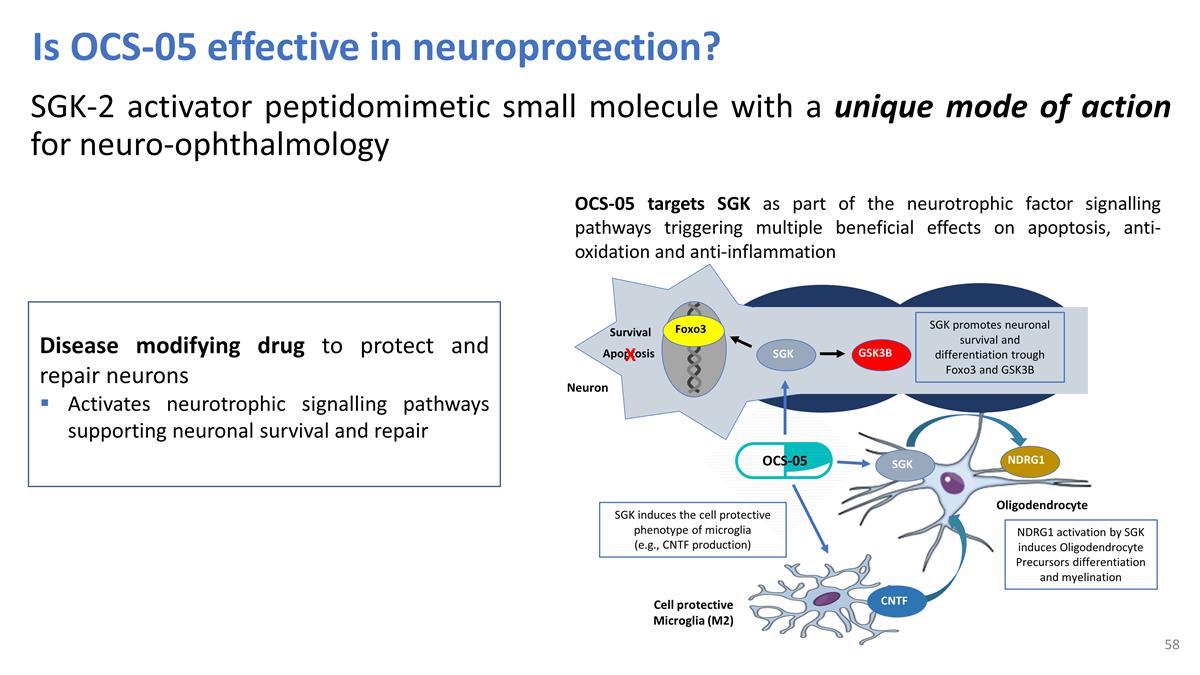
SGK-2 activator peptidomimetic small molecule with a unique mode of action for neuro-ophthalmology OCS-05 targets SGK as part of the neurotrophic factor signalling pathways triggering multiple beneficial effects on apoptosis, anti-oxidation and anti-inflammation Disease modifying drug to protect and repair neurons Activates neurotrophic signalling pathways supporting neuronal survival and repair Survival Oligodendrocyte Neuron Foxo3 Apoptosis X GSK3B SGK Cell protective Microglia (M2) NDRG1 OCS-05 CNTF SGK promotes neuronal survival and differentiation trough Foxo3 and GSK3B NDRG1 activation by SGK induces Oligodendrocyte Precursors differentiation and myelination SGK induces the cell protective phenotype of microglia (e.g., CNTF production) SGK Is OCS-05 effective in neuroprotection?
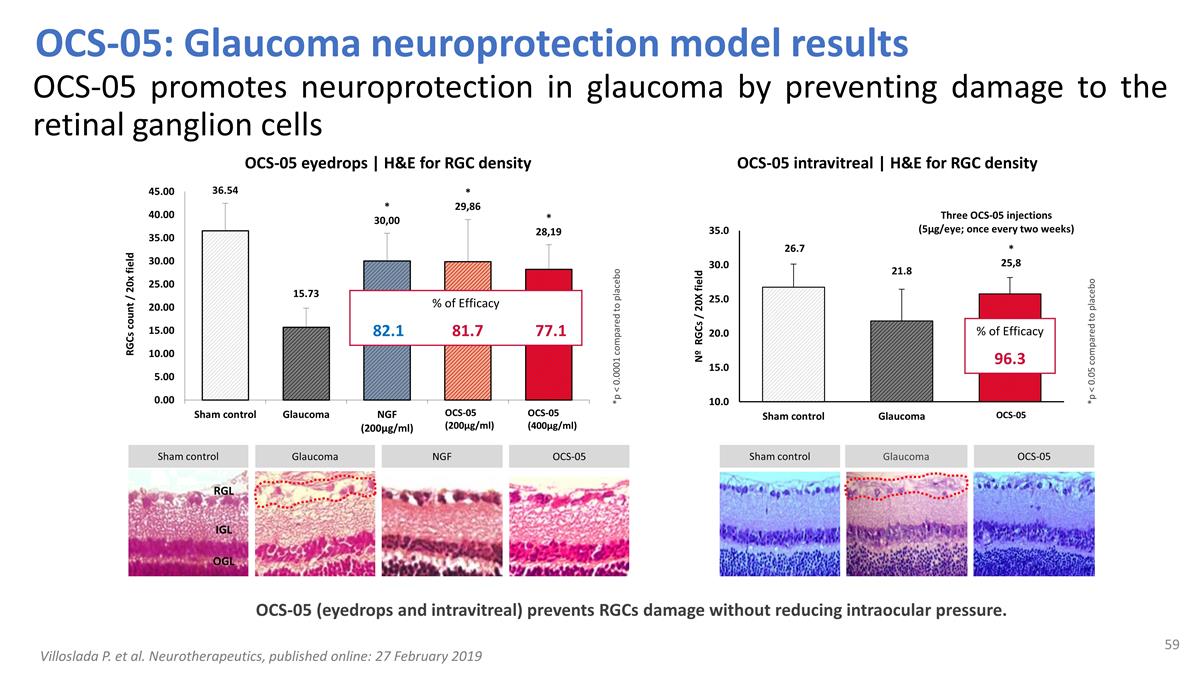
OCS-05: Glaucoma neuroprotection model results OCS-05 promotes neuroprotection in glaucoma by preventing damage to the retinal ganglion cells RGL IGL OGL Sham control NGF OCS-05 Sham control Glaucoma OCS-05 Glaucoma OCS-05 intravitreal | H&E for RGC density % of Efficacy 82.1 81.7 77.1 *p < 0.0001 compared to placebo OCS-05 eyedrops | H&E for RGC density *p < 0.05 compared to placebo % of Efficacy 96.3 OCS-05 (eyedrops and intravitreal) prevents RGCs damage without reducing intraocular pressure. Villoslada P. et al. Neurotherapeutics, published online: 27 February 2019 OCS-05 (400µg/ml) OCS-05 (200µg/ml) OCS-05
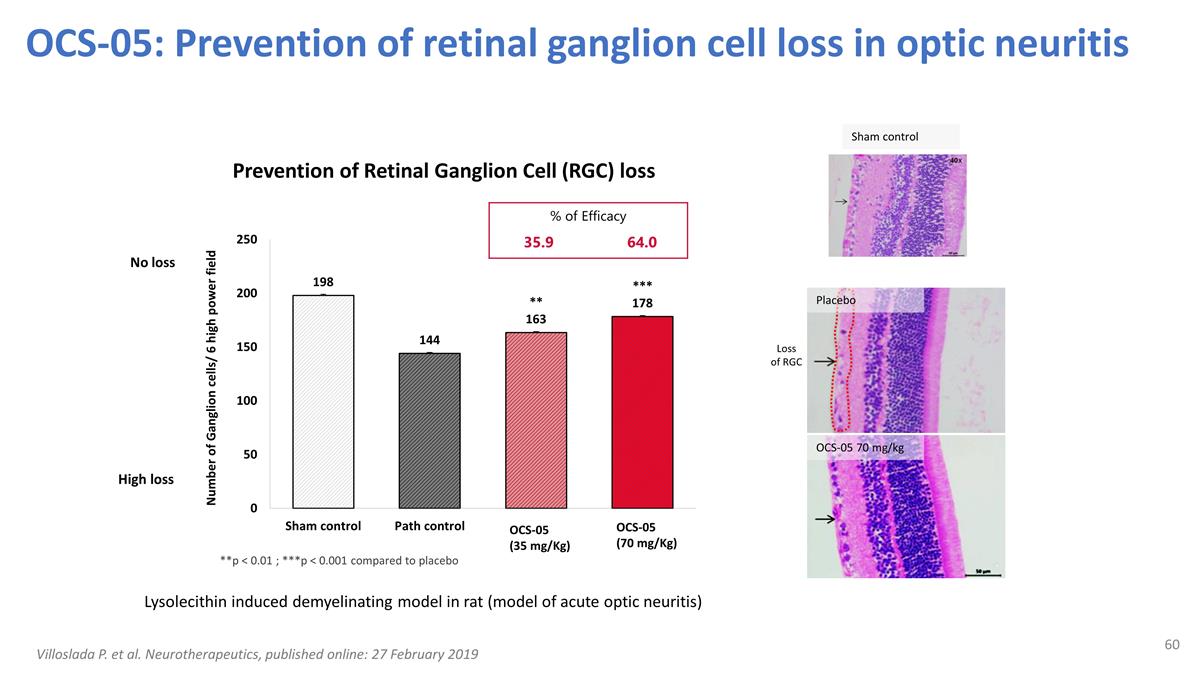
OCS-05: Prevention of retinal ganglion cell loss in optic neuritis **p < 0.01 ; ***p < 0.001 compared to placebo Prevention of Retinal Ganglion Cell (RGC) loss Sham control Loss of RGC Placebo OCS-05 70 mg/kg % of Efficacy 35.9 64.0 Lysolecithin induced demyelinating model in rat (model of acute optic neuritis) High loss No loss OCS-05 (70 mg/Kg) OCS-05 (35 mg/Kg) Villoslada P. et al. Neurotherapeutics, published online: 27 February 2019
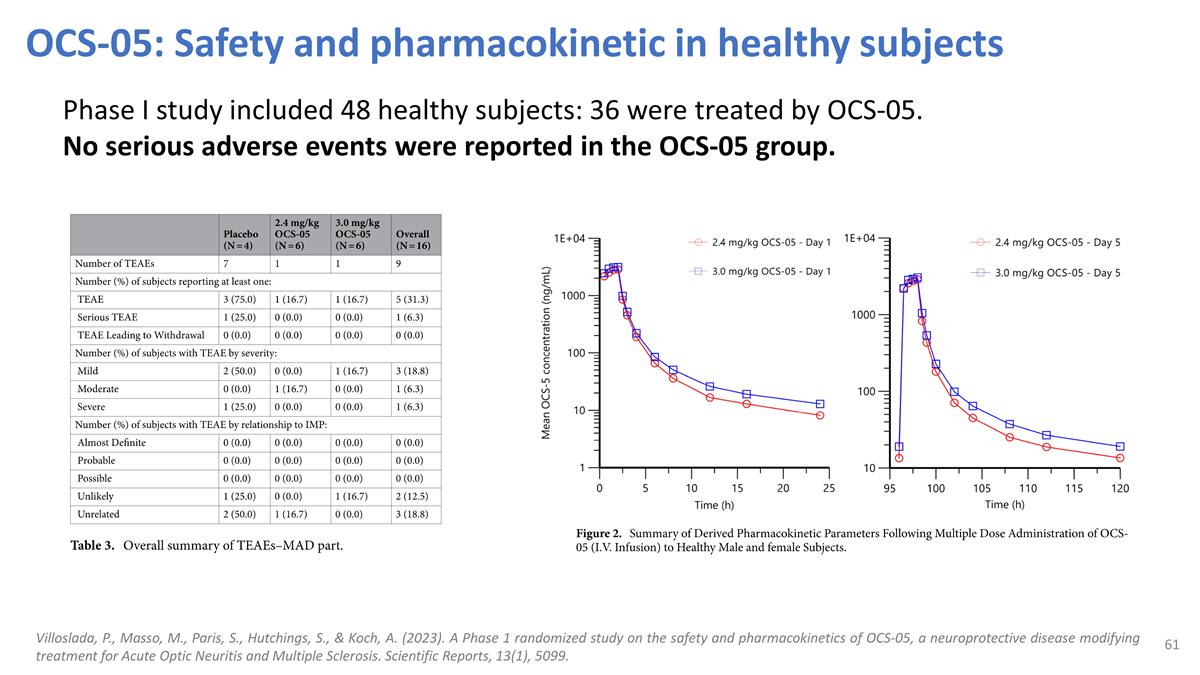
OCS-05: Safety and pharmacokinetic in healthy subjects Phase I study included 48 healthy subjects: 36 were treated by OCS-05. No serious adverse events were reported in the OCS‐05 group. Villoslada, P., Masso, M., Paris, S., Hutchings, S., & Koch, A. (2023). A Phase 1 randomized study on the safety and pharmacokinetics of OCS-05, a neuroprotective disease modifying treatment for Acute Optic Neuritis and Multiple Sclerosis. Scientific Reports, 13(1), 5099.
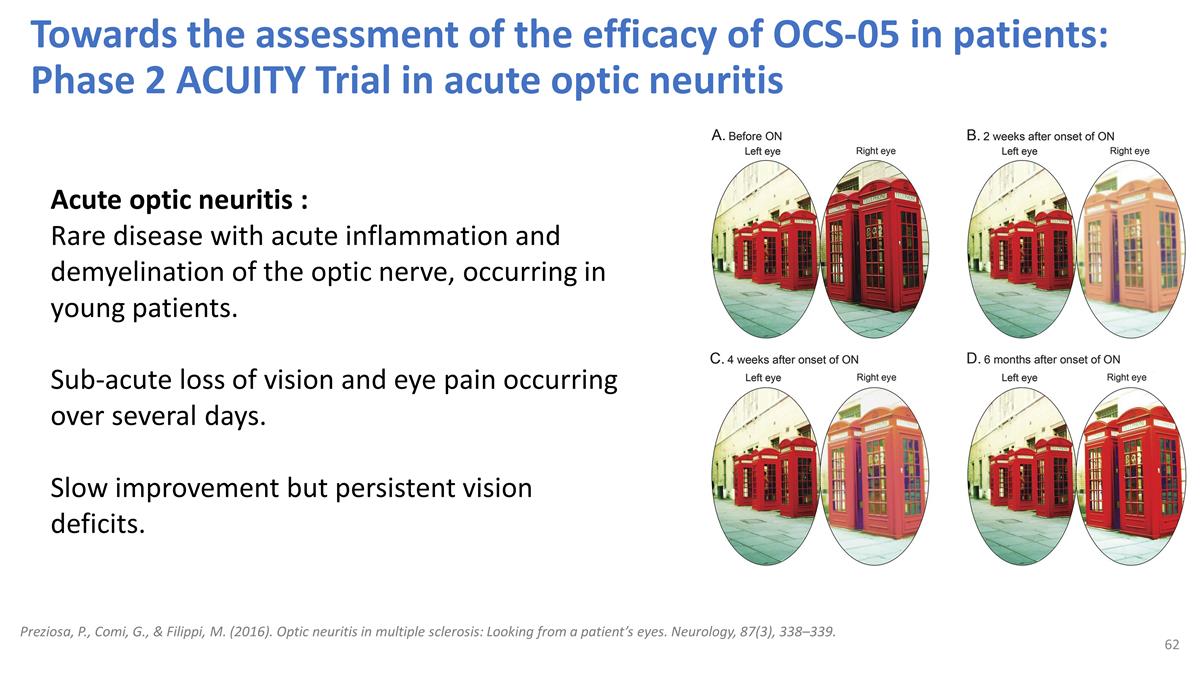
Preziosa, P., Comi, G., & Filippi, M. (2016). Optic neuritis in multiple sclerosis: Looking from a patient’s eyes. Neurology, 87(3), 338–339. Towards the assessment of the efficacy of OCS-05 in patients: Phase 2 ACUITY Trial in acute optic neuritis Acute optic neuritis : Rare disease with acute inflammation and demyelination of the optic nerve, occurring in young patients. Sub-acute loss of vision and eye pain occurring over several days. Slow improvement but persistent vision deficits.
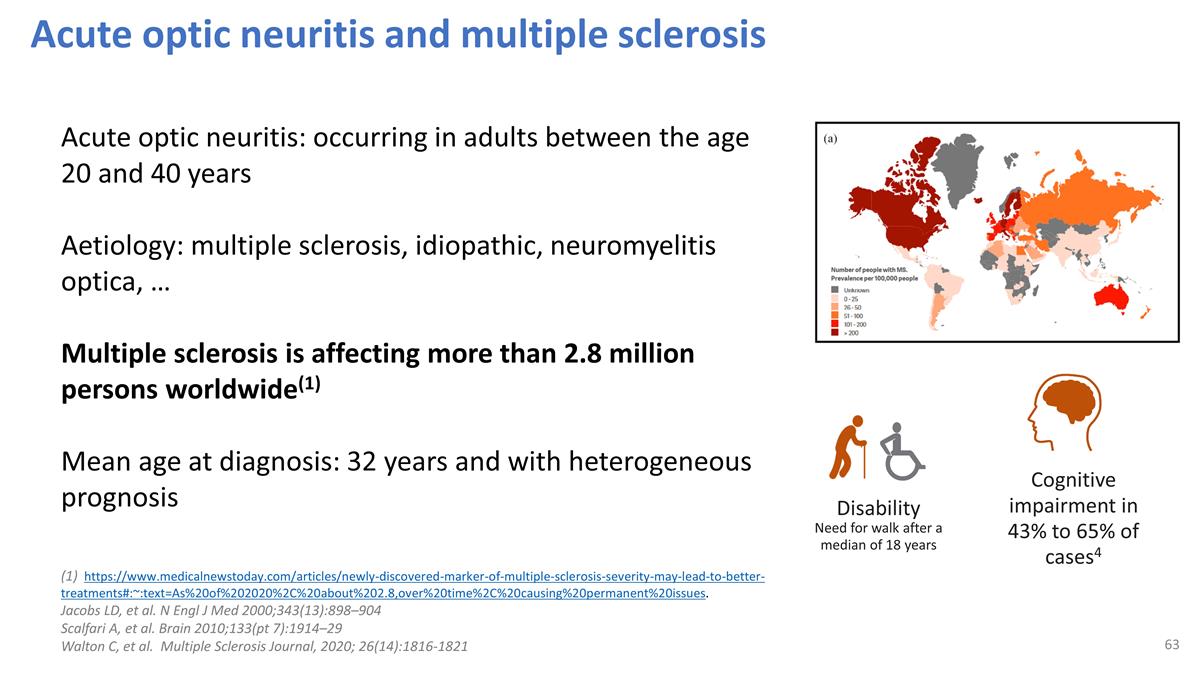
Acute optic neuritis and multiple sclerosis Acute optic neuritis: occurring in adults between the age 20 and 40 years Aetiology: multiple sclerosis, idiopathic, neuromyelitis optica, … Multiple sclerosis is affecting more than 2.8 million persons worldwide(1) Mean age at diagnosis: 32 years and with heterogeneous prognosis (1) https://www.medicalnewstoday.com/articles/newly-discovered-marker-of-multiple-sclerosis-severity-may-lead-to-better-treatments#:~:text=As%20of%202020%2C%20about%202.8,over%20time%2C%20causing%20permanent%20issues. Jacobs LD, et al. N Engl J Med 2000;343(13):898–904 Scalfari A, et al. Brain 2010;133(pt 7):1914–29 Walton C, et al. Multiple Sclerosis Journal, 2020; 26(14):1816-1821 é Cognitive impairment in 43% to 65% of cases4 Disability Need for walk after a median of 18 years
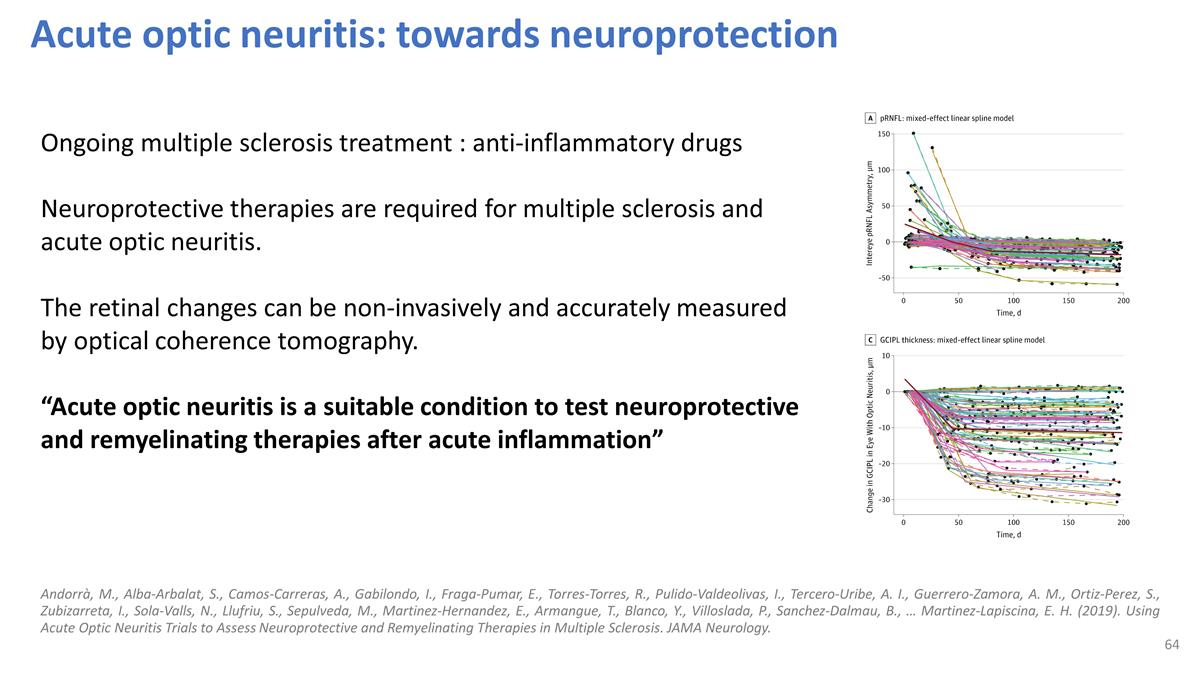
Acute optic neuritis: towards neuroprotection Ongoing multiple sclerosis treatment : anti-inflammatory drugs Neuroprotective therapies are required for multiple sclerosis and acute optic neuritis. The retinal changes can be non-invasively and accurately measured by optical coherence tomography. “Acute optic neuritis is a suitable condition to test neuroprotective and remyelinating therapies after acute inflammation” Andorrà, M., Alba-Arbalat, S., Camos-Carreras, A., Gabilondo, I., Fraga-Pumar, E., Torres-Torres, R., Pulido-Valdeolivas, I., Tercero-Uribe, A. I., Guerrero-Zamora, A. M., Ortiz-Perez, S., Zubizarreta, I., Sola-Valls, N., Llufriu, S., Sepulveda, M., Martinez-Hernandez, E., Armangue, T., Blanco, Y., Villoslada, P., Sanchez-Dalmau, B., … Martinez-Lapiscina, E. H. (2019). Using Acute Optic Neuritis Trials to Assess Neuroprotective and Remyelinating Therapies in Multiple Sclerosis. JAMA Neurology.
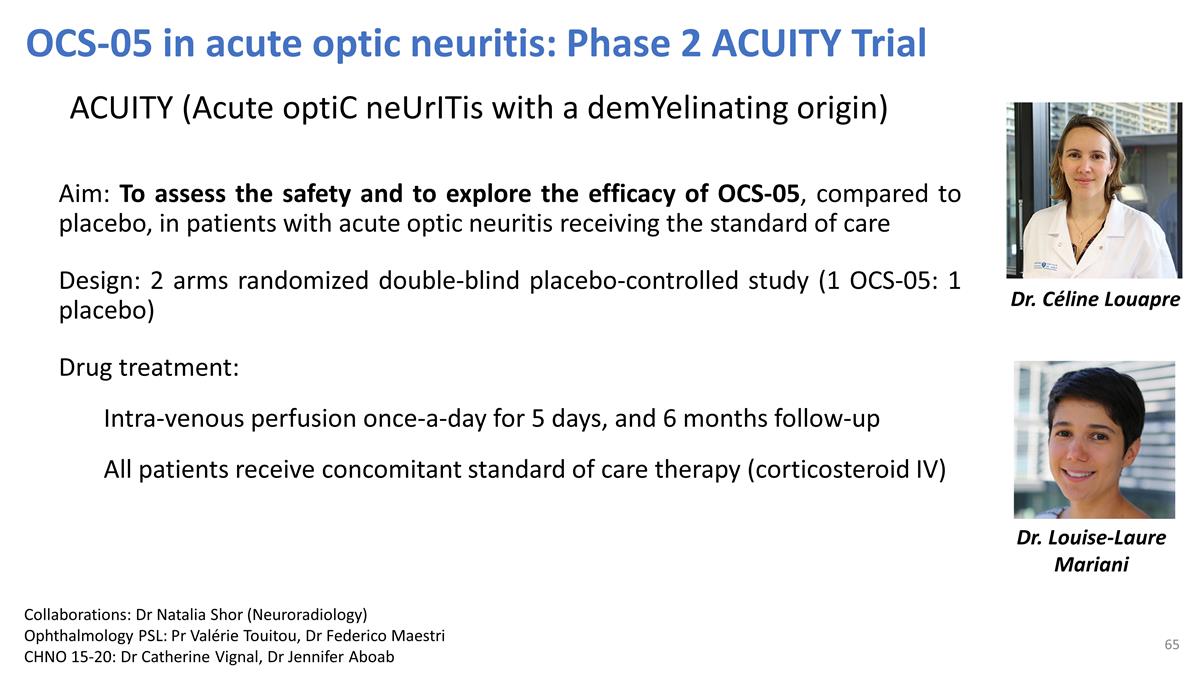
ACUITY (Acute optiC neUrITis with a demYelinating origin) Aim: To assess the safety and to explore the efficacy of OCS-05, compared to placebo, in patients with acute optic neuritis receiving the standard of care Design: 2 arms randomized double-blind placebo-controlled study (1 OCS-05: 1 placebo) Drug treatment: Intra-venous perfusion once-a-day for 5 days, and 6 months follow-up All patients receive concomitant standard of care therapy (corticosteroid IV) OCS-05 in acute optic neuritis: Phase 2 ACUITY Trial Dr. Céline Louapre Dr. Louise-Laure Mariani Collaborations: Dr Natalia Shor (Neuroradiology) Ophthalmology PSL: Pr Valérie Touitou, Dr Federico Maestri CHNO 15-20: Dr Catherine Vignal, Dr Jennifer Aboab
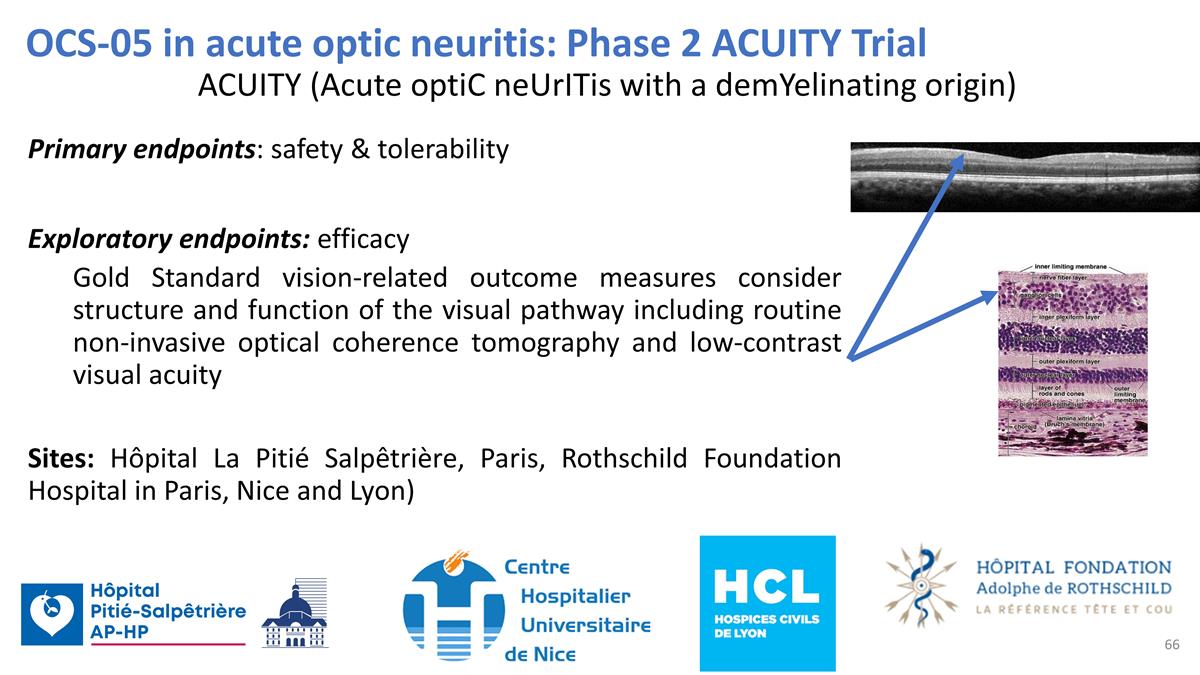
ACUITY (Acute optiC neUrITis with a demYelinating origin) Primary endpoints: safety & tolerability Exploratory endpoints: efficacy Gold Standard vision-related outcome measures consider structure and function of the visual pathway including routine non-invasive optical coherence tomography and low-contrast visual acuity Sites: Hôpital La Pitié Salpêtrière, Paris, Rothschild Foundation Hospital in Paris, Nice and Lyon) OCS-05 in acute optic neuritis: Phase 2 ACUITY Trial
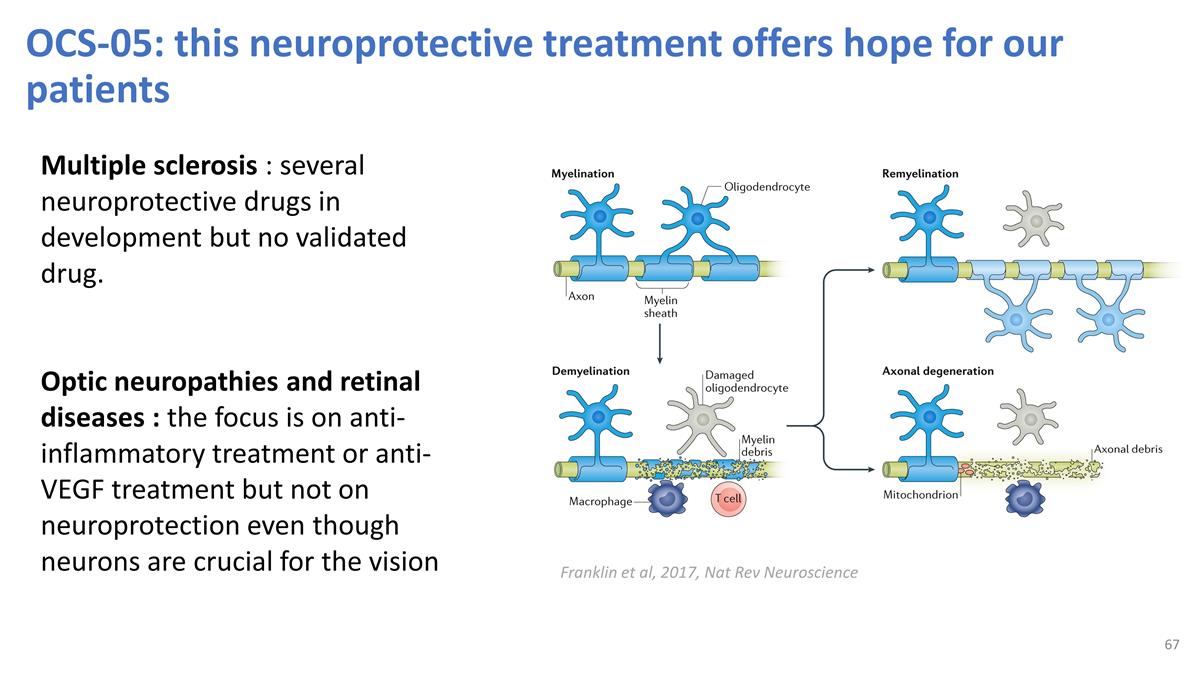
OCS-05: this neuroprotective treatment offers hope for our patients Multiple sclerosis : several neuroprotective drugs in development but no validated drug. Optic neuropathies and retinal diseases : the focus is on anti-inflammatory treatment or anti-VEGF treatment but not on neuroprotection even though neurons are crucial for the vision Franklin et al, 2017, Nat Rev Neuroscience
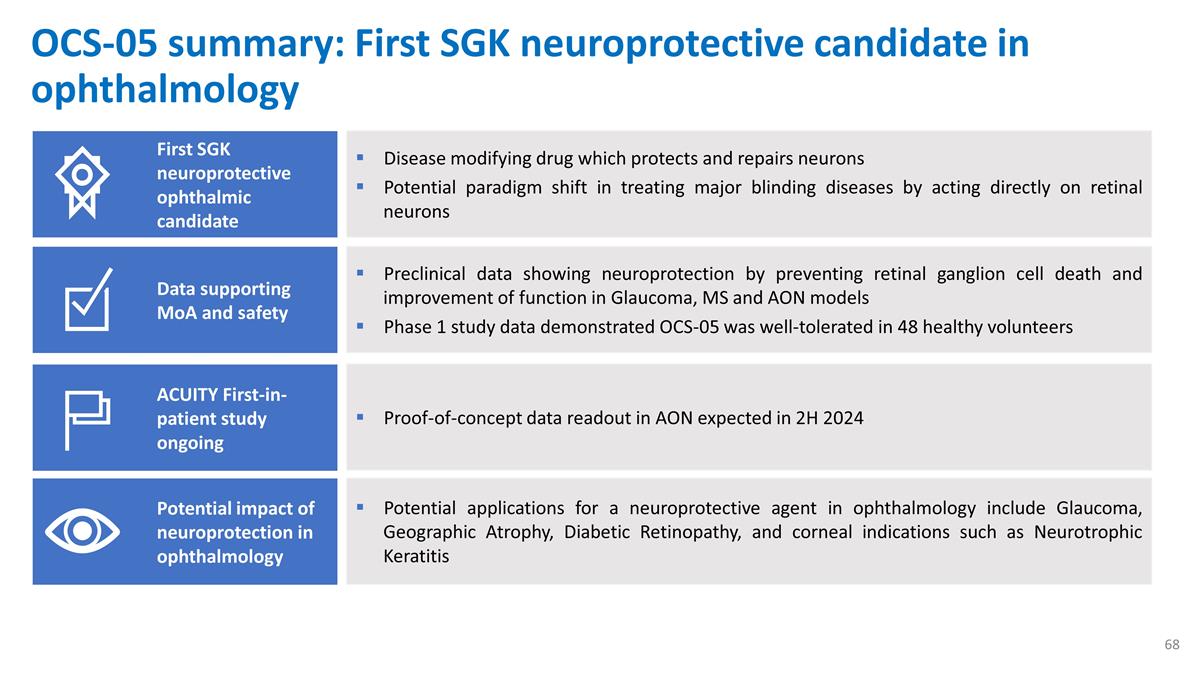
OCS-05 summary: First SGK neuroprotective candidate in ophthalmology ACUITY First-in-patient study ongoing Data supporting MoA and safety First SGK neuroprotective ophthalmic candidate Disease modifying drug which protects and repairs neurons Potential paradigm shift in treating major blinding diseases by acting directly on retinal neurons Preclinical data showing neuroprotection by preventing retinal ganglion cell death and improvement of function in Glaucoma, MS and AON models Phase 1 study data demonstrated OCS-05 was well-tolerated in 48 healthy volunteers Proof-of-concept data readout in AON expected in 2H 2024 Potential impact of neuroprotection in ophthalmology Potential applications for a neuroprotective agent in ophthalmology include Glaucoma, Geographic Atrophy, Diabetic Retinopathy, and corneal indications such as Neurotrophic Keratitis
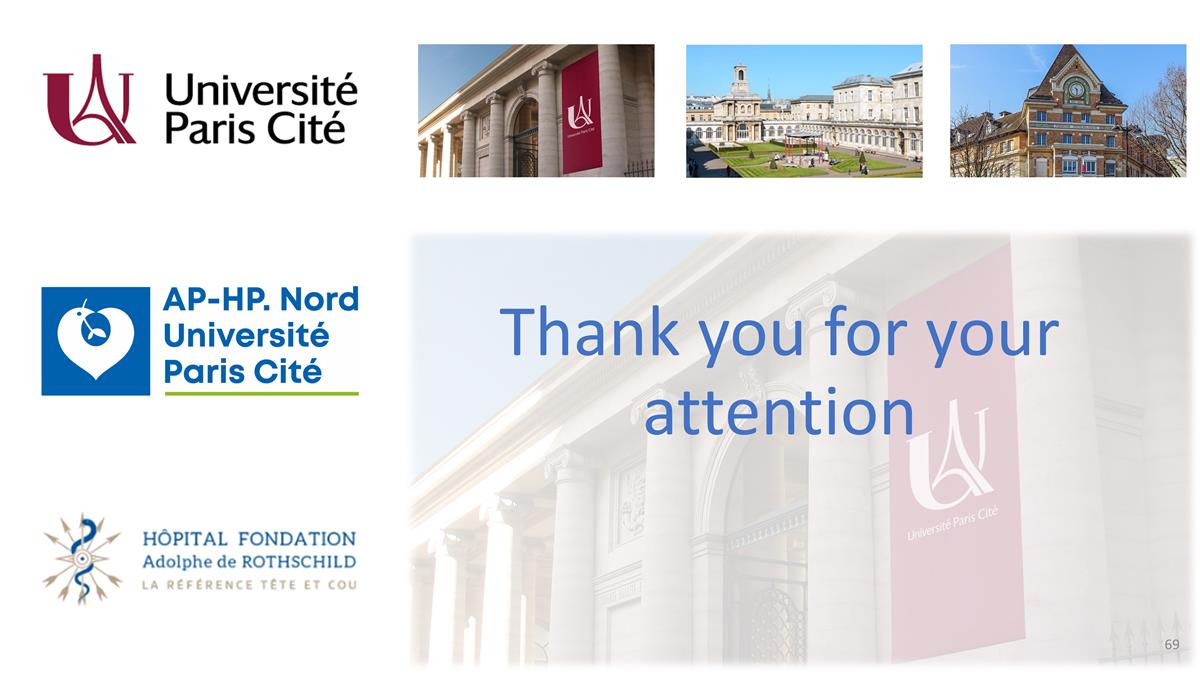
Thank you for your attention
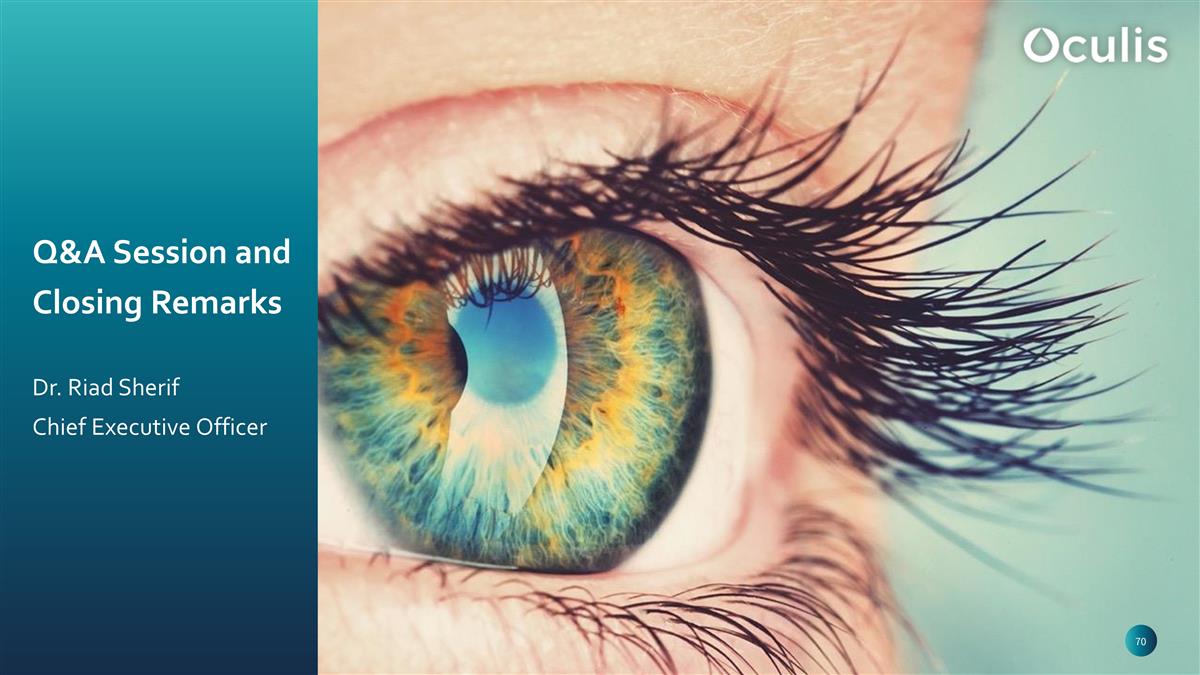
Q&A Session and Closing Remarks Dr. Riad Sherif Chief Executive Officer
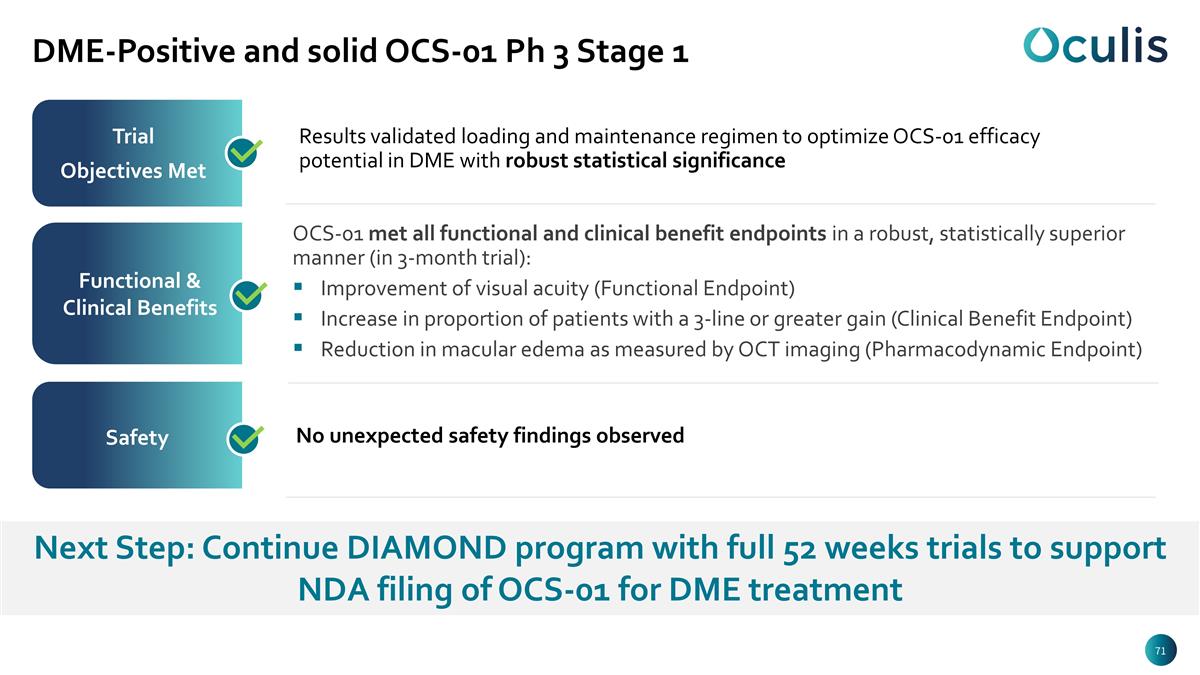
Results validated loading and maintenance regimen to optimize OCS-01 efficacy potential in DME with robust statistical significance OCS-01 met all functional and clinical benefit endpoints in a robust, statistically superior manner (in 3-month trial): Improvement of visual acuity (Functional Endpoint) Increase in proportion of patients with a 3-line or greater gain (Clinical Benefit Endpoint) Reduction in macular edema as measured by OCT imaging (Pharmacodynamic Endpoint) No unexpected safety findings observed Trial Objectives Met Functional & Clinical Benefits Safety Next Step: Continue DIAMOND program with full 52 weeks trials to support NDA filing of OCS-01 for DME treatment DME-Positive and solid OCS-01 Ph 3 Stage 1
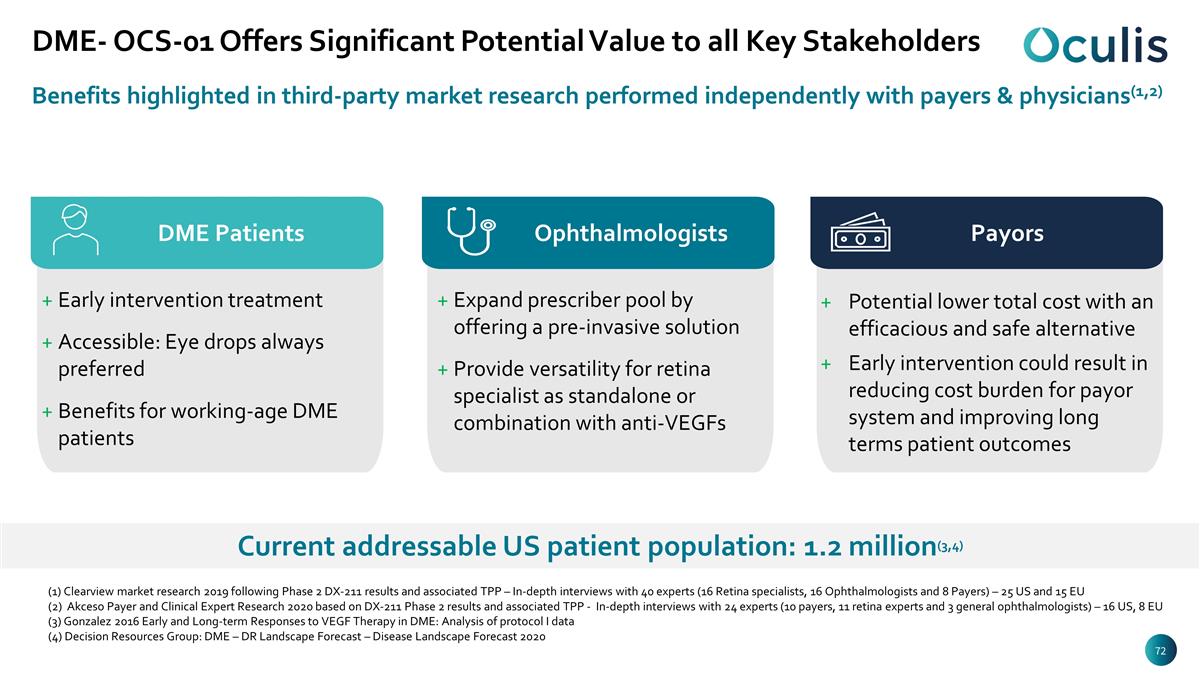
Benefits highlighted in third-party market research performed independently with payers & physicians(1,2) Ophthalmologists DME Patients Payors Potential lower total cost with an efficacious and safe alternative Early intervention could result in reducing cost burden for payor system and improving long terms patient outcomes Expand prescriber pool by offering a pre-invasive solution Provide versatility for retina specialist as standalone or combination with anti-VEGFs Early intervention treatment Accessible: Eye drops always preferred Benefits for working-age DME patients Current addressable US patient population: 1.2 million(3,4) (1) Clearview market research 2019 following Phase 2 DX-211 results and associated TPP – In-depth interviews with 40 experts (16 Retina specialists, 16 Ophthalmologists and 8 Payers) – 25 US and 15 EU (2) Akceso Payer and Clinical Expert Research 2020 based on DX-211 Phase 2 results and associated TPP - In-depth interviews with 24 experts (10 payers, 11 retina experts and 3 general ophthalmologists) – 16 US, 8 EU (3) Gonzalez 2016 Early and Long-term Responses to VEGF Therapy in DME: Analysis of protocol I data (4) Decision Resources Group: DME – DR Landscape Forecast – Disease Landscape Forecast 2020 DME- OCS-01 Offers Significant Potential Value to all Key Stakeholders
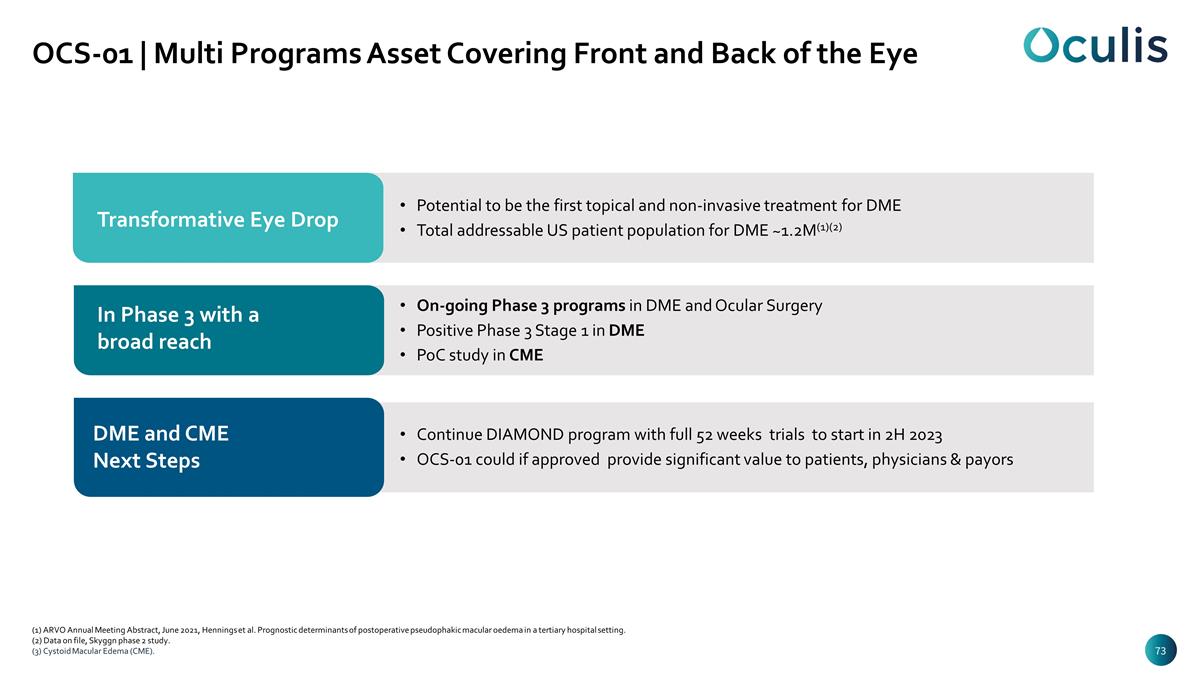
OCS-01 | Multi Programs Asset Covering Front and Back of the Eye (1) ARVO Annual Meeting Abstract, June 2021, Hennings et al. Prognostic determinants of postoperative pseudophakic macular oedema in a tertiary hospital setting. (2) Data on file, Skyggn phase 2 study. (3) Cystoid Macular Edema (CME). Transformative Eye Drop Potential to be the first topical and non-invasive treatment for DME Total addressable US patient population for DME ~1.2M(1)(2) In Phase 3 with a broad reach On-going Phase 3 programs in DME and Ocular Surgery Positive Phase 3 Stage 1 in DME PoC study in CME DME and CME Next Steps Continue DIAMOND program with full 52 weeks trials to start in 2H 2023 OCS-01 could if approved provide significant value to patients, physicians & payors
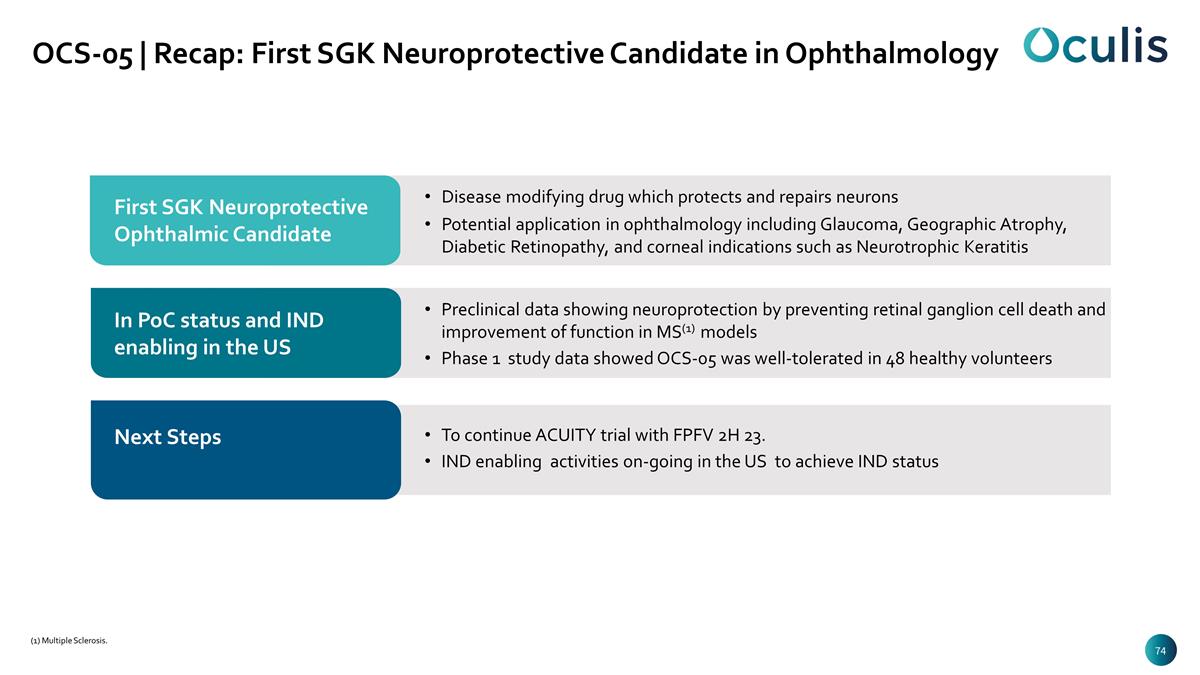
(1) Multiple Sclerosis. OCS-05 | Recap: First SGK Neuroprotective Candidate in Ophthalmology First SGK Neuroprotective Ophthalmic Candidate Disease modifying drug which protects and repairs neurons Potential application in ophthalmology including Glaucoma, Geographic Atrophy, Diabetic Retinopathy, and corneal indications such as Neurotrophic Keratitis In PoC status and IND enabling in the US Next Steps To continue ACUITY trial with FPFV 2H 23. IND enabling activities on-going in the US to achieve IND status Preclinical data showing neuroprotection by preventing retinal ganglion cell death and improvement of function in MS(1) models Phase 1 study data showed OCS-05 was well-tolerated in 48 healthy volunteers
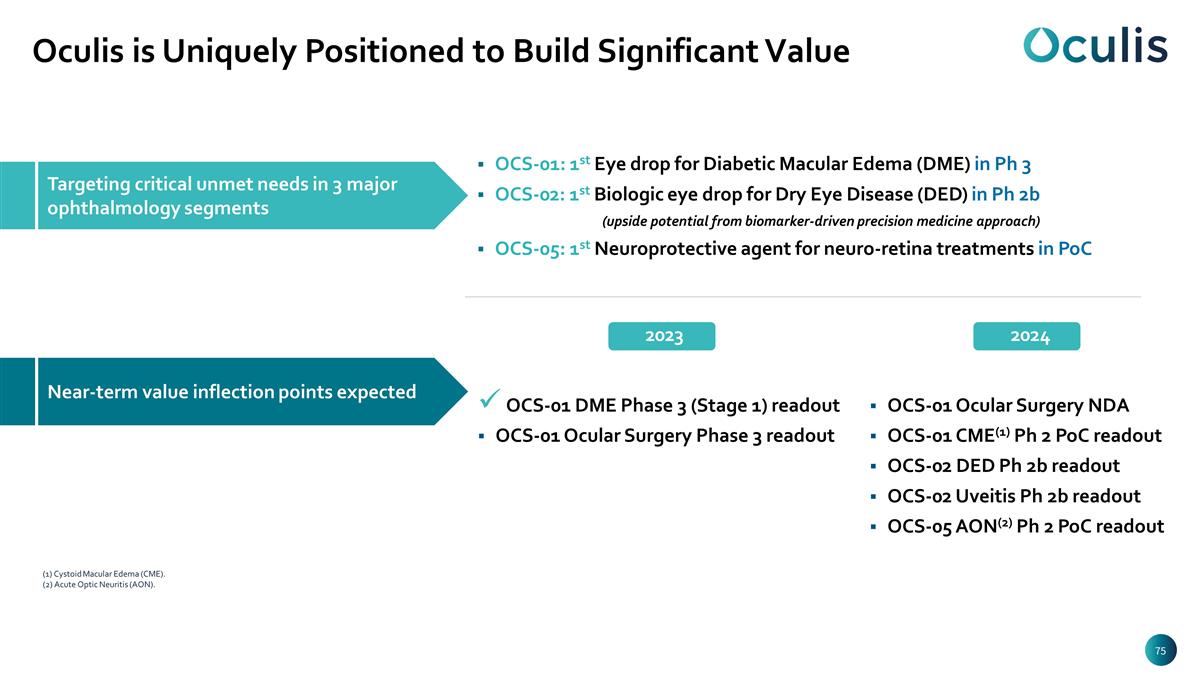
Oculis is Uniquely Positioned to Build Significant Value Targeting critical unmet needs in 3 major ophthalmology segments Near-term value inflection points expected (1) Cystoid Macular Edema (CME). (2) Acute Optic Neuritis (AON). OCS-01: 1st Eye drop for Diabetic Macular Edema (DME) in Ph 3 OCS-02: 1st Biologic eye drop for Dry Eye Disease (DED) in Ph 2b (upside potential from biomarker-driven precision medicine approach) OCS-05: 1st Neuroprotective agent for neuro-retina treatments in PoC 2023 2024 OCS-01 DME Phase 3 (Stage 1) readout OCS-01 Ocular Surgery Phase 3 readout OCS-01 Ocular Surgery NDA OCS-01 CME(1) Ph 2 PoC readout OCS-02 DED Ph 2b readout OCS-02 Uveitis Ph 2b readout OCS-05 AON(2) Ph 2 PoC readout

To drive innovation to save sight and improve eye care Our Purpose